2008 World Dive Guide
| Caribbean Sea & Atlantic Ocean Bahamas Bay Islands, Honduras Belize Bermuda Bonaire British Virgin Islands Cayman Islands Cozumel, Mexico | Curaçao Dominica Eastern Caribbean Florida Keys North Carolina Puerto Rico Riviera Maya, Mexico Turks & Caicos U.S. Virgin Islands | Pacific & Indian Oceans Australia Baja California, Mexico Costa Rica Fiji French Polynesia Galapagos Hawaii Indonesia Micronesia Papua New Guinea |
||||
|---|---|---|
|

|
| Photo by Stephen Frink|
For many American divers, the waters of the Atlantic Ocean and Caribbean Sea serve as the initiation into the sport's fellowship. Stretching from America's eastern seaboard to the Venezuelan Gulf, and encompassing everything from North Carolina's and Bermuda's historic wrecks and the Florida Keys' abundant life to Bonaire's bounty and Tobago's high voltage thrill dives, the Atlantic and Caribbean regions are like the proverbial candy stores for wide-eyed kids.
It also doesn't hurt to have endless lush, tropical islands to play around on before and after diving--and the fascinating blend of cultures fused together by history's harsh realities. So where to dive in? Read on to make discoveries about your favorite spot, or be tantalized by alluring new ones that will inspire daydreams.
Bahamas
||
|---|
|

|
| Photo by Stephen Frink|
Some 30 years ago an unlikely source helped put the Bahamas on the world's dive radar--Bond. James Bond. The island of New Providence and the capital city of Nassau have been the backdrop for many films featuring the British super-spy, and the man behind many of the in-water stunts, from sinking wrecks to wrangling sharks, was dive pioneer Stuart Cove. The good news for divers is that you don't need double-O status to find dive adventure in the 700-plus islands of the Bahamas. All you need is a C-card.
With all these options, you'll need to make some choices. The first is whether to follow the crowds to the major tourist islands--New Providence and Grand Bahama--or search for a quieter ideal in the more remote Out Islands. Here's an overview of what to expect on the best-loved dive islands.
New Providence: From its southwest corner, you're only a short boat ride away from dramatic wall dives on the 6,000-foot-deep Tongue of the Ocean. There are also shallow reefs and a host of wreck dives, but the hottest ticket going is shark diving, says Cove. At sites like Shark Wall/Shark Arena, expect to see as many as 40 Caribbean reef sharks on a single tank.
Grand Bahama: The island is commonly known by the name of its major city, Freeport. But no matter what you call it, don't miss its shallow- to medium-depth reefs, several excellent wrecks and--on specially guided tours--freshwater caverns like Ben's Cave in the Lucayan National Park.
The Abacos: This horseshoe-shaped group of islands offers several popular dive ports, including Marsh Harbour and Green Turtle Cay. Shallow, sunlit coral gardens make the area popular with new divers, while history buffs enjoy exploring the remains of the San Jacinto, the first steamship ever built in the U.S.
||
|---|
|

|
| Photo by Stephen Frink|
Andros: This large, barely populated island offers deep wall diving and the mammoth Ocean Blue Hole, where spooky haloclines separating blue seawater and green fresh water add drama to craggy rock formations.
Bimini: Just 55 miles east of downtown Miami, Bimini sits on the edge of the Gulf Stream, so anything can happen underwater--and usually does. Come for the active shallow reefs and deep drop-offs, stay for the thrill of snorkeling with wild pods of spotted dolphins.
Cat Island: Remote shallow reefs and wall diving that have barely been touched await divers on this island in the central Bahamas.
Eleuthera and Harbour Island: You'll find wrecks, reefs and inland blue holes, but the signature dive is the Current Cut--at 8 to 12 knots, it's the fastest drift dive in the Caribbean.
The Exumas: A popular live-aboard destination, this long string of islands is fronted by shallow reefs and ocean blue holes.
Long Island: Here you'll find a little bit of everything: shark diving, reefs, wrecks and day trips to the deep walls of Rum Cay and Conception Island.
San Salvador: This island offers amazing sheer vertical walls, peak visibility and a better-than-average chance of encounters with big pelagics.
|||
|---|---|
| Snapshot

|
Dive Conditions: Water temps are in the 70s in winter; high 80s in summer. Vis averages 80 to 100 feet.
Weather: 70s to 80s in winter; mid- to high 80s in summer.
Money Matters: In the February to April high season, seven-night accommodation and diving packages (meals not included) on New Providence and Grand Bahama range from $775 p.p., dbl. occ., in a budget hotel to $2,500 p.p., dbl. occ., in a luxury resort. In the Out Islands, seven-night live-aboard cruises, including accommodation, meals and diving, run from $1,295 to $1,795 p.p., dbl. occ. Seven-night land packages, including accommodation, meals and diving, range from a budget-friendly $1,000 p.p., dbl. occ., to $4,000 p.p., dbl. occ., with a lot of extras. The Bahamian dollar (B$) is equal in value to the U.S. dollar and the two are used interchangeably. The departure tax is $15 from New Providence and the Out Islands; $18 from Grand Bahama.
Get More: scubadiving.com/travel/caribbeanatlantic/bahamas
Getting There: Nonstop flight time from Miami to Nassau/Paradise Island (NAS) and Freeport, Grand Bahama (FPO) is about 35 minutes. Nonstop flights are also available from other U.S. gateways, including Charlotte and Philadelphia. Nassau is the chief gateway to the Out Islands, with Bahamasair serving them all.
Bay Islands
From the massive whale sharks of Utila to the huge crack in the reef at Mary's Place on Roatan; from Guanaja's Jado Trader to the Caribbean reef sharks of Cara a Cara Point, Honduras's Bay Islands have long been noted for the great variety of dive experiences they offer. They've got wrecks, walls, reefs and animal encounters. If you're looking for something special, you don't have to look any farther than the Bay Islands.
The vast majority of reefline around Roatan lies close offshore and follows the contours of the island's coastline. Cara a Cara Point, however, juts out at a right angle from the south shore. Thanks to its proximity to deep water, the point is a favorite hangout of Caribbean reef sharks.
The 300-foot Odyssey was sunk in 2002 off Roatan's north shore. The top of the bow is at 70 feet and the stern is resting on the sand at 110 feet. You can explore the intact stairwells of the stern accommodation quarters, where you'll find barracuda, jacks and parrotfish.
Gold Chain Reef on Roatan's south coast "is covered in staghorn coral and is filled with colorful tropical fish," says Patty Grier of Dockside Dive Center. "From there, you can get to my little secret spot. If you head west from the mooring at this site--a 20-minute swim--the wall begins to curve to the south and you'll find several reverse ledges and narrow crevices. Usually, these are filled with silversides."
Mary's Place, one of the most popular dive sites on Roatan, is "a spectacular cut in the wall as wide as 12 feet in places," says Patrick Zingg, of Subway Watersports. At some points during the day, sunlight streams into the crevice, illuminating the colors of the reef; at other times, low light creates an eerie mood.
Off the southern shore of Utila, an underwater mountain rises from the seafloor, stopping just 35 feet short of breaking the surface and becoming an island. "The Black Hills seamounts feature lots of fish, turtles and a beautiful reef," says Billy Hale, of Utila Lodge. Drop down deep over the side of the seamount at Black Hills to start your dive and then work your way around and back toward the top. "My secret spot," says Hale, "is Airport Caves, two caves that everyone thinks are blind caves, but they're not. You swim in and when you get to the sandbar, you can swim up and over into the back of the cave, follow it around and come out a different opening."
Deep Blue's Steve Fox also recommends Duppy Waters, on the eastern edge of Turtle Harbour, "a site that has enormous barrel sponges and a beautiful reef to explore."
Utila is still at the top of the list of Caribbean whale shark hot spots. The biggest fish in the sea congregate around the banks north of the island and may be encountered year-round, though the sightings occur most dependably March through May, and August through October.
|||
|---|---|
| Snapshot

|
Dive Conditions: Water temps are in the high 70s in winter; low 80s in summer. Vis averages 60 feet.
Weather: Mid-80s; can be cooler during winter storms. The rainy season runs from December through January.
Money Matters: Seven-night packages, including accommodation, diving and meals, range from $799 p.p., dbl. occ., to $1,199 p.p., dbl. occ., in low season; $999 p.p., dbl. occ., to $1,499 p.p., dbl. occ., in high season. Currency is the Honduran lempira (HNL); exchange rate fluctuates, but U.S. dollars are widely accepted. Departure tax is about $34.
Get More: scubadiving.com/travel/caribbeanatlantic/bay_islands
Getting There: There are nonstop flights from Atlanta, Newark, Miami and Houston to Roatan (RTB). There are also nonstop flights from U.S. gateways to San Pedro Sula (SAP) on the mainland; from San Pedro Sula there are connections to Roatan, Utila and Guanaja.
Belize
||||
|---|---|---|
|

|
| Photo by Stephen Frink|
Belize--one of the smallest countries in Central America--packs a lot within its borders, from the hemisphere's longest reef and the amazing Blue Hole to whale sharks, atolls, Mayan ruins and jungle trekking.
Deciding where to stay in Belize is harder than it seems--your choices range from the quaint ambience of San Pedro on Ambergris Caye to the dive-only atolls to the nature-loving South.
The barrier reef off Ambergris Caye starts five miles north of the Mexican border and is so near shore that dive sites are only five minutes away. "Hol Chan and Shark Ray Alley are our most popular dives, and for good reason," says Karen Waight-Canul, of Ambergris Divers. "These sites are great examples of why areas are protected."
Experienced divers like to visit Hol Chan Cut: Strong tidal currents make it tricky to dive this site, but also supply food to filter feeders such as sea fans, sponges and gorgonians and to fish like grunts and mutton snappers. Divers stay close to the channel sides where irregularities in the walls blunt much of the current's strength.
Three of the four true atolls in the hemisphere--Lighthouse Reef, Turneffe Islands and Glover's Reef--lie 30 to 60 miles off the mainland, beyond the immense barrier reef, and offer fish- and coral-packed walls that plummet 3,000 feet below. Ranked among Belize's best wall dives, the Elbow at Turneffe's southern tip is a busy intersection of currents and big fish; you'll see schools of jacks, permit and barrel sponges. The walls at Lighthouse Reef's Half Moon Caye are shot through with innumerable tunnels and swim-throughs and packed with huge barrel and tube sponges, yellowtail snappers, eagle rays and garden eels.
||
|---|
|

|
| Photo by Stephen Frink|
"The best-kept dive secret is Hell Hole," says Dana Krauskopf, co-owner of Hamanasi Resort, near Hopkins. "A hole in the sand floor opens into a collapsed cave. You need dive lights. There are some stalactites, and nurse sharks come out of there. We only take experienced divers there."
Gladden Spit, near Placencia, is a hot spot for whale shark encounters between March and June. Placencia dive operators take small groups of divers to this reserve, where whale sharks, drawn by spawning dog and cubera snappers, come in search of an easy meal.
|||
|---|---|
| Snapshot

|
Dive Conditions: Water temps are in the mid-70s in winter; low 80s in summer. Vis can reach 100 feet around the outer atolls; inside the barrier reef, vis is 50 to 75 feet.
Weather: Mid-70s in winter; 80s in summer. The rainy season is June through October.
Money Matters: Seven-night live-aboard trips, including accommodation, meals and diving, start from $2,195 p.p., dbl. occ. Seven-night land packages, including accomodation, meals and diving, range from $1,000 p.p., dbl. occ., to $2,300 p.p., dbl. occ. Currency is the Belize dollar (BZ$); exchange rate is fixed at BZ$2 to US$1. Departure tax is about $35.
Get More: scubadiving.com/travel/caribbeanatlantic/belize
Getting There: There are nonstop flights to Belize City (BZE) on many carriers from Atlanta, Charlotte, Dallas/Ft. Worth, Houston, Miami, and Newark. From Belize City, connections can be made to Ambergris Caye, Caye Caulker, Dangriga, Placencia and Punta Gorda.
Bermuda
||
|---|
|

|
| Photo by Carlos Villoch|
The water around this mid-Atlantic island has historically been a ship magnet. We're talking about accidents. Lots of 'em. Name the country and if it has a ship registered, it likely has at least one that sank in Bermudian waters after smashing into the reefs ringing the island. And with more than 300 known shipwrecks--large, small and in between and from warships and schooners to frigates and freighters--Bermuda has a built-in claim to diving fame.
"We're the wreck capital of the Atlantic," says Kevin Luton, of Dive Bermuda. "It would take forever to dive them all."
The folks at Triangle Diving suggest the King George, a 171-foot dredger scuttled in the 1930s, fully intact at 60 feet and teeming with fish life and a stunning array of soft corals. Luton suggests the Hermes, another wreck that was purposely sunk, and is the island's most popular dive. She's resting at 80 feet and great visibility there gives divers the chance to explore her from engines and deck winch to propeller and pilothouse. Civil War buffs flock to the Marie Celeste, a paddlewheel steamer the Confederate Navy converted into a blockade-runner and the Pelinaion is a 385-foot beast of a cargo vessel with enormous, intact parts of her anatomy.
And though Bermuda isn't known for its reefs, it still boasts nearly 300 square miles of them, where you can find indigenous black groupers, tarpon from September through March and even an "undertaker"--an invertebrate better known as the black sea hare. Cathedral features a great swim-through cave with thousands of glassy sweepers, while Hangover Hole has tunnels, arches and tons of animal life. Luton says cave diving in Bermuda's inland is also catching on.
Bermuda's dive season parallels the U.S. East Coast's. Topside, renting a motorbike or buying a bus pass is a great way to visit small towns, historic forts and golf courses.
|||
|---|---|
| Snapshot

|
Dive Conditions: Water temps are in the mid-60s in winter; high 70s to mid-80s in summer. Vis averages 70 to 100 feet.
Weather: 60s to 70s in winter; mid-70s to mid-80s in summer.
Money Matters: On average, one-week packages to Bermuda, including airfare from the U.S. East Coast, accommodations at a dive resort and diving, run about $1,600. Currency is the Bermuda dollar (BD$); it's pegged to the U.S. dollar. Departure tax is usually included in airline ticket prices.
Get More: scubadiving.com/travel/caribbeanatlantic/bermuda
Getting There: Traveling to Bermuda is a snap, with Jet Blue, US Airways, Delta, United, Continental, American and Air Canada all flying nonstop to Hamilton (BDA) from multiple North American gateways.
Bonaire
Quaint, colorful Dutch architecture, friendly people and easy, 24-hour shore diving all combine to make Bonaire one of those rare destinations that nitrogen junkies return to year after year. In the time it takes to say bon bini--the local term for welcome--you'll fall in love with this charmer, which is, with Curaçao and Aruba, one of the trio of Netherlands Antilles islands just north of Venezuela.
Make just one dive underwater and you'll know why the island is a favorite among divers. The majority of Bonaire's pristine reefs, protected as a marine park for more than 30 years, are accessible from shore. The leeward side is the calmest, though the sites farther north or south of the capital city of Kralendijk are more challenging. Typically, Bonaire's small beaches continue under water in sandy plains dotted with a few corals that slope down to 30 feet. The reef drops off gradually to another sandy plain at about 140 feet. Dive resorts make tanks available 24 hours a day for shore diving among the island's 60-plus dive sites. Get a rental truck, fill it with tanks and dive gear and pick one.
If you prefer, most sites can be accessed by boat, and dive operators also offer daily two-tank dives at Klein Bonaire, an uninhabited island off Kralendijk that boasts nearly two dozen sites of its own.
Some of the best dives on Bonaire require neither a boat nor a car--they're found right off the dock of your waterfront dive resort. If you're a guest, you can suit up and wade in any time the mood strikes. At Plaza Resort, drop down on 18th Palm to find small terraces of scattered coral heads, tube sponges and elephant ear sponges. Bari Reef, off Sand Dollar Resort, is a gently sloping terrace renowned for its prolific fish life. La Machaca, the house reef at Capt. Don's Habitat, is named after the small fishing boat that rests in 40 feet of water. Buddy Dive Resort's house reef features a slope that starts in about 30 feet of water and drops off to a sand bottom at 100. Divi Flamingo's Calabas Reef has a small boat to explore at about 70 feet. Just off Harbour Resort's beach, the Our Confidence is a wooden-hulled freighter that's home to turtles and eels.
Bonus: A line leads from the wreck to an adjacent reef called Something Special, one of Bonaire's best sites, according to marine biologist Anna DeLoach of Reef Environmental Education Foundation. "We have never been disappointed at this site," DeLoach says. "It offers plenty of fish life on a shallow sand and rubble shelf that slopes down to 100 feet." Public access is about 200 feet south of the resort.
The sites just south of Kralendijk include the island's biggest wreck, the Hilma Hooker, a 236-foot-long freighter lying on its side in 100 feet of water. The underside is coated with orange cup corals and tube sponges. Angel City, a double reef system, is between the Hooker and another site, Alice in Wonderland. Angel City gets its name from the ubiquitous angelfish found here, but there's plenty more to see.
North of Kralendijk you'll experience Bonaire's wild northwestern coast. Here's where you'll find the famed site 1,000 Steps. This dive begins from a pretty, sheltered cove. The shallow shelf is covered with corals and is alive with fish. You'll spot blue tangs, snappers and goatfish in large numbers.
Recently, experienced divers have been heading to sites off Bonaire's east coast, like White Hole and Cai, where tarpon and rays hang out. "East side diving--when the weather is right--offers an adventure and something different from the west coast," says Mieke Hermans, of Wannadive Bonaire.
Conservation-minded Bonaire is also becoming known for other adventure activities. "One of the most common misperceptions about the island is that there's nothing else to do but dive," says Hermans. "But that's wrong--there is also a big surfing and windsurfing culture, plus rock climbing, kayaking and mountain biking. It's not only about the diving."
|||
|---|---|
| Snapshot

|
Dive Conditions: Water temps are in the mid-70s in winter; 80s in summer. Vis averages 50 to 60 feet.
Weather: 80s in winter; 90s in summer.
Money Matters: Seven-night packages, including accommodation, breakfast and unlimited shore diving, run from $830 p.p., dbl. occ., to $1,800 p.p., dbl. occ. Currency is the Netherland Antilles guilder (ANG), fixed at the exchange rate of 1.77 to the dollar for cash. You'll have to purchase a $25 marine park tag before you dive. Departure tax is $32.
Get More: scubadiving.com/travel/caribbeanatlantic/bonaire
Getting There: Continental offers Saturday-only nonstop flights from Newark and Friday-only nonstop flights from Houston to Bonaire's Flamingo International Airport (BON). Delta offers Saturday non-stops from Atlanta. There is also one-stop service (via San Juan, Montego Bay, Aruba or Curaçao) from many U.S. gateways.
British Virgin Islands
||
|---|
|

|
| Photo by Mauricio Handler|
On these green isles, known for their mountainous landscapes, scalloped beaches and protected anchorages, you're never far from a great dive site. Lush coral gardens are found on the sloping reefs that surround the islands, seamounts rise from the seafloor and an underwater armada of wrecks rounds out the offerings.
Tortola is home to more dive operations than any other island in the chain, but the majority of established dive sites are across the Sir Francis Drake Channel, around the largely unpopulated islands of Peter, Norman, Cooper, Salt, Ginger and Dead Chest.
Divers staying on Virgin Gorda have easy access to sites surrounding the nearby Dog Islands, marked by intriguing formations including arches and canyons. Virgin Gorda is also home to the Baths, a scattering of colossal granite boulders that form quiet grottoes and pools. Bring a snorkel and fins to swim with a colorful array of reef fish on the ocean side of the rocks.
Jost van Dyke is a small getaway northwest of Tortola. "Mercurious Rock and No Man's Land are our two most popular dive sites," says Capt. Colin Aldridge, of Jost Van Dyke Scuba. "Mercurious Rock is an offshore cave system that can only be done in good conditions. No Man's Land is a series of offshore pinnacles west of the island. Sharks are commonplace."
Off Salt Island, the bow of the HMS Rhone lies on its starboard side in 75 feet of water and offers penetration into its cavernous interior. The shallower stern section features the 70-foot propeller shaft and a rich assortment of marine life, including schooling grunts and snappers, barracuda, morays, octopuses and lobsters.
Large schools of fish and big pelagics seem to prefer the wreck of the Chikuzen, north of Tortola. This site is remote and subject to unfavorable ocean conditions. If you have a dive operator willing to make the run out, go.
One of the best seamounts is Blonde Rock, which rises in two pinnacles from 60 feet to within 15 feet of the surface between Salt and Dead Chest islands. The rock itself is heavily honeycombed, with ledges and overhangs sheltering blackbar soldierfish, glasseye snappers and fairy basslets.
|||
|---|---|
| Snapshot

|
Dive Conditions: Water temps are in the mid-70s in winter; mid-80s in summer. Vis averages 60 to 100 feet.
Weather: Mid-70s to mid-80s in winter; 80s to 90s in summer.
Money Matters: Six-night live-aboard cruises, including accommodation, diving and meals, run about $2,000 p.p., dbl. occ. Seven-night land-based packages, including accommodation and diving, start from $715 p.p., dbl. occ. Currency is the U.S. dollar. Departure tax is $27.50.
Get More: scubadiving.com/travel/caribbeanatlantic/british_virgin_islands
Getting There: There are no nonstop flights from U.S. gateways to the Terrence B. Lettsome Airport (EIS) on Beef Island, a cay linked to Tortola by the Queen Elizabeth II Bridge. All flights connect through San Juan (SJU), St. Thomas (STT), Antigua (ANU), St. Kitts (SKB) or St. Maarten/St. Martin (SXM). If you're traveling to Virgin Gorda, Anegada, Peter Island or Jost van Dyke, make sure that charter flights or ferry service will be available if you arrive on Tortola after 4 p.m.
Cayman Islands
||
|---|
|

|
| Photo by Stephen Frink|
These legendary islands have true star power, and if there were such a thing as the Academy Awards for Dive Islands, they'd take home Oscars in many categories. Grand Cayman offers a rush of hyperkinetic activity, especially on its West End. The state of mind on laid-back Little Cayman is nice and easy. Cayman Brac is perfect for vacationers looking for a combination of rugged topside adventure and quiet. But what catapults this trio of islands to the top of many divers' wish lists is the awesome diving.
Grand Cayman
The Grand Canyonesque topography that defines the 150 sites off Grand Cayman--whether on the North Shore, West End or East End--is a showcase of precipitous walls, towering canyons and reefs laced with swim-throughs.
A new shore diving site that was recently opened to divers in West Bay is Lighthouse Point, "remarkable for its sponge growth, pinnacles, swim-throughs and caves," says Divetech's Nancy Easterbrook. "It has two options--a shallow mini wall just minutes from the beach or a deep wall about 10 minutes from shore."
The most popular area to dive on Grand Cayman is off Seven Mile Beach on the island's West End. Many of the sites here--Orange Canyon, Trinity Caves, Eagle Ray Rock and Aquarium--start in just 50 or 60 feet of calm blue water. The West Bay site Trinity Caves is a striking system of narrow passageways and small canyons that run perpendicular to shore and lead you out to the wall.
North Shore diving is characterized by the shallow sites found in North Sound and the steep drop-offs along North Wall. Stingray City, Grand Cayman's world-famous animal encounter, is in only 12 feet of water in North Sound. Nearby is Sandbar, popular with snorkelers seeking a stingray encounter.
Grand Cayman's East End "offers a slower pace above and below," says Lesley Agostinelli of Ocean Frontiers. Sites here, like Snapper Hole and Babylon, are clustered on the southeast and northeast corners. Babylon features a stunning pinnacle and wall. "Snapper Hole is a labyrinth of tunnels and caverns filled with snappers, tarpon and silversides," she says, "but it also features an 1872 Spanish anchor and a rare formation of pillar coral."
Little Cayman
This is an island where "you say 'hi' to everyone," says Marc Pothier of Paradise Villas. "Nothing really changes around here and people love that." Little Cayman, the smallest of the three Cayman Islands, boasts Bloody Bay Wall, a site on its North Shore, which is lavishly decorated with sea fans and coral formations. "This site is so popular because it starts in as little as 12 feet of water and drops straight to 6,000," Pothier notes. The intersection of Bloody Bay Wall with Jackson Bight is known as Mixing Bowl, another favorite among divers.
Cayman Brac
Tranquil Cayman Brac boasts two shores of top-notch wall diving "with about 40 sites surrounding the entire island," says Charley Oxley, of Reef Divers at Brac Reef Beach Resort.
Off the north shore, the MV Capt. Keith Tibbetts, the fabled 330-foot Russian warship, "affords divers the chance to see the interior of a wreck because there are a number of swim-through passages," Oxley says. "It's such a great dive because it begins in only 20 feet of water, and it's visited by turtles, eagle rays, green moray eels, scorpionfish and much more."
Strawberry Sponge Wall, on the island's north side, sports a number of sponges on the drop-off, but it's the strawberry vase sponges that give the site its name.
On the island's south side, Anchor Wall was named for the 10-foot anchor that is wedged between a coral chimney and a mini wall.
|||
|---|---|
| Snapshot

|
Dive Conditions: Water temps are in the high 70s in winter; low 80s in summer. Vis ranges from 70 to 100 feet.
Weather: 70s in winter; mid-80s in summer.
Money Matters: A typical seven-night package at a dive resort, including accommodation, breakfast and diving, ranges from $1,200 p.p., dbl. occ., to $2,200 p.p., dbl. occ. Currency is the Cayman Islands dollar (CI$); exchange rate is fixed at CI$1 to U.S.$1.25. Departure tax is $25, usually included in airline ticket prices.
Get More: scubadiving.com/travel/caribbeanatlantic/cayman_islands
Getting There: Scheduled flights to Grand Cayman's Owen Roberts International Airport (GCM) are available on Cayman Airways, Air Canada, Air Jamaica, American Airlines, British Airways, Continental Airlines, Delta Airlines, Northwest Airlines and US Airways. Cayman Brac also has its own international airport, Gerrard Smith International (CYB). Little Cayman is served by daily inter-island flights.
Cozumel
Whether you're novice or advanced, first-timer or old-timer, Cozumel has diving that fits your style. Cozumel's current-swept reef starts just off the island's southern leeward shore: mild current and shallow nearshore coral gardens for novice divers, swifter current and coral pinnacles near the drop-off for intermediate divers and vertical walls in deep water subject to unpredictable currents for advanced divers.
Delilah (sometimes spelled Delila or Dalila) is an example of the island's nearshore coral garden offerings. Washed by a gentle current and with a low profile, Delilah has coral patches, lots of angelfish, colorful sponges and a variety of crustaceans that your divemaster will try to find.
The strong south-to-north current at Tormentos Reef makes this site the fastest drift diving on the island. You'll be jetted over large coral heads (about 10 feet tall) topped with whip corals and sea fans. You can shelter behind these formations to see all the grunts, whitespotted filefish and schools of creole wrasse.
Santa Rosa Wall "is a must-dive site," says Bill Horn, of Aqua Safari. The show takes place above bottomless blue depths, drifting alongside spectacular sheer cliffs. The current has carved out caves, grottoes and tunnels, where you'll find sponges, including elephant ears. Another don't-miss reef is Palancar, says Horn. "It's huge and gorgeous, making it very popular."
The first trip through Devil's Throat, the central tunnel through Punta Sur Reef, is a rite of passage for all Cozumel divers. The sand channels lead to coral tunnels, which lead to the channel's deep water.
Maracaibo Deep is far from home if you're staying near San Miguel--a day's trip--so find an operator with a fast boat. The offshore wall lip is at least 90 feet, so mind your computer. Most divers come here to find sharks, but they might not come to the party at the same time as you.
Barracuda Reef is the stuff of legend. If you can handle mighty currents, the site delivers on the promise of its name: plenty of barracuda.
Cozumel's east side offers shallower diving on "micro atolls," elkhorn coral gardens and swim-throughs, all in 50 feet or less. But what really makes this side unique is the 15 cannons, two anchors and countless cannonballs exposed since Hurricane Wilma tore through the island in 2005.
Don't miss a Sunday afternoon hanging out with the locals at San Miguel's square.
|||
|---|---|
| Snapshot

|
Dive Conditions: Water temps are in the mid-70s in winter; mid-80s in summer. Vis averages 75 to 100 feet.
Weather: Low to mid-70s in winter; 90s in summer.
Money Matters: Seven-night accommodation and diving packages start from about $700 p.p., dbl. occ. Currency is the Mexican peso (MXP), although the U.S. dollar is widely accepted. Exchange rate is approximately 10 pesos to US$1, though it fluctuates. Departure tax is usually included in the price of your airline ticket.
Get More: scubadiving.com/travel/caribbeanatlantic/cozumel
Getting There: Most major U.S. air carriers offer service to Cozumel (CZM) either by themselves or via a codeshare partner. Many folks fly into Cancun (CUN)--which can be cheaper to fly into--then catch a colectivo, or shared van, to Playa del Carmen, and hop on the ferry to Cozumel.
Curaçao
Divers could easily check off many boxes on their wish lists with a single trip here. Calm conditions? Check. Good visibility? Check. Healthy reefs? Check. Macro life? Check. Unlimited shore diving? Well, let's just put it this way: The entire island is a shore diver's dream. Because Curaçao--part of the "ABC" islands of the Netherlands Antilles--is surrounded by a fringing reef created by geological events long ago, dozens of dive sites are within steps of the road. Plenty of major rental car agencies at Hato International Airport and near the cruise ship terminal in Willemstad stand ready for you to pick up your ride and then drive and dive.
Some of the standout shore dive sites include Playa Lagun, Playa Kalki (Alice in Wonderland) and Cas Abao, where only a minimal parking fee is required. Dive operators like Easy Divers at Habitat Curaçao and Sunset Waters run the attractive house reefs at those resorts. While you must rent tanks from them, you don't have to be a guest to dive those reefs.
If you prefer the boat diving experience, there are a myriad of sites all within easy reach of resorts. Watamula, with its mushroom-shaped coral heads and Porto Mari, a double-reef system (which can be dived from both the shore and from a boat), are treasure troves of small life such as yellow seahorses and Pederson cleaner shrimp. Classic can't-miss dives include Mushroom Forest and the Superior Producer wreck.
A newly en vogue site called Seldom is so named, says Anne-Marie Vermeer, of Easy Divers at Habitat Curaçao, because it's rarely visited. Boats can't moor there due to the proximity of the drop-off to the nearby cliff, creating a drift dive over untouched corals on a vertical wall.
It's definitely a necessity to have a car while on Curaçao--not just for the shore diving, but for covering all parts of the island to soak in the unique mixture of Caribbean, African and European influences. Towering Mt. Christoffel invites divers to challenge themselves to hike to its summit for incredible views, while culturally cosmopolitan Willemstad offers history at Museum Kura Hulanda and gaming at casinos.
"Why should divers return?" Vermeer rhetorically asks. "The easiness of the diving, the friendly people and the healthy reefs."
|||
|---|---|
| Snapshot

|
Dive Conditions: Water temps are in the mid- to high 70s in winter; low to mid-80s in summer. Vis averages 50 to 100 feet.
Weather: Mid-70s in winter; mid-80s in summer.
Money Matters: Seven-night packages, including accommodation, diving and breakfast, run about $900 p.p., dbl. occ. Currency is the Netherland Antilles guilder (ANG), fixed at the exchange rate of 1.77 to the dollar for cash. Departure tax is $22.
Get More: scubadiving.com/travel/caribbeanatlantic/curacao
Getting There: Nonstop flights to Curaçao (CUR) originate in Atlanta, Miami, and Newark on Delta, American and Continental Airlines.
Dominica
This Eastern Caribbean island is an adventurer's paradise, with take-your-breath-away topside and underwater sights. You'll be wowed by every inch of Dominica's dramatic profile--from its sheer, cloud-capped mountains to its pristine coral reefs. The most popular diving is found along the island's western coast--with sites clustered in the south, mid-island and north.
Off Dominca's southwestern end, Soufriere Bay is actually the submerged crater of an ancient volcano. Divers can explore the shallow reefs that line the rim of the crater or drop down on its volcanic flanks for a deeper profile. Operators also take divers outside the bay to sites like Scott's Head Pinnacle. "Just west of Scott's Head, Swiss Cheese is one of the best places to make a dive," says Ginette Perryman, co-owner of Castle Comfort Lodge. "It has three beautiful swim-throughs and arches," including two huge granite boulders that lean against each other to form a church-steeple-like grotto filled with blackbar soldierfish.
While the island is better known for the diving off its southwestern end, the entire west coast offers good diving. Dominica's mid-island region (mostly off Salisbury Beach and Grande Savane) features patch reefs sloping down to steep walls at sites like Rodney's Rock, Castaways Reef and Nose Reef. Larger blue-water pelagics like spotted eagle rays and rainbow runners that are largely absent from southern sites can be spotted here.
Northwestern sites offer a varied underwater topography, exemplified at sites like Toucari Caves with its honeycombed caverns dripping with black coral and golden sea spray. Dive operators who dive at the Cabrits Cruise Ship Pier have dubbed the site Pole To Pole. "This is the island's newest, hottest dive site," says Helen Clarke-Hepp, co-owner of Cabrits Dive Centre. "Here you can find seahorses and flying gurnards."
Sperm whales are common off Dominica from October to March, and most of the island's dive operators take groups on weekly excursions during this time.
|||
|---|---|
| Snapshot

|
Dive Conditions: Water temps are in the high 70s in winter; mid-80s in summer. Vis ranges from 60 to 100 feet.
Weather: Mid-70s in winter; high 80s in summer. The rainy season is July to October.
Money Matters: Seven-night packages at a dive resort, including accommodation, breakfast and diving, range from $980 p.p., dbl. occ., to $1,200 p.p., dbl. occ. Currency is the Eastern Caribbean dollar (EC$); the exchange rate is about EC$2.67 to US$1. Departure tax is $30.
Get More: scubadiving.com/travel/caribbeanatlantic/dominica
Getting There: Most travelers fly into Dominica's Melville Hall Airport (DOM), on the island's northeast coast, one-and-a-half-hours from Roseau, where many people stay. International flights from the U.S. connect through Antigua, Barbados, St. Maarten, Guadeloupe and Martinique. Inter-island service via these hubs is offered by LIAT; LIAT and American Eagle also provide connecting flights to Dominica from Puerto Rico. If you've got some money to burn (at least $1,200 p.p.), you can charter a private plane to Canefield Airport (DCF), which is only minutes from Roseau.
Eastern Caribbean
||
|---|
|

|
| Photo by Steve Simonsen|
Strung out like moss-covered boulders in a blue sea, the islands of the Eastern Caribbean may look alike above water, but offer decidely different underwater experiences.
On Tobago, divers find top-notch reefs and marine life, ranging from tiny tropical fish to massive manta rays, and spectacular drift diving. Colorful sponges and abundant hard and soft corals thrive on sites like Japanese Gardens, on the island's northern end. On the southern end, shallow reefs and mini walls are the norm. Tobago also attracts large pelagics like sharks and dolphins. "If you're lucky," says Sea Divers' Tracy Kearns, "you'll encounter hammerheads and mantas."
Grenada has more than 30 named dive sites clustered along its southern tip--none more than a 30-minute boat ride away. Bianca C is a 600-foot luxury liner that lies off Grand Anse. "It is one of the largest shipwrecks in the world that's within recreational diving limits," says Peter Seupel, of Aquanauts Grenada.
St. Vincent and the Grenadines offers deep walls and shallow reefs. St. Vincent has become known for its plethora of rare creatures--including seahorses and frogfish--that keep photographers busy for days. "Critter Corner is a must-dive site for photographers," says Kay Wilson, of Indigo Dive.
Barbados offers gentle conditions for diving on its leeward coast. The island's claim to fame is the 360-foot Stavronikita, among the Caribbean's biggest wrecks.
St. Lucia diving centers on sites in its marine park, where marine life tends to be small, with lots of tropicals and invertebrates.
A live-aboard can get you to sites off Saba, St. Kitts and St. Eustatius (Statia). "Saba has beautiful underwater pinnacles--like Eye of the Needle--rising from the depths," says Jennifer Cumming, of Caribbean Explorer II. Most of St. Kitts' dive sites are clustered on the leeward shore and along its southeast peninsula. Off Statia, "Charlie Brown is our hottest new dive site," says Glenn Faires, of Golden Rock Dive Center. "The wreck is one of the most intact in the Caribbean."
|||
|---|---|
| Snapshot

|
Dive Conditions: Water temps are in the high 70s in winter; low 80s in summer. Vis averages from 35 to 100 feet.
Weather: 70s in winter; 90s in summer. The rainy season is June to November.
Money Matters: Seven-night packages vary by island and resort, but count on spending about $1,000 p.p., dbl. occ. Seven-night live-aboard cruises to Tobago, Saba/St. Kitts and Grenada, including accommodation, meals and diving, start from $1,495 p.p., dbl. occ. Currency is the Eastern Caribbean dollar (EC$); the exchange rate is about EC$2.67 to US$1. Departure tax varies by island.
Get More: scubadiving.com/travel/caribbeanatlantic
Getting There: Delta flies nonstop to Crown Point, Tobago (TAB) from Atlanta, but from other U.S. gateways, you'll have to fly first to Port of Spain, Trinidad (POS). From Trinidad, several carriers offer connecting flights to Tobago. Nonstop flights to Grenada (GND) originate in New York. Nonstop flights to St. Lucia (UVF) originate in New York, Atlanta and Miami. All other islands are reached via connecting flights from various islands, including Montego Bay, Jamaica (MBJ) and San Juan (SJU).
Florida Keys
||
|---|
|

|
| Photo by Stephen Frink|
Paradise without passports is what this coral island chain is to American divers who flock to this unique destination, which has also beckoned pirates, poets and performing artists.
From Key Largo and Islamorada to Marathon, the Lower Keys and Key West, these five distinct regions constitute what locals affectionately call "the Conch Republic" and all offer a great blend of wrecks and reefs. Every morning, experienced divers--and rookies cutting their teeth--challenge themselves by diving on sunken treasures like the immense, 510-foot U.S.S. Spiegel Grove, the U.S.C.G. Duane, the Eagle, the Benwood, the Thunderbolt and this month, the 523-foot U.S.S. Vandenberg (scheduled sink date May 15), the latest piece in what Florida Keys dive professionals call the "wreck trek" puzzle. In late mornings and afternoons, divers of all levels have the ideal, shallow chill-out dives at places like little dived Davey Crocker Reef and at Molasses Reef, a 10-square-mile gold mine of nearly three dozen sites, big on bottom times and swarming with schools of colorful tropical fish at every turn. You can also pop in on nurse sharks and moray eels under sand ledges and be shadowed by goliath groupers and barracudas.
To a person, dive professionals credit the establishment of sanctuary preservation areas, by the Florida Keys National Marine Sanctuary, for the abundance of marine life--both at the wrecks and on the reefs.
"The reefs have been protected for decades now," says Jason Schwenke, general manager of Florida Keys Dive Center, in Tavernier, Fla., just south of Key Largo. "It's hard to find more marine life anywhere else in the world. Sinking a number of different wrecks (has taken) pressure off the reefs and has attracted more marine life and divers."
On your off-gassing day, 24 hours in Key West is ideal. There are more sandy beaches here than in the rest of the Keys, and there's plenty of Conch culture. Watching the nightly sunset carnival of about two dozen street performers along the esplanade near Mallory Square is not to be missed. Don't get outta Dodge until you've visited the Ernest Hemingway Home & Museum, had an adult beverage or two at Capt. Tony's Saloon or sampled chocolate-covered Key Lime pie on a stick.
Snapshot |
Dive Conditions: Water temps are in the low 70s in winter; high 70s to low 80s in summer. Vis averages between 40 and 75 feet, with 100 feet on calm days.
Weather: 50s to 60s in winter; 80s to 90s in summer.
Money Matters: Three-night weekend packages at a dive resort, including accommodation, continental breakfast and diving, start from $650 p.p., dbl. occ.
Get More: scubadiving.com/travel/northamerica/floridathefloridakeys
Getting There: Options abound for getting to the Florida Keys, including flying into small airports at Key West and Marathon and then driving. But by far the easiest way is flying into Miami (give yourself plenty of time at baggage claim before your gear is off-loaded), then renting a car and taking in the ocean views on the drive southwest. What's even better is that with one road--U.S. 1--it's nearly impossible to get lost. Pay close attention to the roadside mile marker signs to keep track of exactly where you are.
North Carolina
The U-352, the sunken, fish-laden World War II German submarine off Cape Lookout, has long been the headliner here in the Crystal Coast--waters once plied by the infamous pirate, Blackbeard. And with good reason: It's small enough to explore in one dive and its hatches are literally bursting with small fish life.
But the USCGC Spar is a fast-rising star among local and visiting divers here, where the quantity of wrecks inspired the bittersweet title "the Graveyard of the Atlantic." The Spar is a United States Coast Guard cutter in 110 feet of water, sunk purposely four years ago as part of the state's artificial reef program.
"Once you descend, you learn you'll likely never see so many fish on a wreck again," says Nema Triplett, of Olympus Dive Center in Morehead City, N.C. "Last year it was the site for spotting sand tiger sharks. There are also schools of spadefish hanging around the conning tower and stingrays playing in the sand."
The Spar, U-352, Papoose, USS Schurz and the Caribsea--and the numbers of sand tiger sharks--all make undersea explorers say nothing could be finer than to dive in Carolina. Besides the wrecks, other experiences like rock ledge--or "live bottom"--diving is also catching on with Crystal Coast divers. Robert Cox, of Diver Down Scuba Diving Services in Morehead City, says this kind of diving is one of the Crystal Coast's hidden treasures. The ledges--2- to 5-foot breaks in the sand--house lairs of lobsters, groupers, stingrays, angelfish and turtles. And topside, Southern hospitality reigns and the combination of beaches (especially on Shackleford Island), barbecue and beer is hard to beat. You can recount a great dive day with your buddies while savoring the home-style flavors of Floyd's 1921 or the pizzas at Beach Bumz, both in Morehead City. Blackbeard buffs can satisfy their curiosity by visiting nearby Beaufort, the town he once lived in--when he wasn't plundering and pillaging on the high seas. With the region's weather being what it is, prime time to plunge into Crystal Coast waters is from April until September.
|||
|---|---|
| Snapshot

|
Dive Conditions: Water temps range from the low 70s to low 80s during the summer dive season, May to October, but drop to the low 60s in winter. Vis averages 50 to 70 feet, but can peak at 100 feet or more in the very best conditions, especially during the summer when the Gulf Stream is closer to shore.
Weather: Spring and fall temps range from the 60s to 70s and reach the 90s during summer.
Money Matters: Half-day charters (usually one dive) are $60 p.p.; full-day charters (two dives at two locations) are $125 p.p.
Get More: scubadiving.com/travel/north_america/southeastern_southcentral_us
Getting There: The entrance to the salty cemetery is Morehead City, a three-hour eastward drive from the Raleigh/Durham International Airport. But if you prefer a shorter drive and don't mind squeezing yourself and your gear into a small plane, New Bern, N.C., is the nearest airport to Morehead City and is served by both US Airways and Delta.
Puerto Rico
||
|---|
|

|
| Photo by Steve Simonsen|
If winding your way through endless swim-throughs floats your dive boat, this is the place to be. And, as David Barbieri of Taino Divers in Rincon, Puerto Rico, tells us, "you don't even need to have a cave diving certification."
Rincon is where land-based dive operators run trips westward to Desecheo Island, where phenomenal visibility and a treasure chest of dive sites await. One of them is Las Cuevas (The Caves). Because it's shallow, with a max depth of only 30 feet, Las Cuevas is the ideal, chillout second dive, with plenty of canyons and arches to explore.
"It's a series of about seven to eight swim-throughs," Barbieri says. "It's a cool little playground where 20 divers can fit inside. Once you're there and looking out, it has these triangular-looking natural windows. It's like you're looking out from inside of Darth Vader's mask."
And if you ever played the board game Candyland in your childhood and remember all its odd-shaped mounds, then you'll quickly realize why there's a Desecheo Island dive site named in its honor. That's what the coral formations resemble, and you'll also see plenty of tropical fish. The aptly named Sea Fan City hosts a tremendous array of purple and white sea fans and barrel sponges at a 45-foot garden spot in white sands.
Southern and eastern Puerto Rico also feature great diving. La Parguera, on the island's southwest edge, features at least two-dozen spots. Both Black Wall and Efra's Wall have forests of black coral and Fallen Rock is a likely spot for encounters with pelagics. Eastward, Puerto Rico has two smaller satellite islands ripe for diving--Culebra and Vieques. The establishment of the Culebra Marine Reserve Park ensures that its dive sites are protected. Cayo Lobito is a 75-foot dive where nurse sharks and jacks are plentiful, while Cayo Raton is known for smaller residents.
Vieques has been in the news this decade--U.S. Naval bombing exercises drawing the ire of Puerto Rican nationalists--more than for what lies beneath the surface. Unlike other areas of Puerto Rico, there's ample opportunity for shore diving on Vieques. Boat trips shuttle divers out to Angel Reef, where, because it's seldom dived, corals are in excellent shape, and Patti's Reef, which features more--yeah, you guessed it!--swim-throughs.
|||
|---|---|
| Snapshot

|
Dive Conditions: Water temps are in the low 80s in winter; mid-80s in summer. Vis averages 60 feet around the main island; 100 feet off Mona and Desecheo islands.
Weather: Mid-70s in winter; mid-80s in summer.
Money Matters: Seven-night packages, including accommodation and diving, start from about $800 p.p., dbl. occ. Currency is the U.S. dollar. There is no departure tax.
Get More: scubadiving.com/travel/caribbeanatlantic/puerto_rico
Getting There: Plenty of airlines serve San Juan (SJU) from the mainland, but if you're looking to jump-start your diving, just fly to Aguadilla (BQN)--Jet Blue has nonstop flights there from New York and Orlando--then hop in a rental car and head half an hour south to Rincon. To reach Culebra and Vieques from Puerto Rico, Air Flamenco, Air Sunshine and Vieques Air Link fly to both places from Fajardo and San Juan. Round-trips from San Juan to Vieques are about $130 on average, but are considerably cheaper from Fajar- do. Check with those airlines about their baggage allowances. If you prefer a more leisurely trip and don't want to squeeze your body and gear into a small plane, scheduled ferry services are available.
Riviera Maya
||
|---|
|

|
| Photo by Steve Simonsen|
For years, the Riviera Maya wallowed in the relative obscurity of lying between Spring Break-crazy Cancun and dive-crazed Cozumel. But that was then, and this is now. The luxurious stretch of seashore, starting just south of Cancun and stretching nearly to the Belize border, is now the in-spot for not only divers, but honeymooners, golfers, beachcombers, and everybody just looking to get away from it all.
The most unique aspect of diving the Riviera Maya has to be the omnipresent cenotes--sinkholes formed by collapsing underground caves. The ancient Maya believed these cenotes were portals to the underworld, or Xibalba. They're your gateway to the coolest diving in the Yucatan, but you'll need a qualified cenote guide to show you around.
"Diving the cenotes is the closest experience to space travel, because of the amazing visibility of the fresh water," says David Tomlinson, owner of Abyss Dive Center and Training Facility in Playa del Carmen. "They are beautiful and show you formations that normally can not be seen on land. Also, snorkelers can join in on the fun as they watch the divers enter the underwater caverns."
But Cynthia Lazo Sepulveda of the Riviera Maya Tourism Board cautions divers from overlooking the region's reefs. "The cenotes are perhaps the most famous dive sites, but the Riviera Maya is also home to the largest coral reef in the western hemisphere, the Great Mesoamerican Reef."
Tomlinson offers up some of his must-dives: "I like Tortuga, a dive site with a ton of large green turtles; Jardines, a garden of coral with lots of sea life; and Moc Che, a deep and shallow site that has swim-throughs, sea life and great coral."
The Riviera Maya's strongest draw is perhaps most evident when the dive day's through. There are tons of things to do when you're not getting wet, from exploring the ruins of Mayan life at Chichen Itza (which you can do in a day), Coba and Tulum, to immersing yourself in the nightlife in Playa del Carmen. There are also miles of luxuriant beaches, tons of watersports activities, shopping and dining.
|||
|---|---|
| Snapshot

|
Dive Conditions: Cenote water temperature is in the mid-70s year-round; offshore water temps range from the upper 70s in January to the mid-80s in August. Vis is 100 feet in the cenotes and on deeper sites offshore.
Weather: 70s in winter; 80s in summer. May through November is the rainy season.
Money Matters: Seven-night packages, including accommodation, breakfast and diving, start from $550 p.p., dbl. occ. Currency is the Mexican peso (MXP), although the U.S. dollar is widely accepted. Exchange rate is approximately 10 pesos to US$1, though it fluctuates. The departure tax is usually included in the price of your airline ticket.
Get More: scubadiving.com/travel/caribbeanatlantic/riviera_maya
Getting There: Plenty of airlines serve San Juan (SJU) from the mainland, but if you're looking to jump-start your diving, just fly to Aguadilla (BQN)--Jet Blue has nonstop flights there from New York and Orlando--then hop in a rental car and head half an hour south to Rincon. To reach Culebra and Vieques from Puerto Rico, Air Flamenco, Air Sunshine and Vieques Air Link fly to both places from Fajardo and San Juan. Round-trips from San Juan to Vieques are about $130 on average, but are considerably cheaper from Fajar- do. Check with those airlines about their baggage allowances. If you prefer a more leisurely trip and don't want to squeeze your body and gear into a small plane, scheduled ferry services are available.
Turks & Caicos
||
|---|
|

|
| Photo by Stephen Frink|
The three islands generally visited by divers--Grand Turk, Salt Cay and Providenciales--have three distinct personalities, but share one trait: awesome diving. The Turks & Caicos archipelago consists of two island chains that sit atop two limestone banks separated by the 6,000-foot-deep Turks Island Passage. Six islands rise above the submerged Caicos Bank, including Providenciales and West Caicos. To the east are the islands of Grand Turk and Salt Cay.
Providenciales, commonly called Provo, is perfect for divers who like to play both above and under water; the island offers a wide array of resorts, restaurants and activities. On Provo's north shore, the 14-mile barrier reef bordering Grace Bay is one of three main diving areas on the island, as are Northwest Point, a national marine park off the west coast, and uninhabited out islands like West Caicos.
At least once a week, most of Provo's dive operators make the hour-long trip to West Caicos, 10 miles southwest of Provo. Here, divers find a dizzyingly steep drop-off. Choice sites include Elephant Ear Canyon, packed with tube sponges and black coral (though the giant elephant ear sponge for which it's named is long gone).
Provo's renowned Northwest Point offers more than a dozen sites including Amphitheater, which boasts a pageant of fish--parrotfish, clown wrasse, angelfish--plus chance encounters with Caribbean reef sharks.
On Grand Turk, one site, McDonald's, is named for the graceful coral arch on the wall's lip, a gateway to the site's showy drop-off. McDonald's is emblematic of the diving off Grand Turk--shallow reefs that give way to a striking wall. Along the way, you'll encounter hawksbill turtles, good-sized Nassau groupers, healthy corals and mammoth sponges.
Tiny Salt Cay, eight miles southwest of Grand Turk, is home to only about 70 people. You can stay on Salt Cay and dive nearby sites or make the trip from Grand Turk if your operator is willing. Dive sites here include the HMS Endymion, a historic wreck 16 miles south of the island, Kelly's Folly, whose undulating coral gardens slope down to a precipitous drop-off, and Northwest Point, where black corals cling to the wall and tiger groupers hang out in cracks. "We have something very special here," Debbie Manos, of Salt Cay Divers, says. "And we hope that it will never change."
Between February and April, hundreds of migrating North Atlantic humpback whales pass in close range of Grand Turk and operators offer snorkeling encounters with the animals.
|||
|---|---|
| Snapshot

|
Dive Conditions: Water temps are in the mid-70s in winter; mid-80s in summer. Vis averages 50 to 100 feet.
Weather: Mid-70s in winter; mid-80s in summer.
Money Matters: Seven-night packages, including accommodation, breakfast and diving, start from $900 p.p., dbl. occ. Currency is the U.S. dollar. Departure tax is $35, usually included in the price of airline tickets.
Get More: scubadiving.com/travel/caribbeanatlantic/turks_and_caicos
Getting There: You'll fly into Providenciales (PLS); if you're headed for another island, you'll take a commuter flight. Nonstop flights to Provo originate in Miami and New York.
U.S. Virgin Islands
||
|---|
|

|
| Photo by Steve Simonsen|
This U.S. Trust Territory has long been a favorite destination of U.S. travelers, and for divers. St. Croix, St. Thomas and St. John offer a variety of diving experiences as complete as anywhere else in the world, from shallow patch reefs to deep walls.
Off St. Thomas, don't miss Cow and Calf Rocks, a maze of tunnels, swim-through archways and caves painted in encrusting sponges. Advanced divers will love Sail Rock, a trio of current-swept pinnacles swarmed by schooling horse-eye jacks. The island is also home to the wreck of the Wit Shoal II, a colorful wreck with railing and rigging dripping with orange cup corals in 25 to 90 feet of water.
On St. John, where half the island is a national park including the waters surrounding it, divers of all skill levels love Congo Cay, where topside cliffs plunge into the water, then break up into a sloping boulder field covered with hard and soft corals. Keep your eyes open for hawksbill turtles and spotted eagle rays. At legendary Carval Rock, divers can circumnavigate the entire formation, swimming through canyons in the rock.
The diving off St. Croix includes shallow reefs and steep drop-offs that lead divers to the wall. Two of the best dives are located between Cane Bay and Christiansted at the mouth of Salt River Bay. Salt River East and Salt River West are separated by a deep chasm. Salt River East drops vertically, and you'll find colonies of yellow tube sponges and schools of blackbar soldierfish. Separated by several hundred yards and a deep submarine canyon, lies Salt River West. This dive begins in 20 feet of water and abruptly drops to 90, where it continues sloping away gradually to the abyss.
Don't miss Christiansted, St. Croix's capital city, with its Danish colonial architecture featuring arched covered walkways filled with shops and restaurants. St. Thomas is home to one of the Caribbean's most stunning cruise ship harbors--Charlotte Amalie. Shop for trinkets here in restored Danish warehouses.
|||
|---|---|
| Snapshot

|
Dive Conditions: Water temps are in the high 70s in winter; mid-80s in summer. Vis averages 60 to 100 feet.
Weather: Low 60s to mid-70s in winter; mid-80s in summer summer.
Money Matters: Seven-night packages, including accommodation, breakfast and diving, run about $1,200 p.p., dbl. occ. Currency is the U.S. dollar. Departure tax is $3, usually included in airline ticket prices.
Get More: scubadiving.com/travel/caribbeanatlantic/us_virgin_islands
Getting There: Nonstop flights to St. Thomas (STT) and St. Croix (STX) originate from several U.S. gateways, including Atlanta, Miami, New York, Newark, Charlotte and Philadelphia. Several inter-island carriers offer connecting service between St. Thomas and St. Croix. St. John does not have an airport--you must fly to St. Thomas and then take a taxi to the ferry terminal/dock and catch an inter-island ferry to St. John.
||||
|---|---|---|
|

|
| Photo by Berkley White|
Rugged, dramatic peaks that rise over lush green, coconut palm-laden landscapes mesmerize eyes. Alluring names of ancient lands and cultures twist tongues. And the waters of the Pacific and Indian oceans stimulate divers' very souls.
Nature swims wild, from Indonesia's Coral Triangle--constantly confounding scientists cataloguing new species--and Papua New Guinea's virgin reefs, where topside, tribal traditions remain intact. Want more? How about Fiji's soft corals, Micronesia's World War II wrecks and French Polynesia's sharks? How about the biodiversity of Costa Rica's Cocos Island or high voltage diving with hammerheads in the Galapagos Islands? And Australia? Three words: Great Barrier Reef. Yes, many Pacific and Indian Ocean destinations take nearly 24 hours of flying to reach. But what's sacrificing one day when a lifetime of memories await?
Australia
||
|---|
|

|
| Photo by Stephen Frink|
Put yourself in this tantalizing equation: One diver into 2,900 different reefs, in 133,400 square miles of ocean, with 900 islands to explore and 1,500 fish species and 400 coral species to encounter. It happens only on Australia's Great Barrier Reef, or as the locals simply call it, the "GBR."
Then, wrap your head around this construction project: The GBR is the grandest structure made by any living things--in this case, billions of microscopic coral polyps. It's a common misperception that this slice of blue heaven is over-dived. The Australian government, which oversees the Great Barrier Reef Marine Park, protects most of the treasured waters, so everyone can dive in.
"The management of the Great Barrier Reef Marine Park has led to improved dive conditions," says Mike Ball, owner of Mike Ball Dive Expeditions, a leading GBR live-aboard operator. "More and better dive sites have been opened due to the Cod Hole and Ribbon Reefs operators installing new dive moorings."
So how do you dive the GBR?
Not in a two-tanker, not from the shore and definitely not by schlepping your gear every day for a week onto day boats. Instead, take a week or two on a live-aboard out of Cairns and cruise the reefs, or pick an island resort or two, such as one on the Whitsunday Islands, far from shore.
While Cairns has about 20 reefs within a couple hours' boat ride, you can't get as far as Ribbon Reefs, which boasts must-dive spots like Cod Hole, with its giant potato cod encounters, or Steve's Bommie, near Lizard Island, where you can join the thick fish traffic in a swim-through cave, or watch for lionfish or nudibranchs, in a day. If you're craving the adventure of being even farther from shore, book a live-aboard trip to the Coral Sea, for its wall diving and shark feeding at Osprey Reef, or to the Far Northern region of the GBR, where green turtles are plentiful. And if you're all about the big animal encounters, you'll definitely want to head to Ribbon Reefs in June and July when curious dwarf minke whales migrate there from Antarctica and converge around dive boats and divers alike.
||
|---|
|

|
| Photo by Nick Lucey|
"The world's best dive site for minke whale encounters is Lighthouse Bommie, just south of Cod Hole," Ball says. For wreck divers, the S.S. Yongala is a classic, off the coast of Townsville in the Coral Sea.
Even if you're an old salt returning to the GBR and think you've dived it all, think again. Consider lesser known, rarely dived sites like fan-laden Vertical Gardens in Ribbon Reefs and Raine Island in the Far North, with its ongoing tiger shark research project, scores of green turtles and schools of hammerheads and barracuda. The Acropolis wreck wasn't even dived until late last year, Ball says, and it's pristine and teeming with fish life. Louise Bernstein, of GBR live-aboard operator Undersea Explorer, recommends diving the historic H.M.S. Pandora--a vessel now submerged in the seas of the Far North--which was dispatched in the 18th century to find mutineers from the H.M.S. Bounty.
Before or after your GBR dive adventure, give yourself a few days on land in Cairns or Port Douglas. If you want to be social, lively Cairns, with its restaurants, shops, pubs and live music clubs is where the party is, but if you're looking for the get-away-from-it-all vibe, laid-back Port Douglas is your place. Use either town as a base to rent a car or book tours to hit great natural nearby attractions like Daintree National Forest--one of the world's oldest--or try white-water rafting on the Tully River. Learn the fascinating history of indigenous Australians by visiting the award-winning Tjapukai Aboriginal Cultural Park in Smithfield, or taking a guided walk in the community of Mossman Gorge.
|||
|---|---|
| Snapshot

|
Dive Conditions: Seasons are reversed. Water temps are in the mid-70s in winter; 80s in summer. Vis inside the GBR averages 40 to 60 feet; 100 feet in the Coral Sea.
Weather: 80s in winter; 90s in summer. The rainy season is December through February.
Money Matters: Seven-night live-aboard packages, including accommodations, meals and diving, run $2,200-$3,400 p.p., dbl. occ. Currency is the Australian dollar (AU$); exchange rate fluctuates. Departure tax is about $30, usually included in airline ticket prices.
Get More: scubadiving.com/travel/pacificandindianoceans/australia
Getting There: Cairns (CNS) is the GBR's international gateway. Brisbane (BNE) is the closest major city to Cairns where an international nonstop flight from the U.S. lands--Qantas, Australia's national carrier, makes that flight from Los Angeles and then has connections to Cairns. If your plans begin or end in the Coral Sea region, you can fly into or out of Townsville (TSV) on Qantas or Virgin Blue from Sydney (SYD) or Brisbane. United and Qantas also fly nonstop from San Francisco and Los Angeles to Sydney, but you'd be cheating yourself if you limited Australia's world-class city to a mere airport stopover.
Baja California, Mexico
||
|---|
|

|
| Photo by Stuart Westmorland|
Forget Texas--for divers, everything's bigger in Baja. The peninsula spans nearly 800 miles from California to Cabo San Lucas, hanging from the Golden State like a long, bony arm. The marine life is bigger here, too, including whale sharks, giant manta rays, dolphins and schools of sharks. The Sea of Cortez contains a microcosm of Pacific marine life, 750 species in all, including whales, sharks, mantas and sea lions.
Three of the main jumping-off points for diving into the action include Cabo San Lucas, Baja's version of Cancun, Cabo Pulmo, home to the only living coral reef in western North America, and La Paz, hub for diving some of the most popular sites in the southern Sea of Cortez.
"Baja is known for big animals," says Kevin Colter, of Amigos del Mar. "But, as you're waiting for a hammerhead to show up, you glance down and there is the most beautiful nudibranch you've ever seen. For a moment, the hammerheads are forgotten."
A handful of islands offshore provide even more thrilling big animal action. The Revillagigedos (including Socorro) afford consistent encounters with sharks, tuna, jacks and lots and lots of mantas, November through May. "The Boiler is the most popular site here, because it is a giant manta cleaning station and the divers can interact up close and personal," says Jose Luis Sanchez, who owns the live-aboard Solmar V. "Twenty-foot mantas stop six inches above your head so they can feel your bubbles on their bellies."
One of the most consistent places in North America to cage dive with great whites is Guadalupe, which lies nearly 200 miles off the coast of Ensenada.
|||
|---|---|
| Snapshot

|
Dive Conditions: Water temps are in the mid-60s in winter; mid-80s in summer. Vis averages 70 to 90 feet.
Weather: 80s in winter; 90s in summer.
Money Matters: Seven-night packages, including accommodation and diving (meals excluded), start from $800 p.p., dbl. occ. One-week live-aboard trips start at $2,095. Currency is the Mexican peso (MXP), although the U.S. dollar is widely accepted. Exchange rate is approximately 10 pesos to US$1, though it fluctuates. The departure tax is usually included in the price of your airline ticket.
Get More: scubadiving.com/travel/pacificandindianoceans/baja_california_western_mexico
Getting There: International airports at San Jose del Cabo (SJD) and La Paz (LPB) are served by a number of U.S. and international airlines. It is about a 45-minute taxi ride from the airport to Cabo San Lucas. You'll take Transpeninsular Hwy. 1 if you're driving. Live-aboard boats that make the trip to the Socorro Islands are based in Cabo San Lucas.
Costa Rica
||
|---|
|

|
| Photo by Phillip Colla|
Here, topside temptations like rainforests hikes, canopy tours and white-water rafting excursions compete for your attention, right alongside some of the Eastern Pacific's best diving, but if you play your cards right, you can have the best of both worlds.
One way is spending a night or two in San Jose, then getting whisked away to Puntarenas, where you'll get on a live-aboard vessel for a 300-mile ride south to Cocos Island. Cocos is lush, volcanic and has been designated a UNESCO World Heritage Site. Bajo Alcyone, with its hammerheads, mantas, whale sharks, sailfish and eagle rays, is perhaps the island's centerpiece dive site. Divers can also witness firsthand the "bait ball" phenomenon of hundreds of green jacks contorting themselves into a tight mass to protect themselves against pelagic predators. At Shark Fin Rock, you can observe marbled rays during mating season, and on Cocos, hike to waterfalls after alighting at Chatham Bay.
But if live-aboard diving isn't your thing, Costa Rica also offers land-based diving on the Golfo de Papagayo in the northwest and the Osa Peninsula in the southwest. Fly into Liberia and the beachfront towns of Playa Hermosa and Playa del Coco are just a short drive away. Boat rides to sites like Virador, Catalina Point and Catalina Wall are often less than 30 minutes from shore. But Bobbie Jo Gibbs, of Diving Safaris de Costa Rica in Playa Hermosa, advises divers not to expect visibility to be more than about 40 feet.
"But divers soon find out the upside to this," Gibbs says. "Our visibility is due to the nutrients in the water, which draws in the huge diversity of marine life."
Virador has big animals like manta rays, humpback whales, white-tips and whale sharks. At the Catalina Islands, school is in session for hundreds of mantas between December and May. At other sites, watch for small creatures such as seahorses and harlequin cleaner shrimp. Topside, don't miss the hot springs and volcanic mud baths of the still-active Mt. Arenal volcano.
Rustic jungle lodges are the accommodations of choice in the Osa Peninsula, the jumping-off point for the rocky reefs of Cano Island and surrounding pinnacles like El Bajo del Diablo. Expect to see it all, from big schools of snapper to napping nurse sharks to passing pods of dolphins. Topside, don't miss the waterfall hikes in the nearby rainforest preserve.
|||
|---|---|
| Snapshot

|
Dive Conditions: Water temps are in the low 70s in winter; high 70s to low 80s in summer. Vis averages 30 to 60 feet.
Weather: Mid-70s in winter; mid-80s to low 90s in summer.
Money Matters: 10-day live-aboard trips to Cocos Island start from about $2,400 p.p., dbl. occ. Seven-night land packages, including accommodation, breakfast and diving, start from $1,095 p.p., dbl. occ. Currency is the Costa Rica colon (CRC); exchange rate fluctuates. Departure tax is $26.
Get More: scubadiving.com/travel/pacificandindianoceans/costa_rica
Getting There: For Cocos Island, start by flying into San Jose (SJO), the Costa Rican capital. Plenty of nonstops from U.S. gateways are available: TACA International, American and United from Miami; United from New York; US Airways from Philadelphia and Charlotte; Delta from Atlanta; Continental from Houston and American from Dallas-Ft. Worth. If you're going to Playa Hermosa to dive, note that there are two Costa Rican towns with this name. You want the one near Liberia (LIR), where plenty of nonstops from U.S. cities are available--Delta from Atlanta and New York; Continental from Houston; United from Chicago and American from Dallas-Ft. Worth and Miami. For the Osa Peninsula, hop a commuter flight to Drake Bay (DRK) from San Jose or Liberia on Sansa or Nature Air.
Fiji
||
|---|
|

|
| Photo by Michele Westmorland|
Saying sharks are revered here would be an understatement. Not only are they the proverbial bread and butter for some dive operators in this 300-island country, but also in native Fijian folklore, there's a god, Dakuwaqa, who takes the form of a shark. Beqa Lagoon, on the Coral Coast of the island of Viti Levu, has long established itself as the Pacific's shark diving capital, where as many as eight different species freely swim. While diving well-known sites on the Great Astrolabe Reef near the island of Kadavu--the world's fourth-largest barrier reef--it's possible to spot schools of upward of 30 gray reef sharks on a single dive and, dive pros have discovered, there's a hammerhead site off of Kadavu's northern shores. Stuart Gow, of Matava Eco-Adventure Resort, raves about another rarely dived site where sharks abound, Magic Roundabout.
"It's a newfound reef jutting out from the edge of the Great Astrolabe Reef at 60 feet," Gow says. "It's attracting lots of pelagics that just circle around and around."
But with its soft corals and population of manta rays, humpback whales, turtles, titan triggerfish and even ghost pipefish, Fiji isn't only about sharks, diving one island or one barrier reef. Whether on a live-aboard plying Bligh Water between Viti Levu and its island neighbor to the north, Vanua Levu, or hopscotching by plane from those islands to others, like Taveuni, Gau, Ovalau and Kadavu, or plunging into the Great Astrolabe or the Namena Barrier Reef, there's no shortage of unforgettable diving.
"Fiji has 90 percent of the biodiversity found in Indonesia, but has much greater abundance of life," says Rob Barrel, of the live-aboard vessel Nai'a and a 15-year Fiji dive veteran. "Different times of year and moon phases and even different wind or tide direction will make familiar sites new again."
Fiji is also legendary for its friendly and welcoming indigenous culture and the cultural contributions from generations of South Asians who also call these islands home. On Viti Levu, it's not uncommon to visit a rustic village for a kava-drinking ceremony and see traditional dances by day, then by night eat Indian roti bread and curry and take in a "Bollywood" film. The pace of life on the outlying islands and villages is far more leisurely than the bustle of the capital city, Suva.
|||
|---|---|
| Snapshot

|
Dive Conditions: Seasons are reversed. Water temps are in the low 70s in winter; mid-80s in summer.
Weather: Mid-70s in winter; mid-80s in summer. The rainy season is December through February.
Money Matters: Depending on where you stay, rates at Fijian resorts range from budget to luxury, but, on average, seven-night stays in a traditional, thatched-roof oceanfront bure start from $2,000 p.p., dbl. occ., and go up from there, depending on the amenities. Currency is the Fijian dollar (F$). Departure tax is F$30.
Get More: scubadiving.com/travel/pacificandindianoceans/fiji
Getting There: Nadi is the gateway for Fiji dive vacations. Air Pacific, Fiji's national airline, has nonstop flights from Los Angeles and Honolulu, and one-stop flights from Vancouver to Nadi (NAN). While the Los Angeles to Nadi nonstop is about 11 hours, flights depart late at night and arrive early the following morning. While connections can be made on Pacific Sun, Air Pacific's regional subsidiary, to reach Suva and the surrounding islands, Fiji dive pros advise booking connecting flights with plenty of time in between, to minimize the chances of dive gear not making the flight you're on.
French Polynesia
With apologies to poet John Milton, paradise isn't lost--it's about 2,500 miles southeast of Hawaii. That's where groups of sinfully beautiful volcanic islands challenge poets, painters and photographers to do them justice. French Polynesia is a system of five sun-splashed archipelagos, including the Society, Tuamotu, Marquesas and Australs Islands, all ringed by reefs and laden with lagoons. Tahiti, one of the Society Islands, is the most well known.
From plentiful land-based dive resorts on most every island, boat rides to dive sites are always short and both the weather and water is tropical. Drift diving is the way to go here, and the volcanic nature of the islands means underwater topography spanning from walls and valleys to passes. Oh, and did we mention French Polynesia has excellent big life? If you're into sharks (black-tips, white-tips and lemons) and mantas, it's hard not to find plenty of both. Shark feedings are common on several islands, including Bora Bora, Moorea and Raiatea, but if you prefer to encounter the animals minus wranglers and bait, it's easy, as sharks are prevalent throughout French Polynesia.
From Bora Bora, perhaps the world's most lavishly praised island, for its stunning topside beauty, there are several worthwhile sites, including Anau, for manta rays and Muri Muri (The White Valley), where gray reef sharks make like fighter jet escorts and shadow divers throughout dives. Huahine's outer reef offers plenty of life, from jacks and eels to barracuda and sharks at Avapeihi (Fitii) Pass and Fa'a Miti, where colorful corals are a nice bonus.
But perhaps nowhere else in French Polynesia are sharks as common--and revered--as in the Tuamotus, a few hundred miles to Tahiti's northeast. That's where you'll find the island of Rangiroa, a regional drift diving haven and world-renowned shark diving destination, with visibility commonly exceeding 100 feet. The rapid rushing currents of Tiputa Pass (Shark Cave) and the sheer numbers of dozens of sharks make this site one of the most "high voltage" this side of the Galapagos.
Also in the Tuamotus, The Circus (Le Cirque), a site off the island of Manihi, is manta ray central, while pristine Garuae Pass, near the island of Fakarava offers divers the chance to literally get carried away into the current and see congregations of sharks and smaller fish. Those same kinds of wilderness vibes exist in the Marquesas, where cave and pelagic dives can be found near the island of Nuku Hiva and in the Australs, where humpback whale encounters are common near the island of Rurutu.
|||
|---|---|
| Snapshot

|
Dive Conditions: Seasons are reversed. Water temps are in the high 70s in winter; mid-80s in summer. Vis averages 100 feet.
Weather: Low 80s in winter; mid-80s to low 90s in summer. The rainy season is from November to April.
Money Matters: Depending on the island and resort, seven-night packages, including accommodation, breakfast and diving, range from $2,000 p.p., dbl. occ., to $4,000 p.p., dbl. occ. Currency is the French Pacific franc (CFP). Departure tax is approximately $80 and is sometimes included in airline ticket prices.
Get More: scubadiving.com/travel/pacificandindianoceans/french_polynesia
Getting There: Despite the distance from North America, it's incredibly easy to get to the international gateway Papeete (PPT), as Air Tahiti Nui offers one-stop flights from New York via Los Angeles, which don't require changing planes. Hawaiian Airlines makes nonstop flights to Papeete from Honolulu. From Papeete, Air Tahiti, French Polynesia's efficient domestic carrier, covers every outlying island imaginable.
Galapagos Islands
How is diving here--where dive conditions were created by volcanic activity and the confluence of many currents-- like the posted warnings on utility poles? Two words: "high voltage."
That's how live-aboard dive professionals describe the rollicking action at legendary sites like Cape Marshall, Darwin's Arch, Landslide and Wolf Island. Depending on when you go, encounters with schooling hammerheads or whale sharks are routine. Bring your A-game. Galapagos is best for divers who've mastered neutral buoyancy and welcome the challenge of currents.
But, says Santiago Dunn, of Ecoventura--which operates the M/V Sky Dancer live-aboard vessel in parternship with Peter Hughes Diving--you don't have to be a master diver to savor the rush. "It's drift diving, with currents," Dunn says. "If you're comfortable with yourself underwater, you're ready."
Getting there is an adventure: a flight to Guayaquil or Quito, Ecuador, then a connection to San Cristobal Island. From there, you board your live-aboard for a 10-day excursion to Wolf and Darwin islands. Prepare to be dazzled.
"When diving with endemic species such as the striped salema, the schools are so big, you seem to disappear inside them," Dunn says. "Every dive in Galapagos is always different and (you'll think) every dive you've done is the best."
On a live-aboard you'll still get plenty of time to check out the topside landscape and wildlife on Puerto Egas and Bartolome and San Cristobal islands. The biggest question is when to go. June through November is the time to see whale sharks, Dunn says. That's when waters are coldest and roughest. If schooling hammerheads, sea lions, mantas, turtles and penguins--and warmer, calmer conditions--are more your style, go in February, March or April.
Dive pros advise spending at least two days in Quito or Guayaquil beforehand, just in case your dive gear somehow didn't make the trip with you. And there's lots to see in Quito, including the city itself, the Mindo and Bellavista Cloud Forest Reserves or La Mitad Del Mundo, where you can simultaneously stand on both sides of the equator. Before you go, two travel tips: One, penalties for exceeding baggage limitations in the Galapagos Islands can be very costly. And two, consider elevation when choosing your gateway on mainland Ecuador. Quito's altitude is over 9,200 feet, while Guayaquil is at sea level.
|||
|---|---|
| Snapshot

|
Dive Conditions: Water temps vary by location, currents and season; generally, between 65 and 85 degrees. Vis averages 40 feet.
Weather: Temps average in the low 70s year-round.
Money Matters: Seven-night live-aboard packages, including accommodation, meals and diving, run about $3,495 p.p., dbl. occ. Currency is the U.S. dollar. There is a $100 Galapagos National Park fee. Departure tax is $26 from Guayaquil and $40.80 from Quito.
Get More: scubadiving.com/travel/pacificand indianoceans/galapagos
Getting There: American Airlines and LAN Ecuador have nonstop flights to Quito (UIO) from Miami, while Delta and Continental have nonstops to UIO from Atlanta and Houston, respectively. LAN Ecuador flies nonstop between New York (JFK) and Guayaquil (GYE). From the mainland, Ecuadorian carriers Aerogal and Tame serve San Cristobal and Baltra, on the Galapagos Islands. Live-aboard operators can help book flights from Ecuador's mainland to the Galapagos Islands and some may include that round-trip airfare in the cost of booking a trip with them.
Hawaii
||
|---|
|

|
| Photo by Masa Ushioda|
It's an American diver's dream come true. From Oahu and the Big Island to Maui, Kauai and Molokai, here are a group of exquisite, beautifully lush islands that you don't need passports to travel to. But when compared to other, more distant Pacific pearls, Hawaiian diving is sometimes overlooked and often underrated.
"The most common misperception is that Hawaii is not truly a 'dive destination," says Chris Quarre, of North Shore Explorers, a Maui dive operator, "and that there are only a few 'signature' sites."
That's truly a myth. And the islands' isolation from the rest of the world means encounters with endemic species.
"Relatively common fish that we see everyday like the milletseed butterfly are only found in Hawaiian waters," says Tim Means, of Lahaina Divers in Maui. "They're very rare when looked at on a global scale."
With tempting lava tube swim-through caves and diverse marine life, there's really no such thing as a typical Hawaiian dive. What divers experience in the Cathedrals, two massive caverns near Lanai, is completely different from diving the Back Wall of Molokini Crater near Maui, where from December to May, the calls of humpback whales chill their spines.
"I had two humpbacks swim with me recently," says Charles Neal, of Scuba Shack in Maui. "And then there are whale sharks and the fact we have hundreds of the protected Hawaiian green sea turtles that aren't the least bit shy."
A remote site called Golden Arches is one Neal says is gaining popularity for its huge swim-throughs and thousands of fish.
Hawaiian dive pros say swimming with big animals at uncommon sites like South Point and Upolu Point, off the Big Island, is as much of a thrill as exploring the virginal reefs of the "Forbidden Island" of Niihau, the newest Hawaiian destination more divers are starting to discover for its wall diving, monk seal and spinner dolphin sightings and unmatched visibility.
"Many sites there have a 'Wild West' sense," says Marvin Otsuji, of Kauai-based Seasport Divers.
Maui's North Shore is another area Quarre says has been little dived in the past, but now deserves more play--Puka Maui for its underwater archways and pinnacles and Little Puka (Whisker Bay) for its rare and abundant animals. While monk seals, mantas and turtles are famous underwater Hawaiian residents, from December through May, humpbacks and the occasional whale shark come calling.
Several dive operators run trips to Lanai's dive sites from Maui and operators on Kauai conduct Niihau diving. But book with dive operators well in advance. And Hawaiian waters aren't always calm. Some dive shops will arrange alternate topside activities if seas are too rough.
On the Big Island, Hawaii, Kailua-Kona is dive central. At Huggo's on the Rocks, share your best underwater tales with fellow divers while downing local brews or macadamia nut martinis and sampling ahi poke (raw tuna with spices and herbs). Everyone's looking for the next great dive experience and John Haut of Kona Honu Divers offers a couple. "The eagle ray cleaning station at Nai'a is the best-kept dive secret," he says, "and the blackwater dive is unique. You never know who you'll meet out in the open water at night."
Topside attractions are endless, whether biking through Maui's mighty Haleakala Crater, hiking the breathtaking Na Pali Coast on Kauai, taking in the enlightening Polynesian Cultural Center on Oahu, eating ahi tuna sashimi at a luau, or sipping on a mai tai at a resort bar.
If you're planning a visit to Mt. Haleakala on Maui or Hawaii Volcanoes National Park on the Big Island, check the altitudes of both places beforehand and allow enough time after diving.
|||
|---|---|
| Snapshot

|
Dive Conditions: Water temps are in the 70s in winter; low 80s in summer. Vis often reaches 100 feet.
Weather: 60s in winter; 80s in summer. The rainy season is November to March.
Money Matters: No matter which island you stay on, you'll typically have to arrange your accommodations and diving separately, though some dive operations will help you put together both. For two people, count on spending at least $1,000 for a seven-night stay in a condo; diving and meals extra. A one-week Kona live-aboard cruise runs about $2,295 p.p., dbl. occ. There is no departure tax.
Get More: scubadiving.com/travel/north_ america/hawaii
Getting There: Plenty of major airlines serve Hawaii, with a few flying nonstop to Maui (OGG) and Kailua-Kona (KOA) from the U.S. mainland. For outlying Kauai, you'll need to catch a connecting flight in Honolulu (HNL).
Indonesia
||
|---|
|

|
| Photo by Mike Veitch|
What's underneath the surface in this archipelago--the world's largest--brings new meaning to the old expression "the scientists are baffled."
That's because, in addition to the thousands of varieties of fish and coral, divers are finding unidentifiable marine life in the blue, in the muck and on the reefs, that naturalists are hard-pressed to catalog. So what created this condition?
"Millions of years of natural selection," says Henrik Rosen, of Wakatobi Dive Resort. "The Caribbean has had 60,000 years to develop since the last ice age. Our area has had 60 million years."
If you think that number is staggering, crunch these: Within its 17,000 islands, Indonesia has almost 15 percent of the planet's coral and about 25 percent of its fish species. Is it any wonder why Indonesia--occupying roughly the same geographic dimensions as the entire Caribbean--is arguably the world's hottest dive destination? And if you're the avid diver you think you are, wouldn't you think it petty to complain about the 24 hours it normally takes to fly to Bali, the storied, idyllic gateway to this undersea Eden?
It's impossible to savor all of Indonesian diving on one trip, so you've got a pre-made excuse to return another day. And what tempting options: muck diving for macro life in the Lembeh Straits or Sangeang Island; testing your fish ID to the limit in Raja Ampat, Kri or Misool, in the heart of the Coral Triangle; cruising on a live-aboard from Bali to Komodo, or between Flores and Alor, or northern Sulawesi and the Sangihe Islands; or diving 24/7 from an over-water bungalow in Wakatobi.
In Bali, white-water rafting, tramping around rice terraces, taking in time-honored cultural dances and feasting on babi guling (traditional roasted suckling pig) are all possibilities. Other Indonesian islands have more isolated villages where, Rosen says, if you practice good etiquette--covering arms and legs, for example--you'll be enthusiastically and warmly welcomed.
|||
|---|---|
| Snapshot

|
Dive Conditions: There are two seasons in Indonesia: the dry season, which extends from May to November, and the rainy season, which lasts from December to April. Water temps are in the low 80s during the dry season; mid-70s during the rainy season. Vis averages 80 feet.
Weather: Mid-70s during the dry season; low 80s during the rainy season.
Money Matters: Depending on the itinerary, seven-night live-aboard cruises, including accommodation, meals and diving, start from $2,295 p.p., dbl. occ. Currency is the rupiah (IDR). Departure tax is IDR100,000.
Get More: scubadiving.com/travel/pacificand indianoceans/indonesia
Getting There: There are no nonstop flights from the U.S. The closest nonstop is on Singapore Airlines, from Newark or Los Angeles to Singapore (SIN). After that flight--about 19 hours--catch a connection to Denpasar, Bali (DPS). Otherwise, depending on which coast you're closest to, the odyssey from North America will likely involve one or more stopovers in the following cities: London, Zurich, Tokyo, Seoul, Hong Kong, Bangkok, Manila, Kuala Lumpur or Sydney. Shorter hops from Bali will take you to locations throughout the Indonesian archipelago.
Micronesia
||
|---|
|

|
| Photo by Mike Veitch|
Micronesia--literally, small islands--is the aptly named archipelago sprawled across hundreds of thousands of square miles of the western Pacific. If you could mush all these islands together, you'd have a landmass smaller than Rhode Island, but its coastline would be considerably longer than Mexico's.
And though the islands are physically small, they represent a variety of diving opportunities unparalleled on the planet. From reefs to wrecks, drift diving to shore diving, encounters with big pelagics to snorkels with stingless jellyfish, Micronesia offers something for every diver.
If you're looking for a little bit of everything, Palau's got it all. "We're known for our reefs, walls, blue holes, caves, caverns, World War II wrecks, and muck diving from shore," says Sam Scott, owner of Sam's Tours. "Blue Corner is our most popular site, due to its tremendous upwelling currents, large population of sharks, pelagics and reef fish, hard and soft corals, severe drop-off, macro and wide-angle photography and using your reef hook when the current permits to hook in and watch the action. But a hot new site is Peleliu White Beach Point, where you'll find lots of turtles, giant clams, awesome current flow, pelagics and great coral formations."
For years, divers only knew Guam as the island they flew through on their way to Palau, Yap and Chuuk. But today, many are stopping to smell the corals and experience Guam's unique dive sites. And its most unique is probably the wreck combo of the Tokai Maru and SMS Cormoran. "This dive site in Apra Harbor represents the only place in the world where sunken ships from two different wars sit touching each other," says Pilar Laguana, of the Guam Visitors Bureau. "The Blue Hole is one of the island's finest novelty dives, a long shaft that starts at the top of a sloping reef and extends down 300 feet. At 130, a large window opens to the outer wall, allowing divers to exit and ascend after a free fall through the shaft."
For wreck divers, the lagoon at Chuuk (Truk Lagoon) has no equal. The U.S. military created the largest permanent parking lot of diveable shipwrecks when Operation Hailstone dispatched dozens of Japanese warcraft to the seafloor.
|||
|---|---|
| Snapshot

|
Dive Conditions: Water temps are in the high 70s to mid-80s year-round. Up to 100 feet of vis is not uncommon, though it can be slightly lower in Truk Lagoon and on manta dives in Yap.
Weather: Mid- to high 80s year-round.
Money Matters: Seven-night packages, including accommodation, breakfast and diving, run from $900 p.p., dbl. occ., to $1,800 p.p., dbl. occ., depending on where you're staying. A one-week Palau live-aboard cruise runs about $2,795 p.p., dbl. occ., and a one-week Truk live-aboard trip starts at $1,795. Currency is the U.S. dollar. Departure taxes are $20 for Palau; $15 for Truk; $10 for Pohnpei and Kosrae; no departure tax for Guam, Yap and the Northern Marianas.
Get More: scubadiving.com/travel/pacificandindianoceans/micronesia
Getting There: Guam (GUM) is the springboard to all of Micronesia. Continental flies to Guam nonstop from Honolulu. Continental's subsidiary, Continental Micronesia, connects to Palau (ROR), Chuuk (TKK), the Marianas (SPN), Pohnpei (PNI), Kosrae (KSA), the Marshall Islands (MAJ) and Yap (YAP). Each island airport has its own customs and immigration officers; if you plan on visiting several islands on one trip, you'll pass through customs and immigration lines at each stop.
Papua New Guinea
Looking for diversity? PNG has a little bit of everything.
Alotau, on PNG's extreme southeastern end, is close to land-based diving and is also home port to live-aboards cruising east into Milne Bay and south to the Coral Sea. Vessels also sail from outlying islands such as New Ireland, from the town of Kavieng, in search of World War II wrecks and pelagic marine life. From the island of New Britain, live-aboards cruise along both its north and south coasts, from Rabaul, Kimbe, Hoskins and Walindi. Live-aboard operators generally sail from the south coast from January through March and from the north coast from April to December.
Dive pros say south coast dive sites, like Sharon's Island and Mia Passage, are the new "must-dive" spots for macro photographers. They also rave about Lama Shoals, a seamount and cleaning station in the Witu Islands. "The huge schools of jacks and barracuda are dizzying," says Alan Raabe, boat manager of the Peter Hughes diving live-aboard vessels the, M/V Star Dancer and the M/V FeBrina. "The forest of beautifully colored black coral trees provide a dramatic backdrop for the frenetic buzz of marine life which inhabits this reef."
Land-based resorts in Madang, in northern PNG, offer boat trips to the Henry Leith wreck and Planet Rock, featuring multicolored corals, sharks, barracuda and lionfish.
Near Port Moresby, John Miller, of the Dive Centre, recommends the immense Pacific Gas wreck and Suzie's Bommie, which he describes as "a reef pinnacle with clouds of fish." There's also muck diving in nearby Lion Island.
Topside, if you venture out to the National Museum or Botanical Gardens in Port Moresby ask a dive shop staffer to hire a local guide. No matter where you are in PNG, visiting a rural village market and buying a souvenir bilum--a catchall, woven string bag--is a must.
|||
|---|---|
| Snapshot

|
Dive Conditions: Water temps average in the mid- to high 80s. Vis averages 80 feet.
Weather: Tropical year-round with temps in the mid- to high 80s.
Money Matters: Seven-night packages, including accommodation, meals and diving, run about $1,900 p.p., dbl. occ. Seven-night live-aboard cruises run about $2,300 p.p., dbl. occ. Currency is the kina (PGK); exchange rate fluctuates. Departure tax is usually included in airline ticket prices.
Get More: scubadiving.com/travel/pacificandindianoceans/papua_new_guinea
Getting There: Port Moresby (POM) is the international gateway--and a long haul from North America. Australian national carrier Qantas flies nonstop between Los Angeles and Brisbane (BNE) and from there offers nonstops to Port Moresby, as do Air Niugini and Airlines PNG. But flying first to Tokyo (NRT) on Japan, American or Northwest Airlines and then flying Air Niugini nonstop to Port Moresby may prove to be a wiser shortcut. From Port Moresby, Air Niugini serves Hoskins (HKN), Rabaul (RAB), Madang (MAG) and Kavieng (KVG). Gurney (GUR) is the closest airport to Alotau. Local dive pros warn against booking connections too soon after an international flight, to avoid losing luggage.
|||| |---|---|---|
| Caribbean Sea & Atlantic Ocean Bahamas Bay Islands, Honduras Belize Bermuda Bonaire British Virgin Islands Cayman Islands Cozumel, Mexico| Curaçao Dominica Eastern Caribbean Florida Keys North Carolina Puerto Rico Riviera Maya, Mexico Turks & Caicos U.S. Virgin Islands| Pacific & Indian Oceans Australia Baja California, Mexico Costa Rica Fiji French Polynesia Galapagos Hawaii Indonesia Micronesia Papua New Guinea|
|||| |---|---|---|
|<
table>
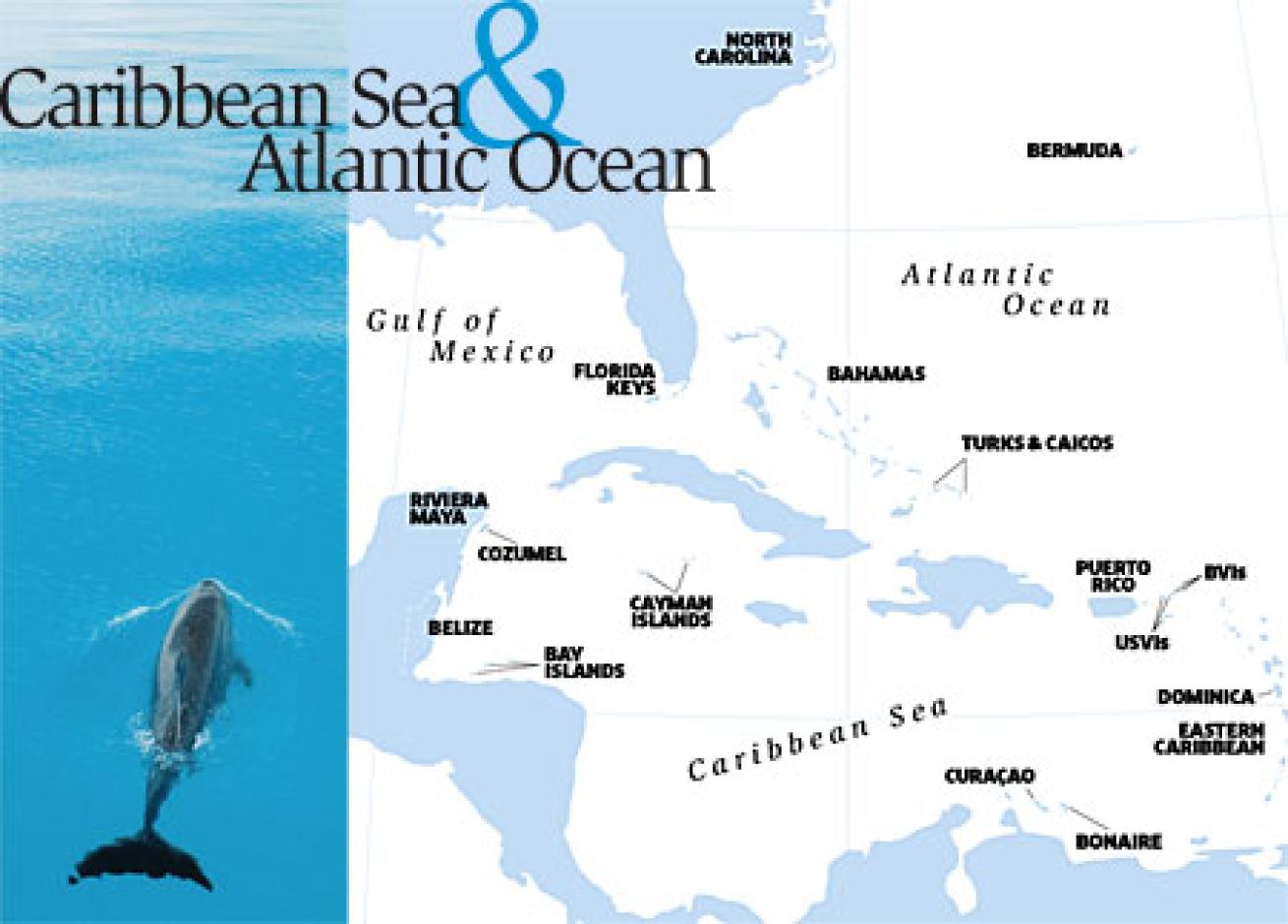
| | Photo by Stephen Frink|
It also doesn't hurt to have endless lush, tropical islands to play around on before and after diving--and the fascinating blend of cultures fused together by history's harsh realities. So where to dive in? Read on to make discoveries about your favorite spot, or be tantalized by alluring new ones that will inspire daydreams.
Bahamas
|| |---|
|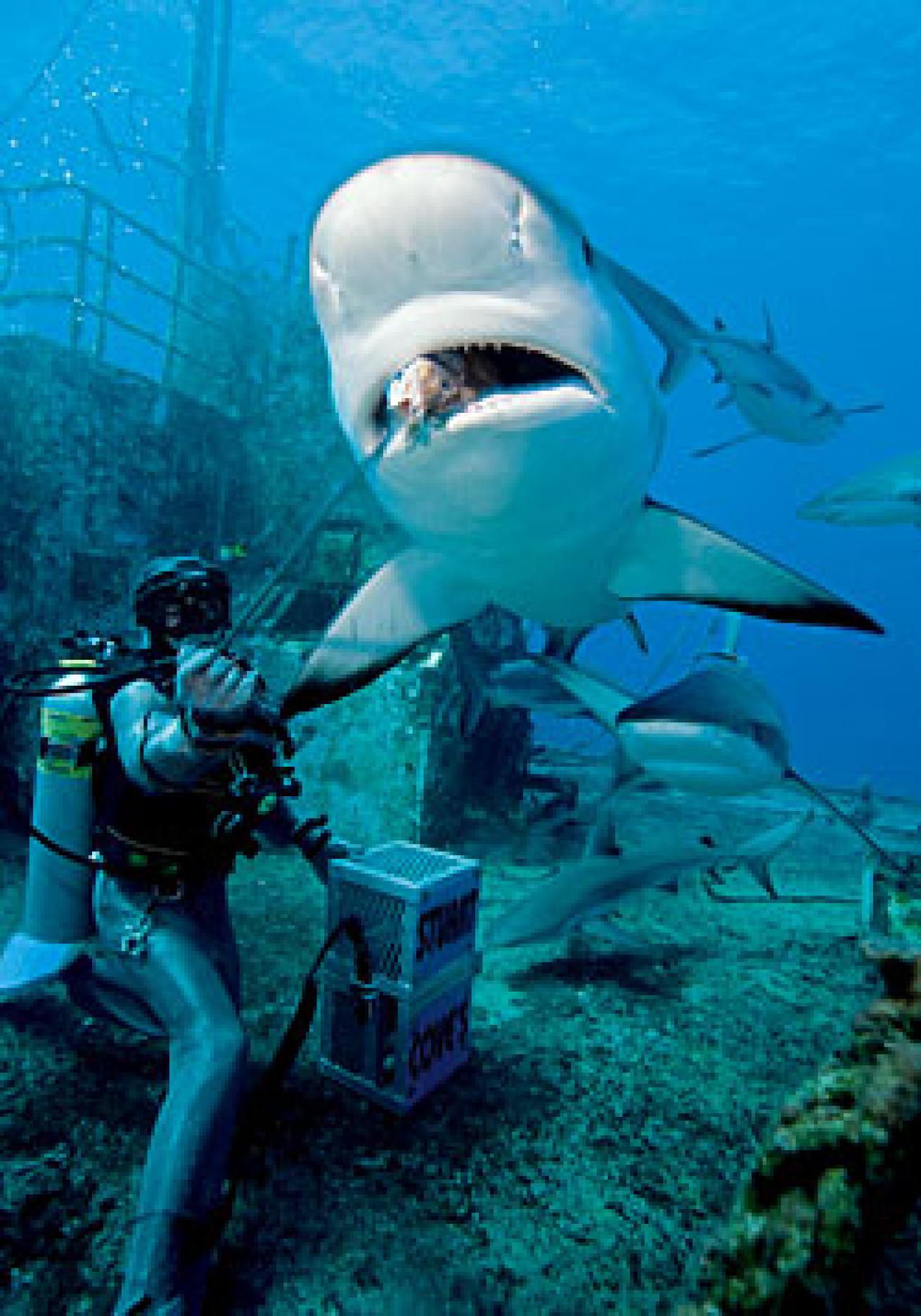
| | Photo by Stephen Frink|
With all these options, you'll need to make some choices. The first is whether to follow the crowds to the major tourist islands--New Providence and Grand Bahama--or search for a quieter ideal in the more remote Out Islands. Here's an overview of what to expect on the best-loved dive islands.
New Providence: From its southwest corner, you're only a short boat ride away from dramatic wall dives on the 6,000-foot-deep Tongue of the Ocean. There are also shallow reefs and a host of wreck dives, but the hottest ticket going is shark diving, says Cove. At sites like Shark Wall/Shark Arena, expect to see as many as 40 Caribbean reef sharks on a single tank.
Grand Bahama: The island is commonly known by the name of its major city, Freeport. But no matter what you call it, don't miss its shallow- to medium-depth reefs, several excellent wrecks and--on specially guided tours--freshwater caverns like Ben's Cave in the Lucayan National Park.
The Abacos: This horseshoe-shaped group of islands offers several popular dive ports, including Marsh Harbour and Green Turtle Cay. Shallow, sunlit coral gardens make the area popular with new divers, while history buffs enjoy exploring the remains of the San Jacinto, the first steamship ever built in the U.S.
|| |---|
|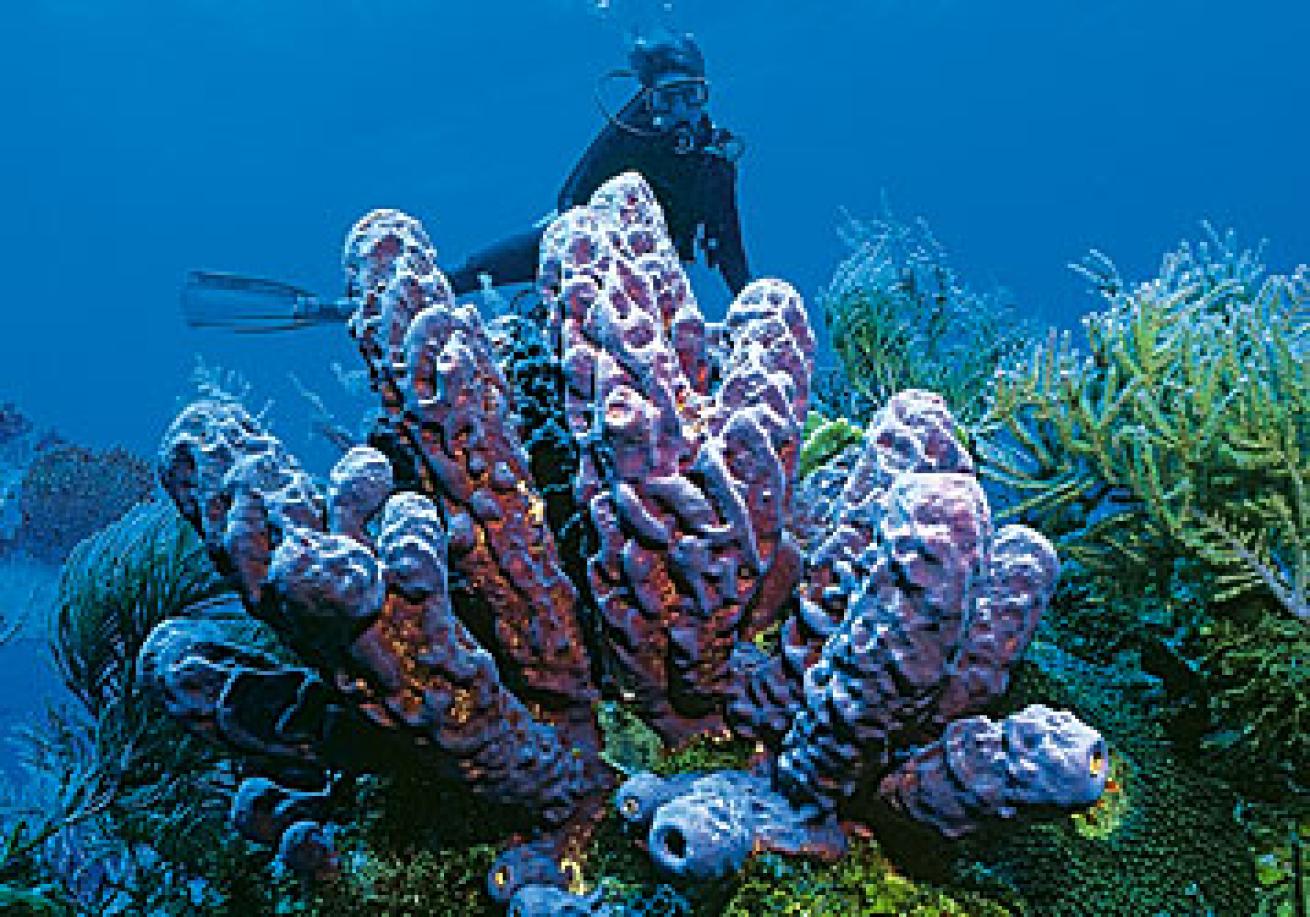
| | Photo by Stephen Frink|
Bimini: Just 55 miles east of downtown Miami, Bimini sits on the edge of the Gulf Stream, so anything can happen underwater--and usually does. Come for the active shallow reefs and deep drop-offs, stay for the thrill of snorkeling with wild pods of spotted dolphins.
Cat Island: Remote shallow reefs and wall diving that have barely been touched await divers on this island in the central Bahamas.
Eleuthera and Harbour Island: You'll find wrecks, reefs and inland blue holes, but the signature dive is the Current Cut--at 8 to 12 knots, it's the fastest drift dive in the Caribbean.
The Exumas: A popular live-aboard destination, this long string of islands is fronted by shallow reefs and ocean blue holes.
Long Island: Here you'll find a little bit of everything: shark diving, reefs, wrecks and day trips to the deep walls of Rum Cay and Conception Island.
San Salvador: This island offers amazing sheer vertical walls, peak visibility and a better-than-average chance of encounters with big pelagics.
||| |---|---|
| Snapshot<
table>
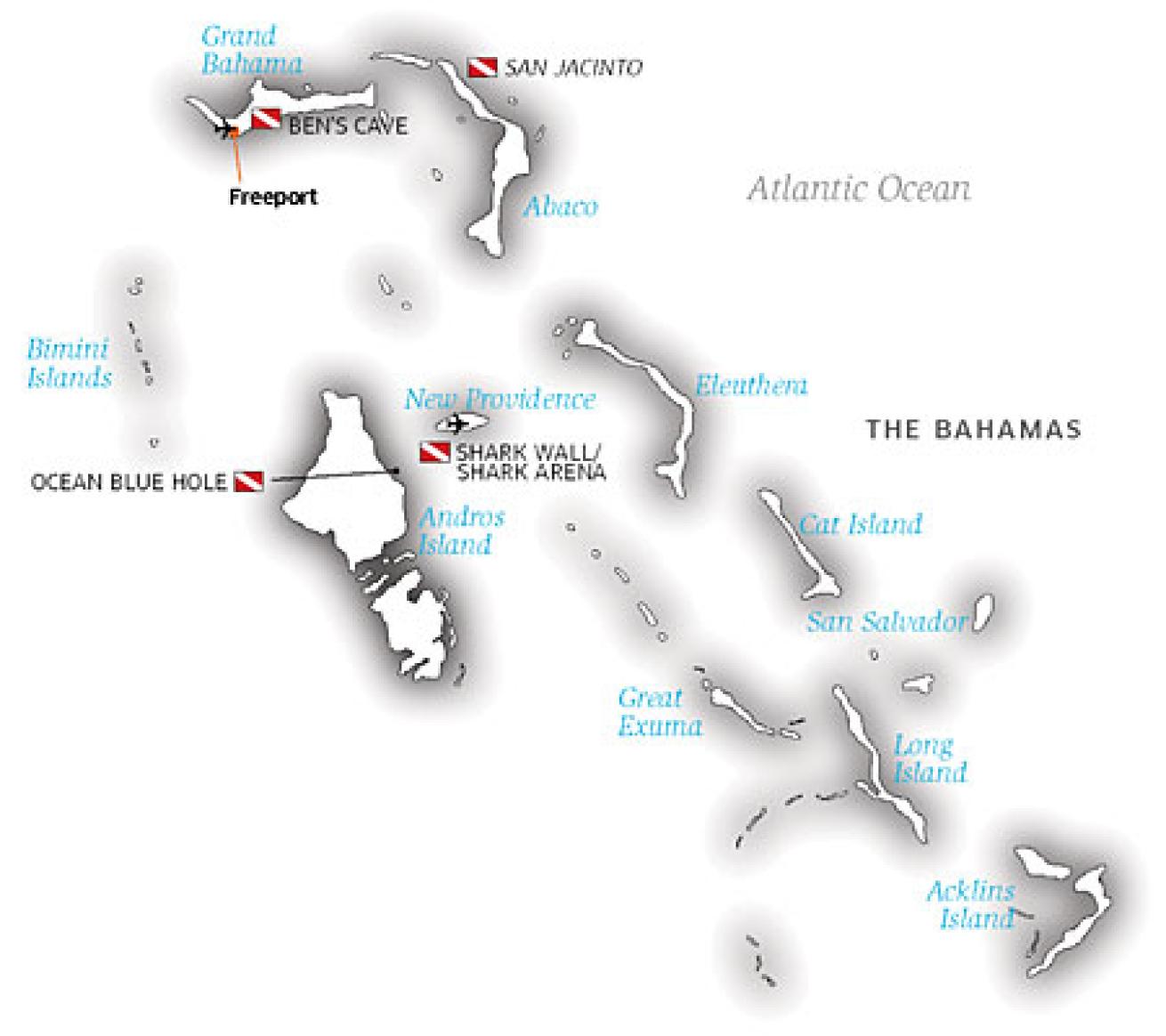
|
Weather: 70s to 80s in winter; mid- to high 80s in summer.
Money Matters: In the February to April high season, seven-night accommodation and diving packages (meals not included) on New Providence and Grand Bahama range from $775 p.p., dbl. occ., in a budget hotel to $2,500 p.p., dbl. occ., in a luxury resort. In the Out Islands, seven-night live-aboard cruises, including accommodation, meals and diving, run from $1,295 to $1,795 p.p., dbl. occ. Seven-night land packages, including accommodation, meals and diving, range from a budget-friendly $1,000 p.p., dbl. occ., to $4,000 p.p., dbl. occ., with a lot of extras. The Bahamian dollar (B$) is equal in value to the U.S. dollar and the two are used interchangeably. The departure tax is $15 from New Providence and the Out Islands; $18 from Grand Bahama.
Get More: scubadiving.com/travel/caribbeanatlantic/bahamas
Getting There: Nonstop flight time from Miami to Nassau/Paradise Island (NAS) and Freeport, Grand Bahama (FPO) is about 35 minutes. Nonstop flights are also available from other U.S. gateways, including Charlotte and Philadelphia. Nassau is the chief gateway to the Out Islands, with Bahamasair serving them all.
Bay Islands
From the massive whale sharks of Utila to the huge crack in the reef at Mary's Place on Roatan; from Guanaja's Jado Trader to the Caribbean reef sharks of Cara a Cara Point, Honduras's Bay Islands have long been noted for the great variety of dive experiences they offer. They've got wrecks, walls, reefs and animal encounters. If you're looking for something special, you don't have to look any farther than the Bay Islands.
The vast majority of reefline around Roatan lies close offshore and follows the contours of the island's coastline. Cara a Cara Point, however, juts out at a right angle from the south shore. Thanks to its proximity to deep water, the point is a favorite hangout of Caribbean reef sharks.
The 300-foot Odyssey was sunk in 2002 off Roatan's north shore. The top of the bow is at 70 feet and the stern is resting on the sand at 110 feet. You can explore the intact stairwells of the stern accommodation quarters, where you'll find barracuda, jacks and parrotfish.
Gold Chain Reef on Roatan's south coast "is covered in staghorn coral and is filled with colorful tropical fish," says Patty Grier of Dockside Dive Center. "From there, you can get to my little secret spot. If you head west from the mooring at this site--a 20-minute swim--the wall begins to curve to the south and you'll find several reverse ledges and narrow crevices. Usually, these are filled with silversides."
Mary's Place, one of the most popular dive sites on Roatan, is "a spectacular cut in the wall as wide as 12 feet in places," says Patrick Zingg, of Subway Watersports. At some points during the day, sunlight streams into the crevice, illuminating the colors of the reef; at other times, low light creates an eerie mood.
Off the southern shore of Utila, an underwater mountain rises from the seafloor, stopping just 35 feet short of breaking the surface and becoming an island. "The Black Hills seamounts feature lots of fish, turtles and a beautiful reef," says Billy Hale, of Utila Lodge. Drop down deep over the side of the seamount at Black Hills to start your dive and then work your way around and back toward the top. "My secret spot," says Hale, "is Airport Caves, two caves that everyone thinks are blind caves, but they're not. You swim in and when you get to the sandbar, you can swim up and over into the back of the cave, follow it around and come out a different opening."
Deep Blue's Steve Fox also recommends Duppy Waters, on the eastern edge of Turtle Harbour, "a site that has enormous barrel sponges and a beautiful reef to explore."
Utila is still at the top of the list of Caribbean whale shark hot spots. The biggest fish in the sea congregate around the banks north of the island and may be encountered year-round, though the sightings occur most dependably March through May, and August through October.
||| |---|---|
| Snapshot<
table>
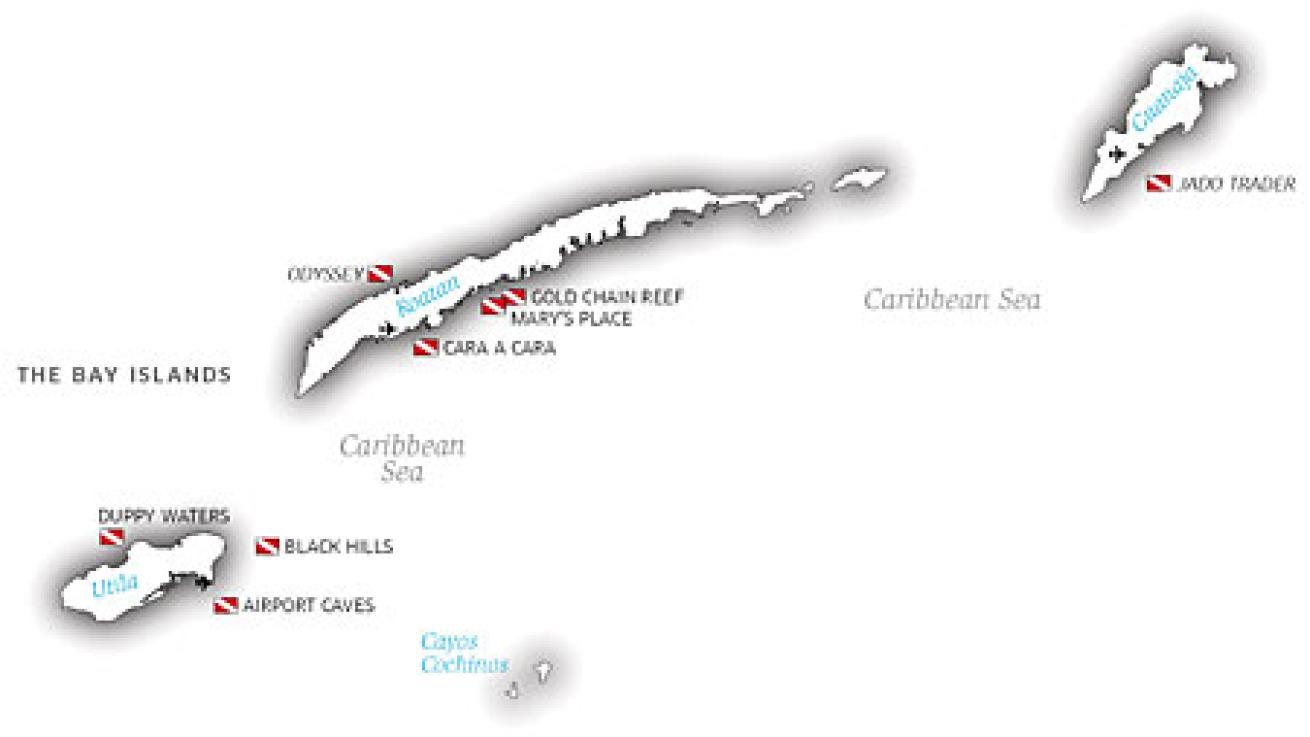
|
Weather: Mid-80s; can be cooler during winter storms. The rainy season runs from December through January.
Money Matters: Seven-night packages, including accommodation, diving and meals, range from $799 p.p., dbl. occ., to $1,199 p.p., dbl. occ., in low season; $999 p.p., dbl. occ., to $1,499 p.p., dbl. occ., in high season. Currency is the Honduran lempira (HNL); exchange rate fluctuates, but U.S. dollars are widely accepted. Departure tax is about $34.
Get More: scubadiving.com/travel/caribbeanatlantic/bay_islands
Getting There: There are nonstop flights from Atlanta, Newark, Miami and Houston to Roatan (RTB). There are also nonstop flights from U.S. gateways to San Pedro Sula (SAP) on the mainland; from San Pedro Sula there are connections to Roatan, Utila and Guanaja.
Belize
|||| |---|---|---|
|<
table>

| | Photo by Stephen Frink|
Deciding where to stay in Belize is harder than it seems--your choices range from the quaint ambience of San Pedro on Ambergris Caye to the dive-only atolls to the nature-loving South.
The barrier reef off Ambergris Caye starts five miles north of the Mexican border and is so near shore that dive sites are only five minutes away. "Hol Chan and Shark Ray Alley are our most popular dives, and for good reason," says Karen Waight-Canul, of Ambergris Divers. "These sites are great examples of why areas are protected."
Experienced divers like to visit Hol Chan Cut: Strong tidal currents make it tricky to dive this site, but also supply food to filter feeders such as sea fans, sponges and gorgonians and to fish like grunts and mutton snappers. Divers stay close to the channel sides where irregularities in the walls blunt much of the current's strength.
Three of the four true atolls in the hemisphere--Lighthouse Reef, Turneffe Islands and Glover's Reef--lie 30 to 60 miles off the mainland, beyond the immense barrier reef, and offer fish- and coral-packed walls that plummet 3,000 feet below. Ranked among Belize's best wall dives, the Elbow at Turneffe's southern tip is a busy intersection of currents and big fish; you'll see schools of jacks, permit and barrel sponges. The walls at Lighthouse Reef's Half Moon Caye are shot through with innumerable tunnels and swim-throughs and packed with huge barrel and tube sponges, yellowtail snappers, eagle rays and garden eels.
|| |---|
|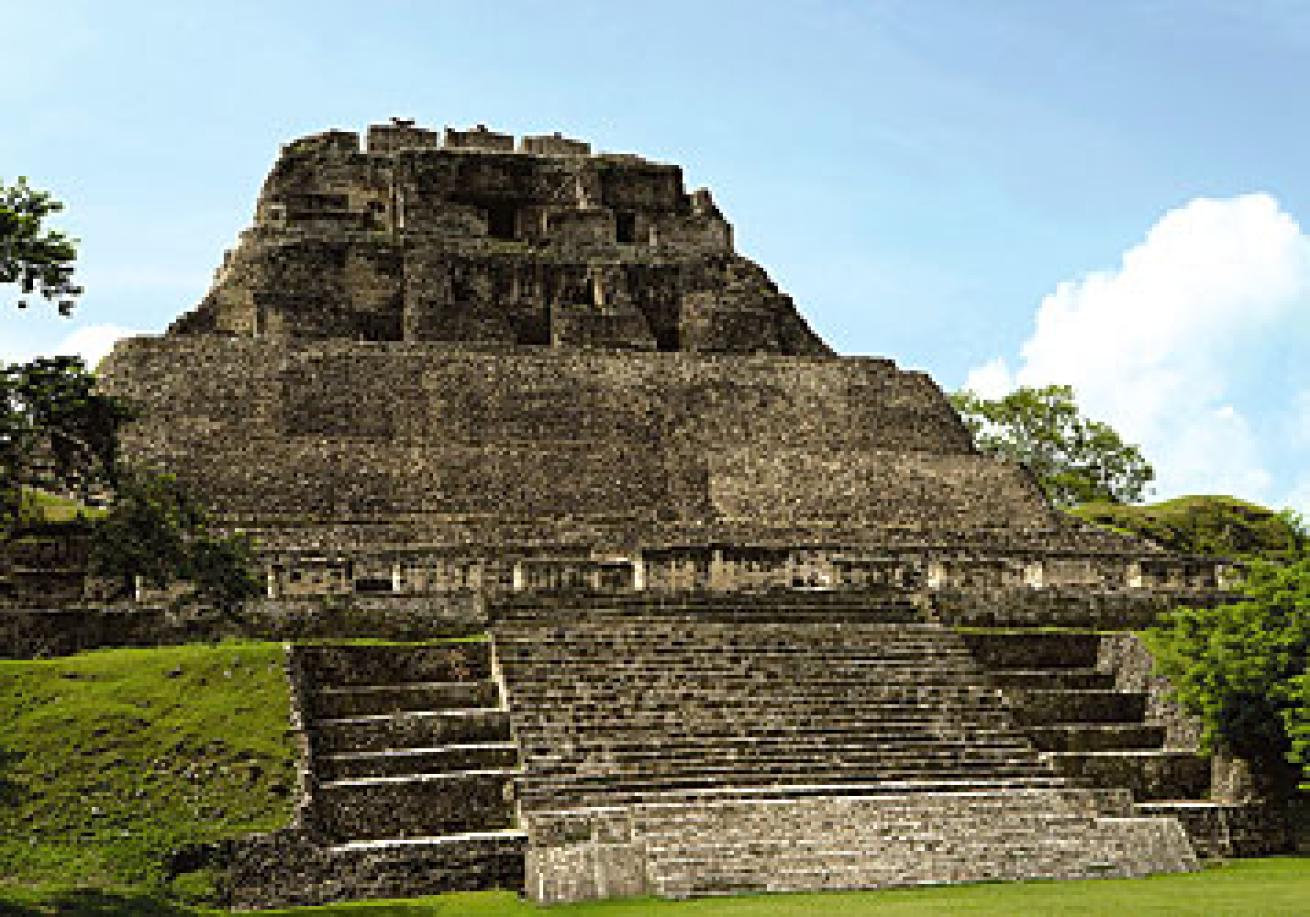
| | Photo by Stephen Frink|
Gladden Spit, near Placencia, is a hot spot for whale shark encounters between March and June. Placencia dive operators take small groups of divers to this reserve, where whale sharks, drawn by spawning dog and cubera snappers, come in search of an easy meal.
||| |---|---|
| Snapshot<
table>
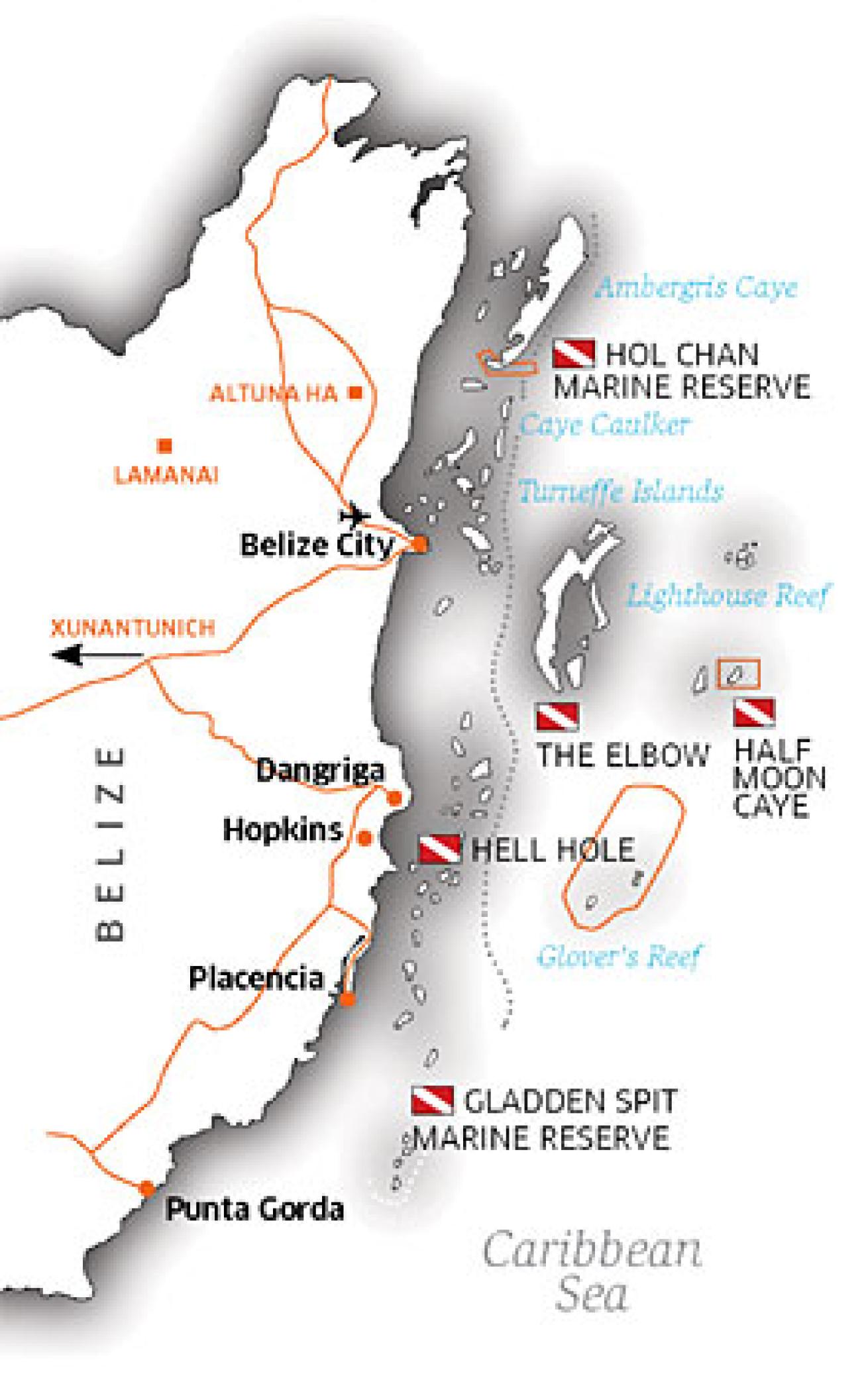
|
Weather: Mid-70s in winter; 80s in summer. The rainy season is June through October.
Money Matters: Seven-night live-aboard trips, including accommodation, meals and diving, start from $2,195 p.p., dbl. occ. Seven-night land packages, including accomodation, meals and diving, range from $1,000 p.p., dbl. occ., to $2,300 p.p., dbl. occ. Currency is the Belize dollar (BZ$); exchange rate is fixed at BZ$2 to US$1. Departure tax is about $35.
Get More: scubadiving.com/travel/caribbeanatlantic/belize
Getting There: There are nonstop flights to Belize City (BZE) on many carriers from Atlanta, Charlotte, Dallas/Ft. Worth, Houston, Miami, and Newark. From Belize City, connections can be made to Ambergris Caye, Caye Caulker, Dangriga, Placencia and Punta Gorda.
Bermuda
|| |---|
|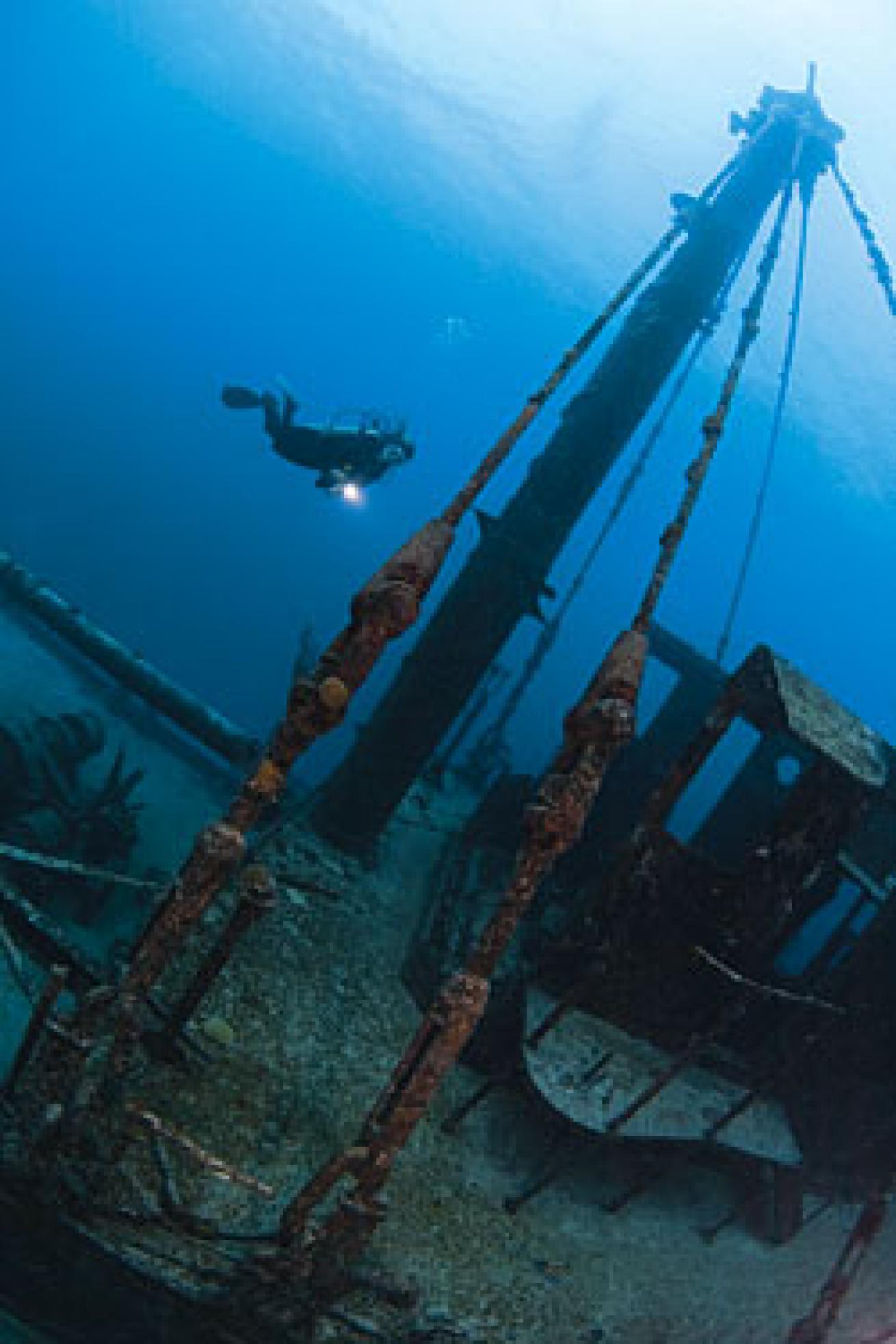
| | Photo by Carlos Villoch|
"We're the wreck capital of the Atlantic," says Kevin Luton, of Dive Bermuda. "It would take forever to dive them all."
The folks at Triangle Diving suggest the King George, a 171-foot dredger scuttled in the 1930s, fully intact at 60 feet and teeming with fish life and a stunning array of soft corals. Luton suggests the Hermes, another wreck that was purposely sunk, and is the island's most popular dive. She's resting at 80 feet and great visibility there gives divers the chance to explore her from engines and deck winch to propeller and pilothouse. Civil War buffs flock to the Marie Celeste, a paddlewheel steamer the Confederate Navy converted into a blockade-runner and the Pelinaion is a 385-foot beast of a cargo vessel with enormous, intact parts of her anatomy.
And though Bermuda isn't known for its reefs, it still boasts nearly 300 square miles of them, where you can find indigenous black groupers, tarpon from September through March and even an "undertaker"--an invertebrate better known as the black sea hare. Cathedral features a great swim-through cave with thousands of glassy sweepers, while Hangover Hole has tunnels, arches and tons of animal life. Luton says cave diving in Bermuda's inland is also catching on.
Bermuda's dive season parallels the U.S. East Coast's. Topside, renting a motorbike or buying a bus pass is a great way to visit small towns, historic forts and golf courses.
||| |---|---|
| Snapshot<
table>
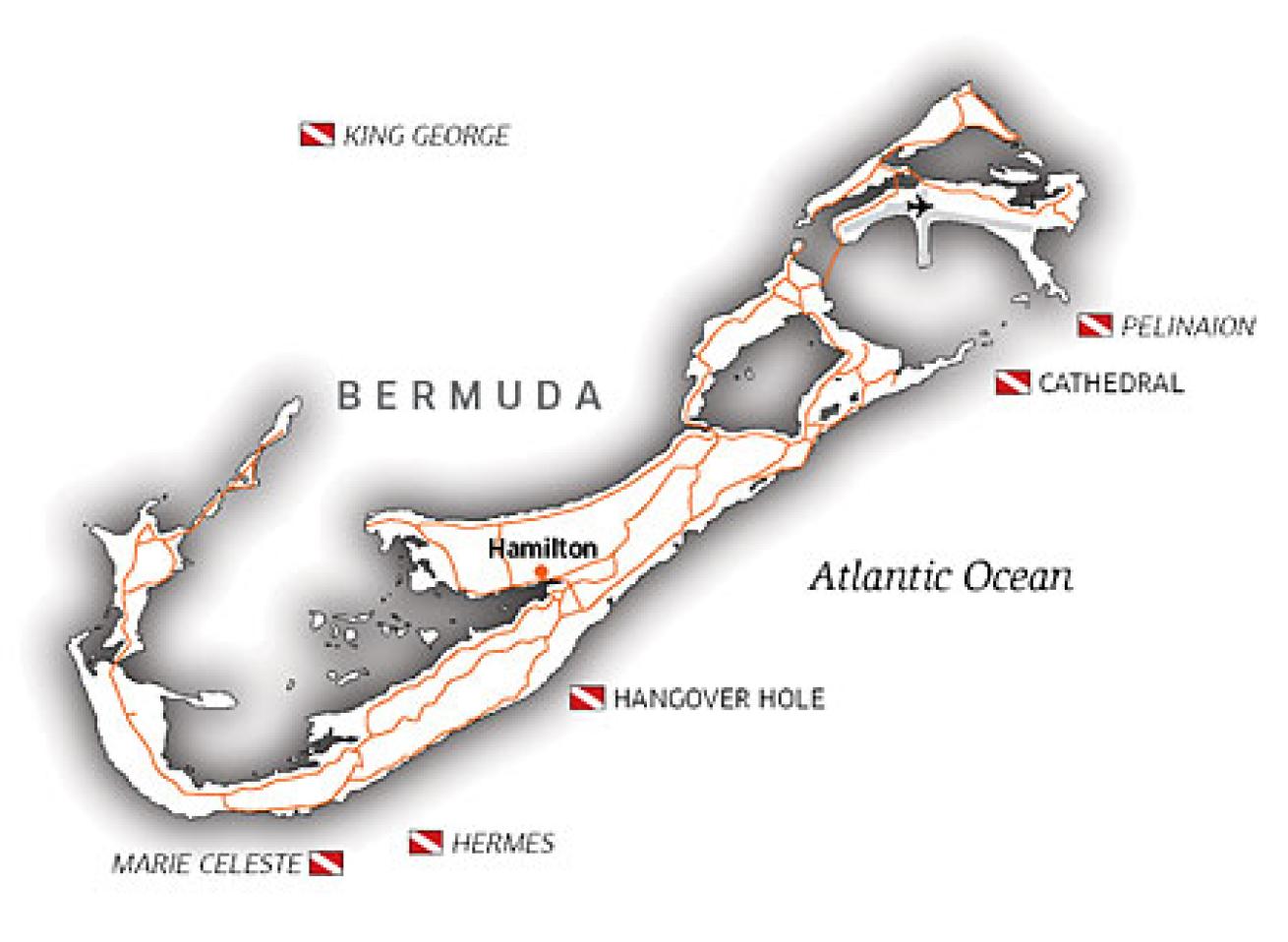
|
Weather: 60s to 70s in winter; mid-70s to mid-80s in summer.
Money Matters: On average, one-week packages to Bermuda, including airfare from the U.S. East Coast, accommodations at a dive resort and diving, run about $1,600. Currency is the Bermuda dollar (BD$); it's pegged to the U.S. dollar. Departure tax is usually included in airline ticket prices.
Get More: scubadiving.com/travel/caribbeanatlantic/bermuda
Getting There: Traveling to Bermuda is a snap, with Jet Blue, US Airways, Delta, United, Continental, American and Air Canada all flying nonstop to Hamilton (BDA) from multiple North American gateways.
Bonaire
Quaint, colorful Dutch architecture, friendly people and easy, 24-hour shore diving all combine to make Bonaire one of those rare destinations that nitrogen junkies return to year after year. In the time it takes to say bon bini--the local term for welcome--you'll fall in love with this charmer, which is, with Curaçao and Aruba, one of the trio of Netherlands Antilles islands just north of Venezuela.
Make just one dive underwater and you'll know why the island is a favorite among divers. The majority of Bonaire's pristine reefs, protected as a marine park for more than 30 years, are accessible from shore. The leeward side is the calmest, though the sites farther north or south of the capital city of Kralendijk are more challenging. Typically, Bonaire's small beaches continue under water in sandy plains dotted with a few corals that slope down to 30 feet. The reef drops off gradually to another sandy plain at about 140 feet. Dive resorts make tanks available 24 hours a day for shore diving among the island's 60-plus dive sites. Get a rental truck, fill it with tanks and dive gear and pick one.
If you prefer, most sites can be accessed by boat, and dive operators also offer daily two-tank dives at Klein Bonaire, an uninhabited island off Kralendijk that boasts nearly two dozen sites of its own.
Some of the best dives on Bonaire require neither a boat nor a car--they're found right off the dock of your waterfront dive resort. If you're a guest, you can suit up and wade in any time the mood strikes. At Plaza Resort, drop down on 18th Palm to find small terraces of scattered coral heads, tube sponges and elephant ear sponges. Bari Reef, off Sand Dollar Resort, is a gently sloping terrace renowned for its prolific fish life. La Machaca, the house reef at Capt. Don's Habitat, is named after the small fishing boat that rests in 40 feet of water. Buddy Dive Resort's house reef features a slope that starts in about 30 feet of water and drops off to a sand bottom at 100. Divi Flamingo's Calabas Reef has a small boat to explore at about 70 feet. Just off Harbour Resort's beach, the Our Confidence is a wooden-hulled freighter that's home to turtles and eels.
Bonus: A line leads from the wreck to an adjacent reef called Something Special, one of Bonaire's best sites, according to marine biologist Anna DeLoach of Reef Environmental Education Foundation. "We have never been disappointed at this site," DeLoach says. "It offers plenty of fish life on a shallow sand and rubble shelf that slopes down to 100 feet." Public access is about 200 feet south of the resort.
The sites just south of Kralendijk include the island's biggest wreck, the Hilma Hooker, a 236-foot-long freighter lying on its side in 100 feet of water. The underside is coated with orange cup corals and tube sponges. Angel City, a double reef system, is between the Hooker and another site, Alice in Wonderland. Angel City gets its name from the ubiquitous angelfish found here, but there's plenty more to see.
North of Kralendijk you'll experience Bonaire's wild northwestern coast. Here's where you'll find the famed site 1,000 Steps. This dive begins from a pretty, sheltered cove. The shallow shelf is covered with corals and is alive with fish. You'll spot blue tangs, snappers and goatfish in large numbers.
Recently, experienced divers have been heading to sites off Bonaire's east coast, like White Hole and Cai, where tarpon and rays hang out. "East side diving--when the weather is right--offers an adventure and something different from the west coast," says Mieke Hermans, of Wannadive Bonaire.
Conservation-minded Bonaire is also becoming known for other adventure activities. "One of the most common misperceptions about the island is that there's nothing else to do but dive," says Hermans. "But that's wrong--there is also a big surfing and windsurfing culture, plus rock climbing, kayaking and mountain biking. It's not only about the diving."
||| |---|---|
| Snapshot<
table>
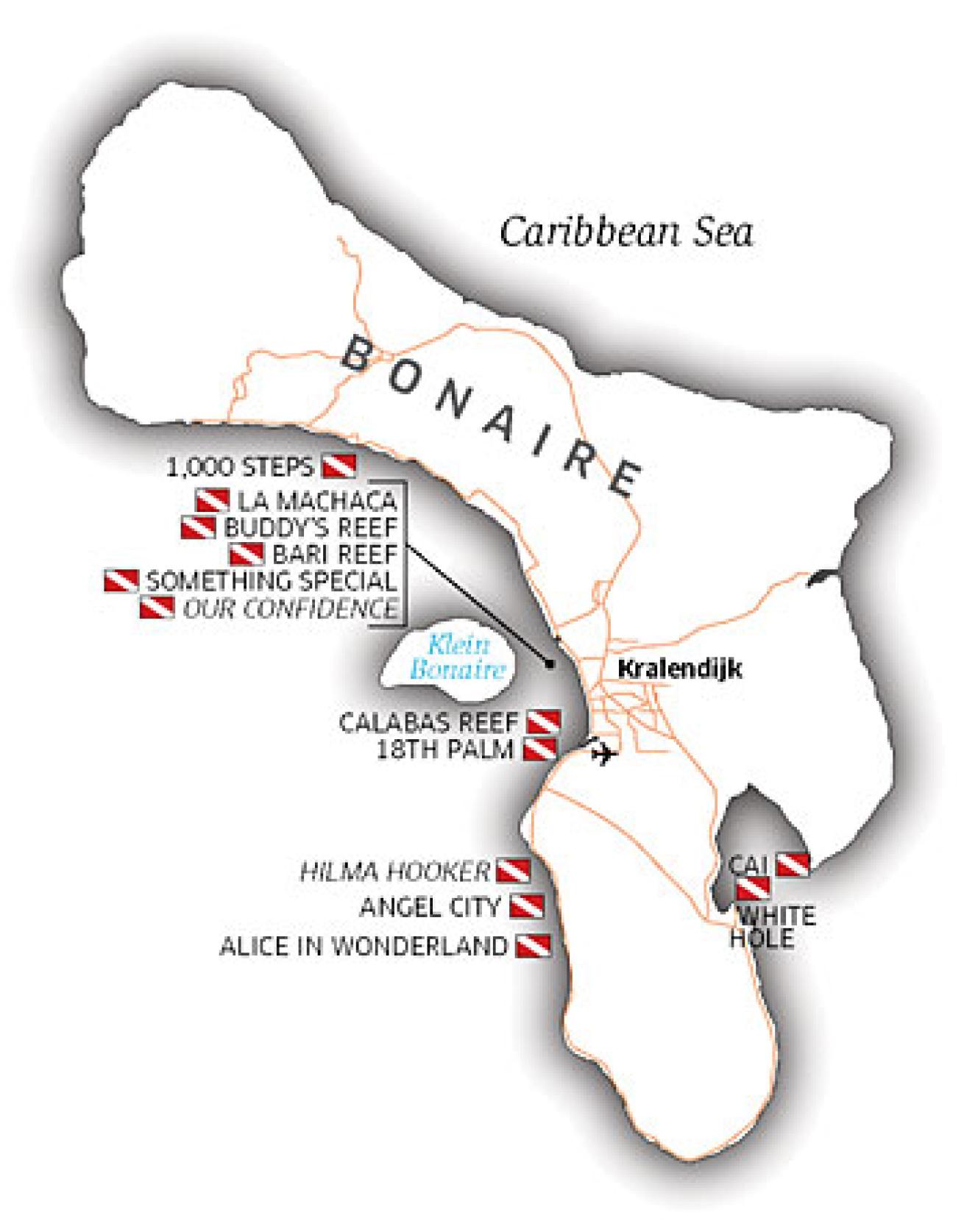
|
Weather: 80s in winter; 90s in summer.
Money Matters: Seven-night packages, including accommodation, breakfast and unlimited shore diving, run from $830 p.p., dbl. occ., to $1,800 p.p., dbl. occ. Currency is the Netherland Antilles guilder (ANG), fixed at the exchange rate of 1.77 to the dollar for cash. You'll have to purchase a $25 marine park tag before you dive. Departure tax is $32.
Get More: scubadiving.com/travel/caribbeanatlantic/bonaire
Getting There: Continental offers Saturday-only nonstop flights from Newark and Friday-only nonstop flights from Houston to Bonaire's Flamingo International Airport (BON). Delta offers Saturday non-stops from Atlanta. There is also one-stop service (via San Juan, Montego Bay, Aruba or Curaçao) from many U.S. gateways.
British Virgin Islands
|| |---|
|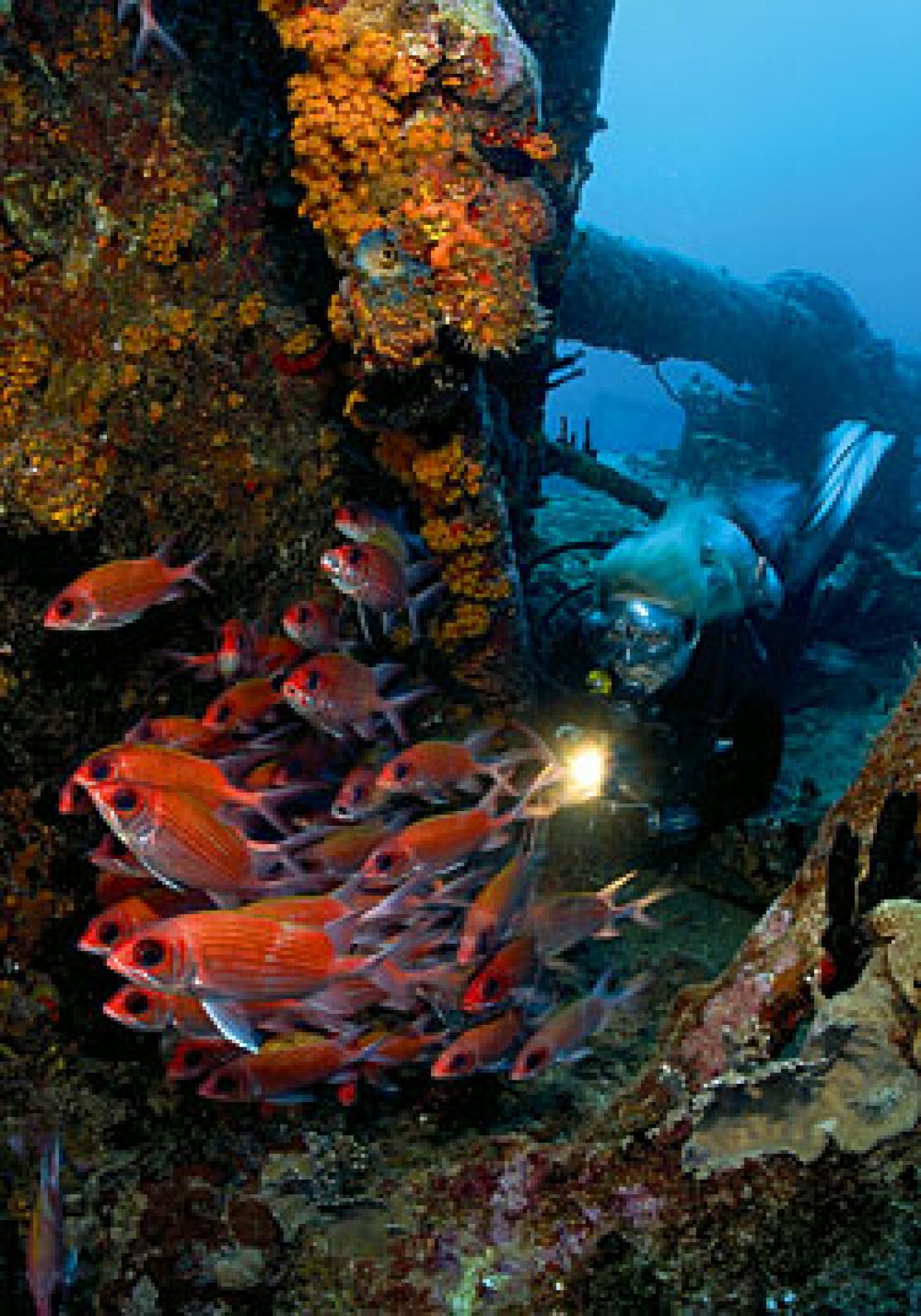
| | Photo by Mauricio Handler|
Tortola is home to more dive operations than any other island in the chain, but the majority of established dive sites are across the Sir Francis Drake Channel, around the largely unpopulated islands of Peter, Norman, Cooper, Salt, Ginger and Dead Chest.
Divers staying on Virgin Gorda have easy access to sites surrounding the nearby Dog Islands, marked by intriguing formations including arches and canyons. Virgin Gorda is also home to the Baths, a scattering of colossal granite boulders that form quiet grottoes and pools. Bring a snorkel and fins to swim with a colorful array of reef fish on the ocean side of the rocks.
Jost van Dyke is a small getaway northwest of Tortola. "Mercurious Rock and No Man's Land are our two most popular dive sites," says Capt. Colin Aldridge, of Jost Van Dyke Scuba. "Mercurious Rock is an offshore cave system that can only be done in good conditions. No Man's Land is a series of offshore pinnacles west of the island. Sharks are commonplace."
Off Salt Island, the bow of the HMS Rhone lies on its starboard side in 75 feet of water and offers penetration into its cavernous interior. The shallower stern section features the 70-foot propeller shaft and a rich assortment of marine life, including schooling grunts and snappers, barracuda, morays, octopuses and lobsters.
Large schools of fish and big pelagics seem to prefer the wreck of the Chikuzen, north of Tortola. This site is remote and subject to unfavorable ocean conditions. If you have a dive operator willing to make the run out, go.
One of the best seamounts is Blonde Rock, which rises in two pinnacles from 60 feet to within 15 feet of the surface between Salt and Dead Chest islands. The rock itself is heavily honeycombed, with ledges and overhangs sheltering blackbar soldierfish, glasseye snappers and fairy basslets.
||| |---|---|
| Snapshot<
table>
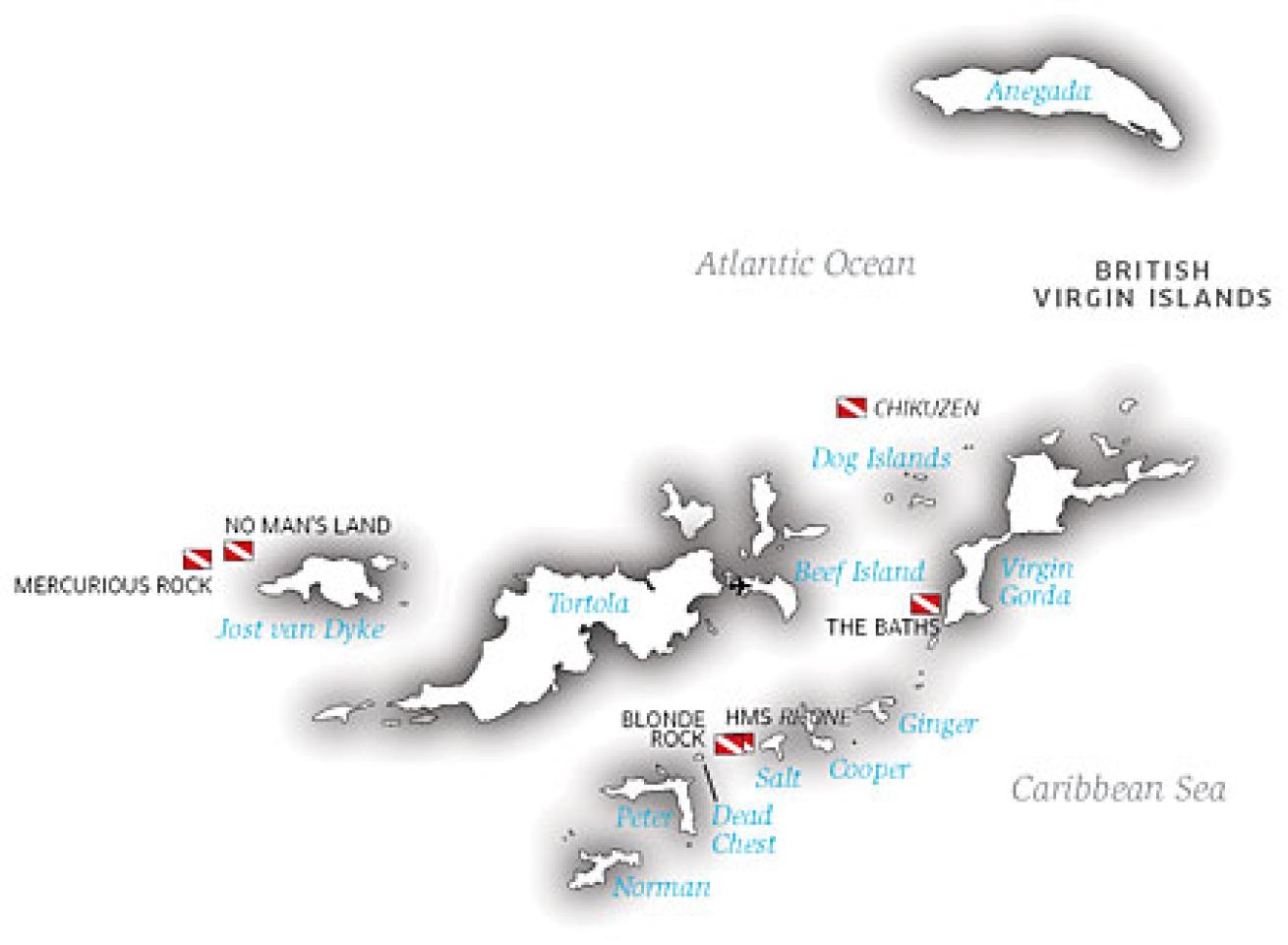
|
Weather: Mid-70s to mid-80s in winter; 80s to 90s in summer.
Money Matters: Six-night live-aboard cruises, including accommodation, diving and meals, run about $2,000 p.p., dbl. occ. Seven-night land-based packages, including accommodation and diving, start from $715 p.p., dbl. occ. Currency is the U.S. dollar. Departure tax is $27.50.
Get More: scubadiving.com/travel/caribbeanatlantic/british_virgin_islands
Getting There: There are no nonstop flights from U.S. gateways to the Terrence B. Lettsome Airport (EIS) on Beef Island, a cay linked to Tortola by the Queen Elizabeth II Bridge. All flights connect through San Juan (SJU), St. Thomas (STT), Antigua (ANU), St. Kitts (SKB) or St. Maarten/St. Martin (SXM). If you're traveling to Virgin Gorda, Anegada, Peter Island or Jost van Dyke, make sure that charter flights or ferry service will be available if you arrive on Tortola after 4 p.m.
Cayman Islands
|| |---|
|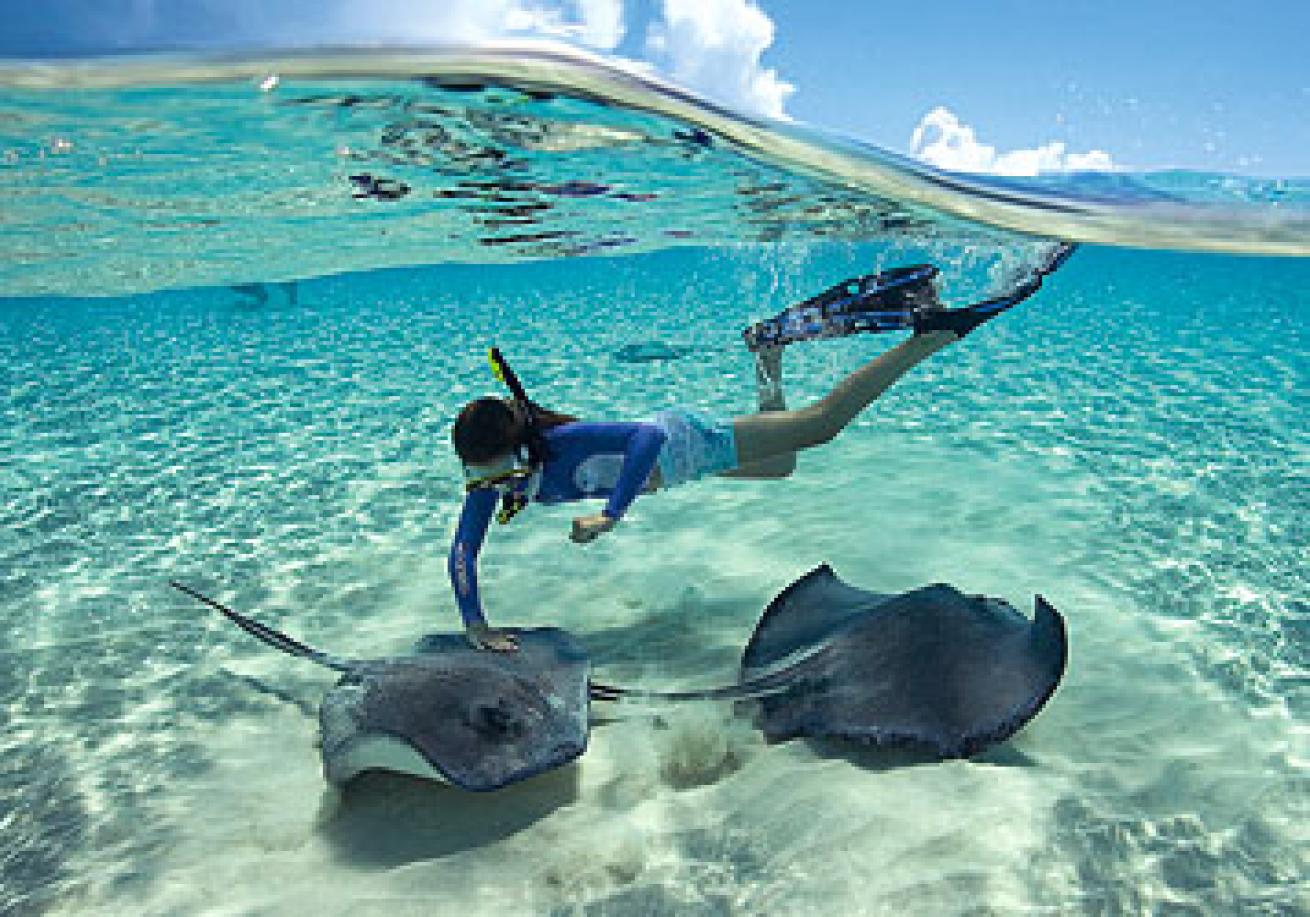
| | Photo by Stephen Frink|
Grand Cayman
The Grand Canyonesque topography that defines the 150 sites off Grand Cayman--whether on the North Shore, West End or East End--is a showcase of precipitous walls, towering canyons and reefs laced with swim-throughs.
A new shore diving site that was recently opened to divers in West Bay is Lighthouse Point, "remarkable for its sponge growth, pinnacles, swim-throughs and caves," says Divetech's Nancy Easterbrook. "It has two options--a shallow mini wall just minutes from the beach or a deep wall about 10 minutes from shore."
The most popular area to dive on Grand Cayman is off Seven Mile Beach on the island's West End. Many of the sites here--Orange Canyon, Trinity Caves, Eagle Ray Rock and Aquarium--start in just 50 or 60 feet of calm blue water. The West Bay site Trinity Caves is a striking system of narrow passageways and small canyons that run perpendicular to shore and lead you out to the wall.
North Shore diving is characterized by the shallow sites found in North Sound and the steep drop-offs along North Wall. Stingray City, Grand Cayman's world-famous animal encounter, is in only 12 feet of water in North Sound. Nearby is Sandbar, popular with snorkelers seeking a stingray encounter.
Grand Cayman's East End "offers a slower pace above and below," says Lesley Agostinelli of Ocean Frontiers. Sites here, like Snapper Hole and Babylon, are clustered on the southeast and northeast corners. Babylon features a stunning pinnacle and wall. "Snapper Hole is a labyrinth of tunnels and caverns filled with snappers, tarpon and silversides," she says, "but it also features an 1872 Spanish anchor and a rare formation of pillar coral."
Little Cayman
This is an island where "you say 'hi' to everyone," says Marc Pothier of Paradise Villas. "Nothing really changes around here and people love that." Little Cayman, the smallest of the three Cayman Islands, boasts Bloody Bay Wall, a site on its North Shore, which is lavishly decorated with sea fans and coral formations. "This site is so popular because it starts in as little as 12 feet of water and drops straight to 6,000," Pothier notes. The intersection of Bloody Bay Wall with Jackson Bight is known as Mixing Bowl, another favorite among divers.
Cayman Brac
Tranquil Cayman Brac boasts two shores of top-notch wall diving "with about 40 sites surrounding the entire island," says Charley Oxley, of Reef Divers at Brac Reef Beach Resort.
Off the north shore, the MV Capt. Keith Tibbetts, the fabled 330-foot Russian warship, "affords divers the chance to see the interior of a wreck because there are a number of swim-through passages," Oxley says. "It's such a great dive because it begins in only 20 feet of water, and it's visited by turtles, eagle rays, green moray eels, scorpionfish and much more."
Strawberry Sponge Wall, on the island's north side, sports a number of sponges on the drop-off, but it's the strawberry vase sponges that give the site its name.
On the island's south side, Anchor Wall was named for the 10-foot anchor that is wedged between a coral chimney and a mini wall.
||| |---|---|
| Snapshot<
table>
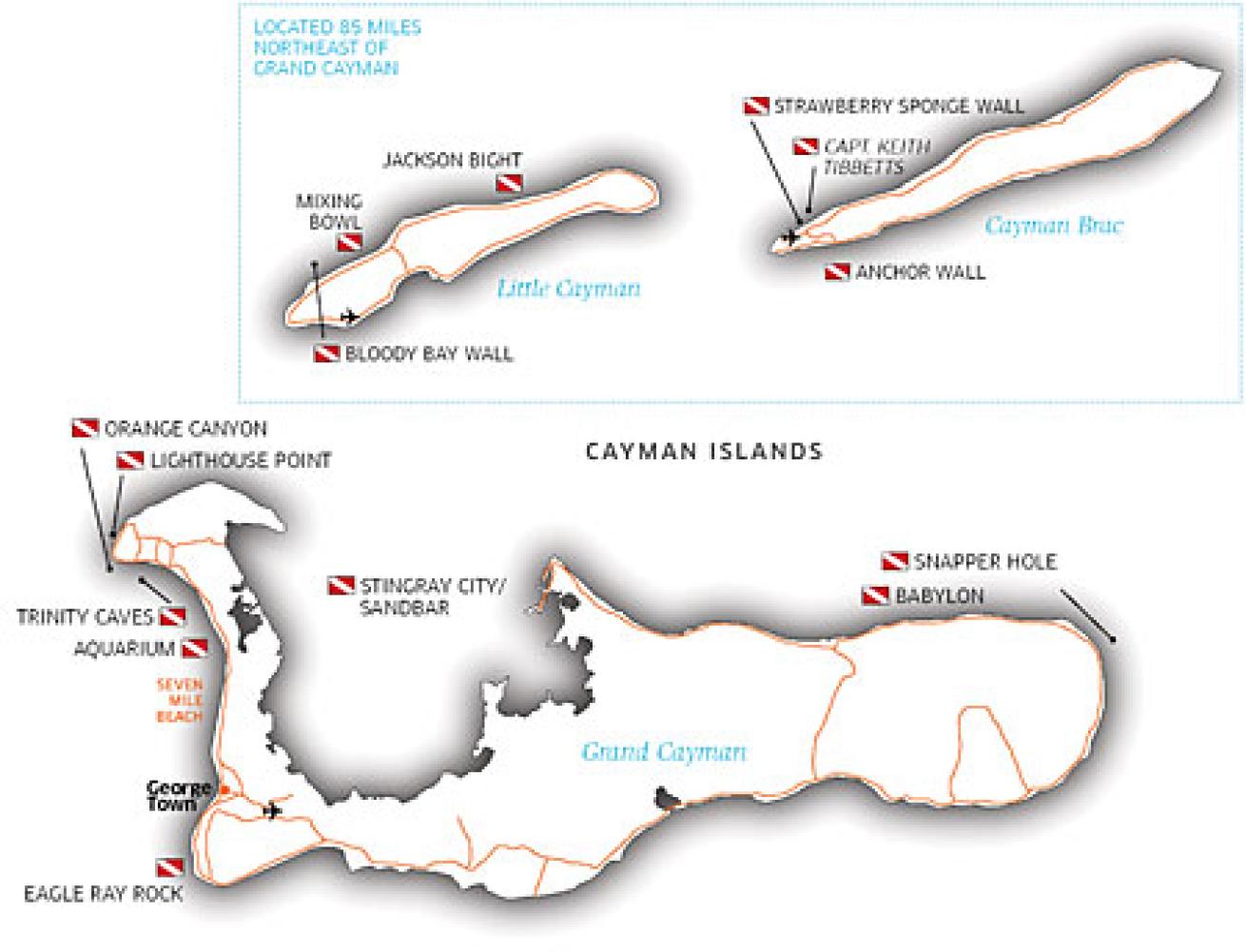
|
Weather: 70s in winter; mid-80s in summer.
Money Matters: A typical seven-night package at a dive resort, including accommodation, breakfast and diving, ranges from $1,200 p.p., dbl. occ., to $2,200 p.p., dbl. occ. Currency is the Cayman Islands dollar (CI$); exchange rate is fixed at CI$1 to U.S.$1.25. Departure tax is $25, usually included in airline ticket prices.
Get More: scubadiving.com/travel/caribbeanatlantic/cayman_islands
Getting There: Scheduled flights to Grand Cayman's Owen Roberts International Airport (GCM) are available on Cayman Airways, Air Canada, Air Jamaica, American Airlines, British Airways, Continental Airlines, Delta Airlines, Northwest Airlines and US Airways. Cayman Brac also has its own international airport, Gerrard Smith International (CYB). Little Cayman is served by daily inter-island flights.
Cozumel
Whether you're novice or advanced, first-timer or old-timer, Cozumel has diving that fits your style. Cozumel's current-swept reef starts just off the island's southern leeward shore: mild current and shallow nearshore coral gardens for novice divers, swifter current and coral pinnacles near the drop-off for intermediate divers and vertical walls in deep water subject to unpredictable currents for advanced divers.
Delilah (sometimes spelled Delila or Dalila) is an example of the island's nearshore coral garden offerings. Washed by a gentle current and with a low profile, Delilah has coral patches, lots of angelfish, colorful sponges and a variety of crustaceans that your divemaster will try to find.
The strong south-to-north current at Tormentos Reef makes this site the fastest drift diving on the island. You'll be jetted over large coral heads (about 10 feet tall) topped with whip corals and sea fans. You can shelter behind these formations to see all the grunts, whitespotted filefish and schools of creole wrasse.
Santa Rosa Wall "is a must-dive site," says Bill Horn, of Aqua Safari. The show takes place above bottomless blue depths, drifting alongside spectacular sheer cliffs. The current has carved out caves, grottoes and tunnels, where you'll find sponges, including elephant ears. Another don't-miss reef is Palancar, says Horn. "It's huge and gorgeous, making it very popular."
The first trip through Devil's Throat, the central tunnel through Punta Sur Reef, is a rite of passage for all Cozumel divers. The sand channels lead to coral tunnels, which lead to the channel's deep water.
Maracaibo Deep is far from home if you're staying near San Miguel--a day's trip--so find an operator with a fast boat. The offshore wall lip is at least 90 feet, so mind your computer. Most divers come here to find sharks, but they might not come to the party at the same time as you.
Barracuda Reef is the stuff of legend. If you can handle mighty currents, the site delivers on the promise of its name: plenty of barracuda.
Cozumel's east side offers shallower diving on "micro atolls," elkhorn coral gardens and swim-throughs, all in 50 feet or less. But what really makes this side unique is the 15 cannons, two anchors and countless cannonballs exposed since Hurricane Wilma tore through the island in 2005.
Don't miss a Sunday afternoon hanging out with the locals at San Miguel's square.
||| |---|---|
| Snapshot<
table>
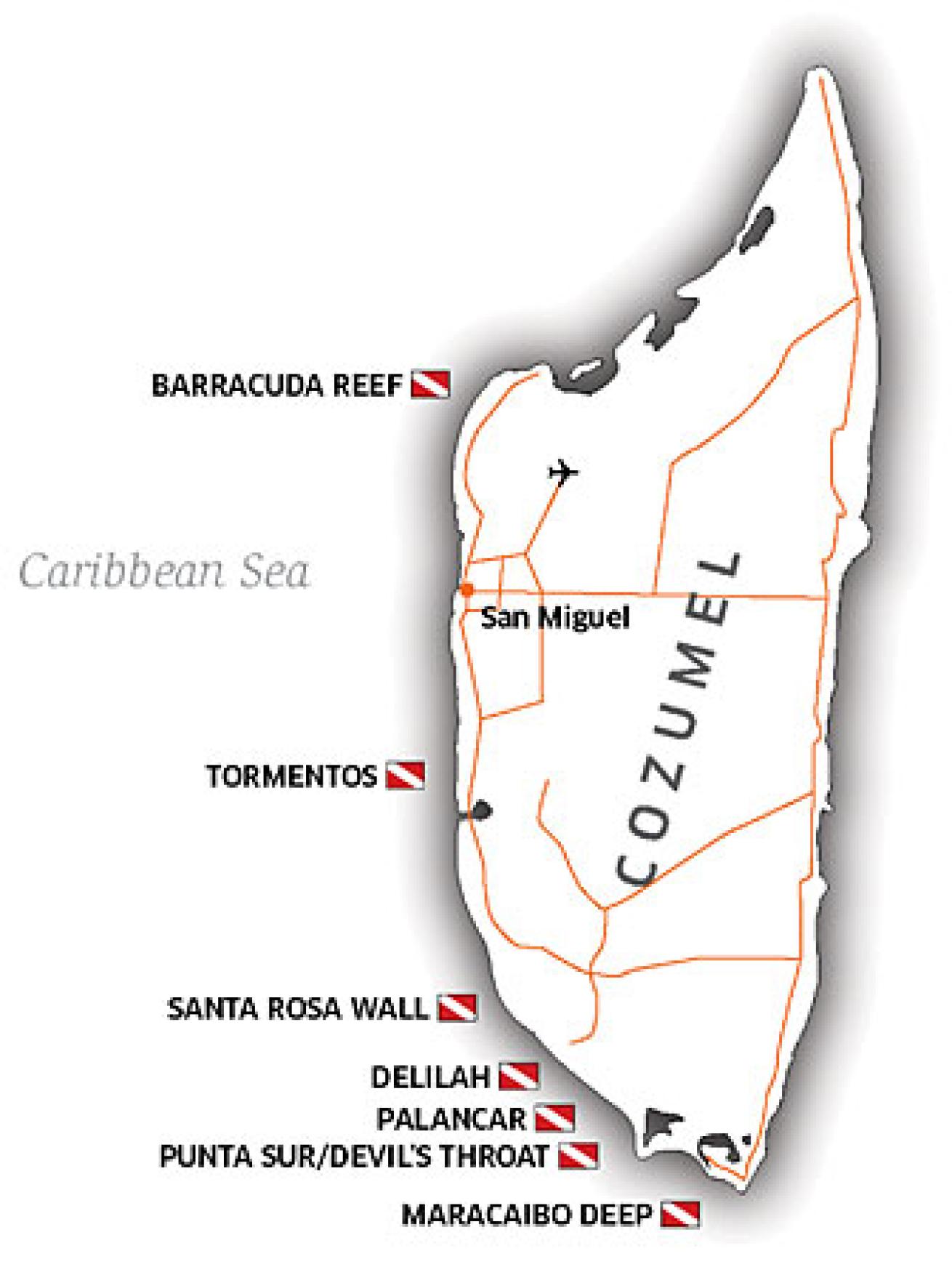
|
Weather: Low to mid-70s in winter; 90s in summer.
Money Matters: Seven-night accommodation and diving packages start from about $700 p.p., dbl. occ. Currency is the Mexican peso (MXP), although the U.S. dollar is widely accepted. Exchange rate is approximately 10 pesos to US$1, though it fluctuates. Departure tax is usually included in the price of your airline ticket.
Get More: scubadiving.com/travel/caribbeanatlantic/cozumel
Getting There: Most major U.S. air carriers offer service to Cozumel (CZM) either by themselves or via a codeshare partner. Many folks fly into Cancun (CUN)--which can be cheaper to fly into--then catch a colectivo, or shared van, to Playa del Carmen, and hop on the ferry to Cozumel.
Curaçao
Divers could easily check off many boxes on their wish lists with a single trip here. Calm conditions? Check. Good visibility? Check. Healthy reefs? Check. Macro life? Check. Unlimited shore diving? Well, let's just put it this way: The entire island is a shore diver's dream. Because Curaçao--part of the "ABC" islands of the Netherlands Antilles--is surrounded by a fringing reef created by geological events long ago, dozens of dive sites are within steps of the road. Plenty of major rental car agencies at Hato International Airport and near the cruise ship terminal in Willemstad stand ready for you to pick up your ride and then drive and dive.
Some of the standout shore dive sites include Playa Lagun, Playa Kalki (Alice in Wonderland) and Cas Abao, where only a minimal parking fee is required. Dive operators like Easy Divers at Habitat Curaçao and Sunset Waters run the attractive house reefs at those resorts. While you must rent tanks from them, you don't have to be a guest to dive those reefs.
If you prefer the boat diving experience, there are a myriad of sites all within easy reach of resorts. Watamula, with its mushroom-shaped coral heads and Porto Mari, a double-reef system (which can be dived from both the shore and from a boat), are treasure troves of small life such as yellow seahorses and Pederson cleaner shrimp. Classic can't-miss dives include Mushroom Forest and the Superior Producer wreck.
A newly en vogue site called Seldom is so named, says Anne-Marie Vermeer, of Easy Divers at Habitat Curaçao, because it's rarely visited. Boats can't moor there due to the proximity of the drop-off to the nearby cliff, creating a drift dive over untouched corals on a vertical wall.
It's definitely a necessity to have a car while on Curaçao--not just for the shore diving, but for covering all parts of the island to soak in the unique mixture of Caribbean, African and European influences. Towering Mt. Christoffel invites divers to challenge themselves to hike to its summit for incredible views, while culturally cosmopolitan Willemstad offers history at Museum Kura Hulanda and gaming at casinos.
"Why should divers return?" Vermeer rhetorically asks. "The easiness of the diving, the friendly people and the healthy reefs."
||| |---|---|
| Snapshot<
table>
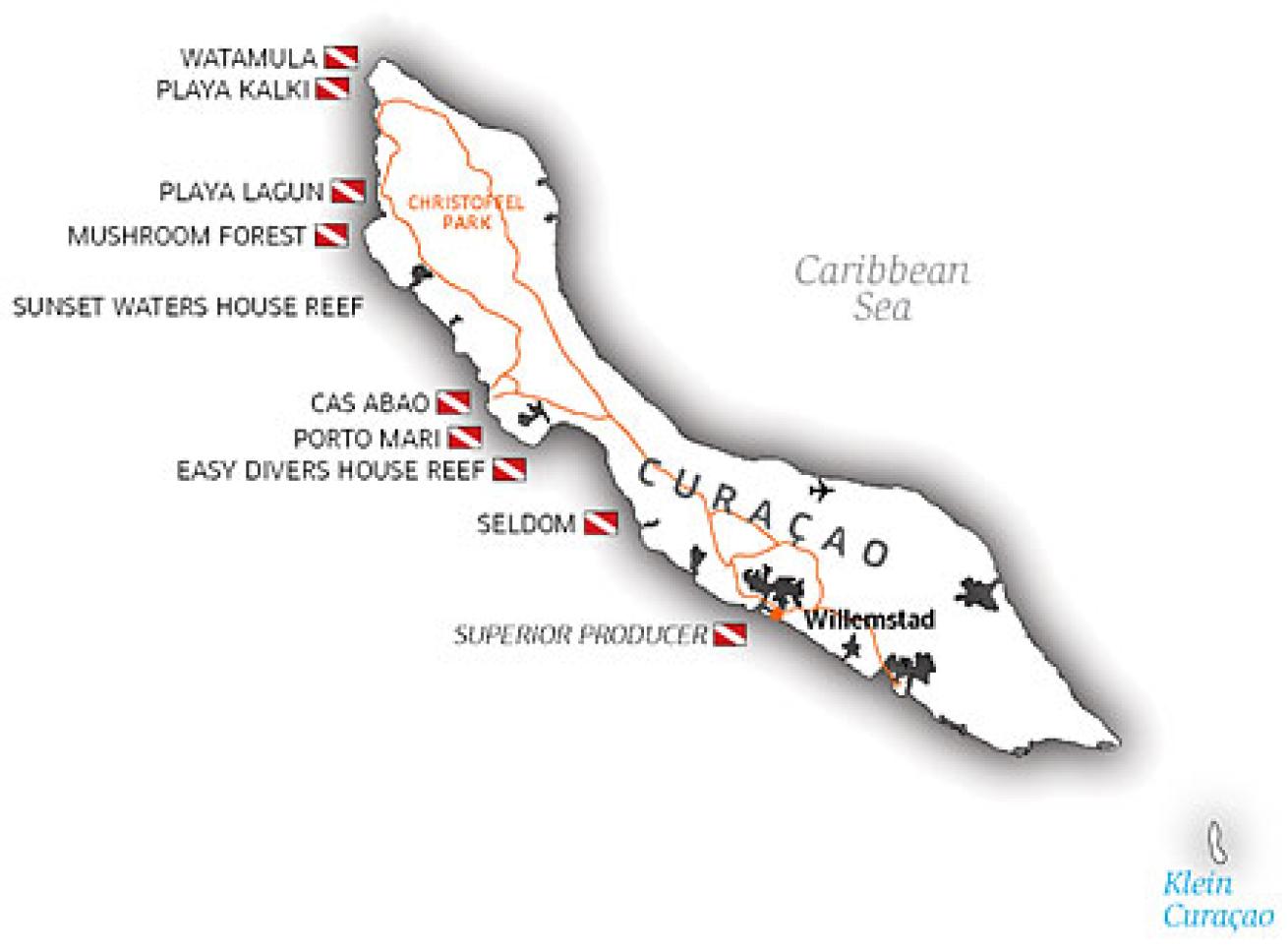
|
Weather: Mid-70s in winter; mid-80s in summer.
Money Matters: Seven-night packages, including accommodation, diving and breakfast, run about $900 p.p., dbl. occ. Currency is the Netherland Antilles guilder (ANG), fixed at the exchange rate of 1.77 to the dollar for cash. Departure tax is $22.
Get More: scubadiving.com/travel/caribbeanatlantic/curacao
Getting There: Nonstop flights to Curaçao (CUR) originate in Atlanta, Miami, and Newark on Delta, American and Continental Airlines.
Dominica
This Eastern Caribbean island is an adventurer's paradise, with take-your-breath-away topside and underwater sights. You'll be wowed by every inch of Dominica's dramatic profile--from its sheer, cloud-capped mountains to its pristine coral reefs. The most popular diving is found along the island's western coast--with sites clustered in the south, mid-island and north.
Off Dominca's southwestern end, Soufriere Bay is actually the submerged crater of an ancient volcano. Divers can explore the shallow reefs that line the rim of the crater or drop down on its volcanic flanks for a deeper profile. Operators also take divers outside the bay to sites like Scott's Head Pinnacle. "Just west of Scott's Head, Swiss Cheese is one of the best places to make a dive," says Ginette Perryman, co-owner of Castle Comfort Lodge. "It has three beautiful swim-throughs and arches," including two huge granite boulders that lean against each other to form a church-steeple-like grotto filled with blackbar soldierfish.
While the island is better known for the diving off its southwestern end, the entire west coast offers good diving. Dominica's mid-island region (mostly off Salisbury Beach and Grande Savane) features patch reefs sloping down to steep walls at sites like Rodney's Rock, Castaways Reef and Nose Reef. Larger blue-water pelagics like spotted eagle rays and rainbow runners that are largely absent from southern sites can be spotted here.
Northwestern sites offer a varied underwater topography, exemplified at sites like Toucari Caves with its honeycombed caverns dripping with black coral and golden sea spray. Dive operators who dive at the Cabrits Cruise Ship Pier have dubbed the site Pole To Pole. "This is the island's newest, hottest dive site," says Helen Clarke-Hepp, co-owner of Cabrits Dive Centre. "Here you can find seahorses and flying gurnards."
Sperm whales are common off Dominica from October to March, and most of the island's dive operators take groups on weekly excursions during this time.
||| |---|---|
| Snapshot<
table>
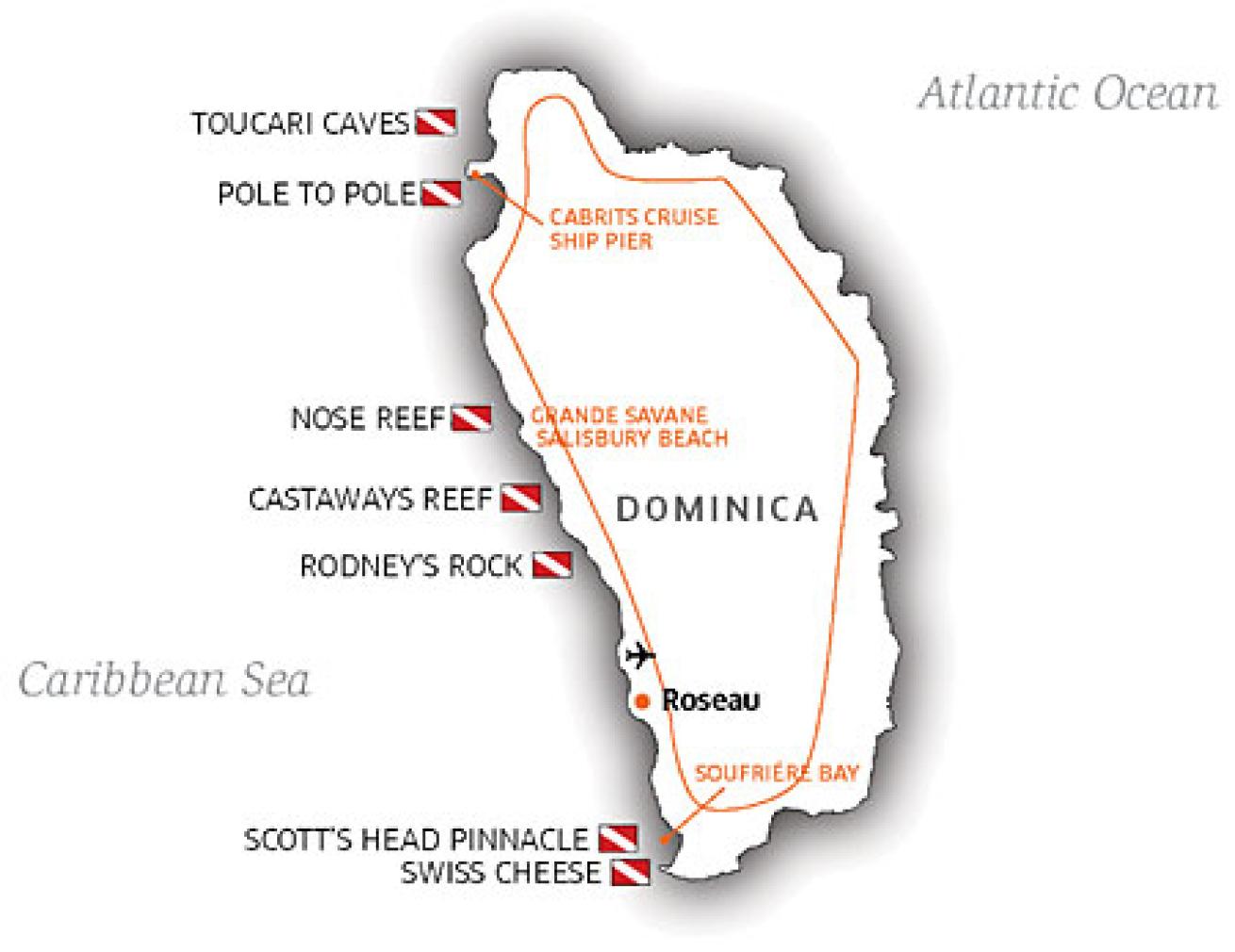
|
Weather: Mid-70s in winter; high 80s in summer. The rainy season is July to October.
Money Matters: Seven-night packages at a dive resort, including accommodation, breakfast and diving, range from $980 p.p., dbl. occ., to $1,200 p.p., dbl. occ. Currency is the Eastern Caribbean dollar (EC$); the exchange rate is about EC$2.67 to US$1. Departure tax is $30.
Get More: scubadiving.com/travel/caribbeanatlantic/dominica
Getting There: Most travelers fly into Dominica's Melville Hall Airport (DOM), on the island's northeast coast, one-and-a-half-hours from Roseau, where many people stay. International flights from the U.S. connect through Antigua, Barbados, St. Maarten, Guadeloupe and Martinique. Inter-island service via these hubs is offered by LIAT; LIAT and American Eagle also provide connecting flights to Dominica from Puerto Rico. If you've got some money to burn (at least $1,200 p.p.), you can charter a private plane to Canefield Airport (DCF), which is only minutes from Roseau.
Eastern Caribbean
|| |---|
|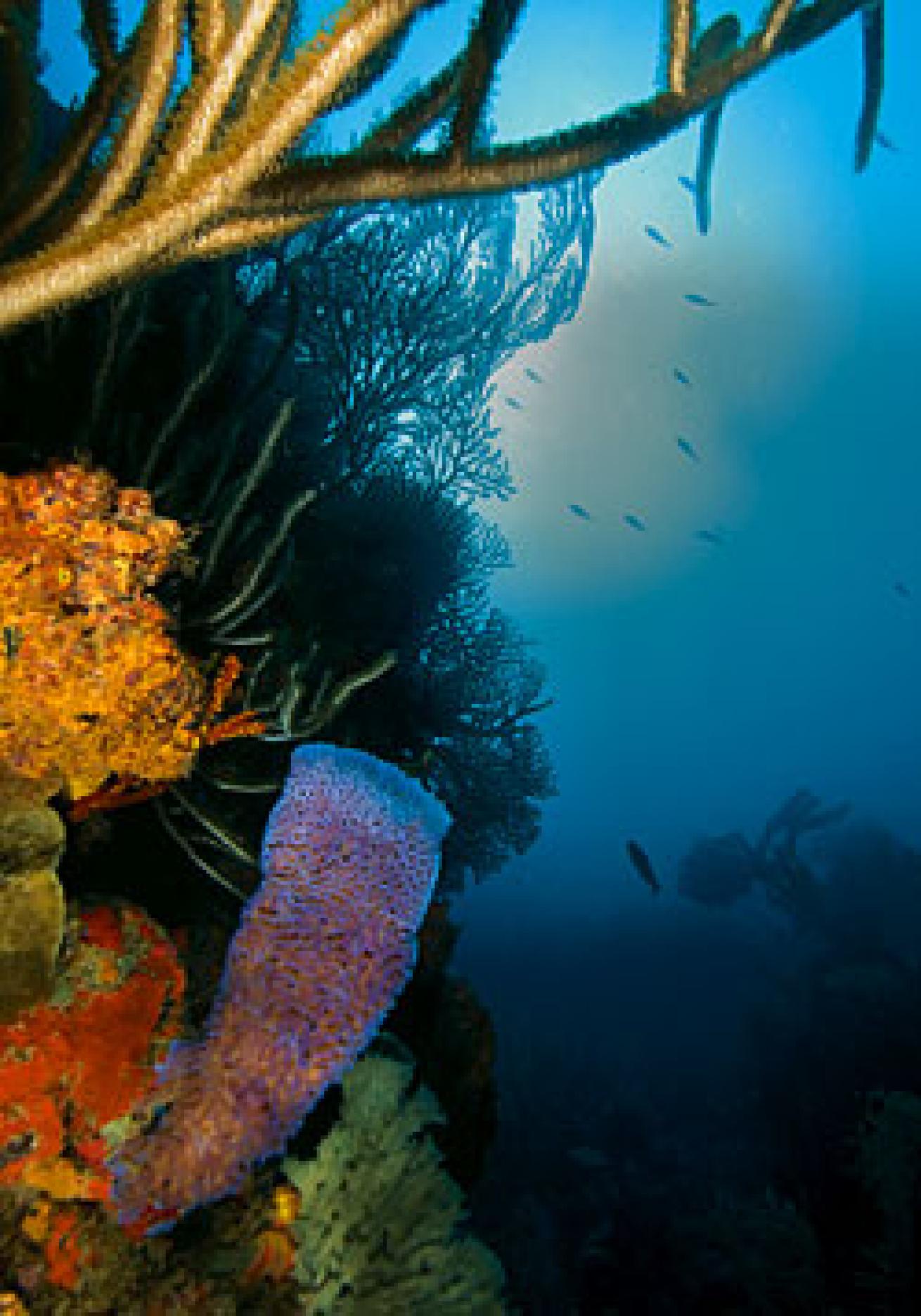
| | Photo by Steve Simonsen|
On Tobago, divers find top-notch reefs and marine life, ranging from tiny tropical fish to massive manta rays, and spectacular drift diving. Colorful sponges and abundant hard and soft corals thrive on sites like Japanese Gardens, on the island's northern end. On the southern end, shallow reefs and mini walls are the norm. Tobago also attracts large pelagics like sharks and dolphins. "If you're lucky," says Sea Divers' Tracy Kearns, "you'll encounter hammerheads and mantas."
Grenada has more than 30 named dive sites clustered along its southern tip--none more than a 30-minute boat ride away. Bianca C is a 600-foot luxury liner that lies off Grand Anse. "It is one of the largest shipwrecks in the world that's within recreational diving limits," says Peter Seupel, of Aquanauts Grenada.
St. Vincent and the Grenadines offers deep walls and shallow reefs. St. Vincent has become known for its plethora of rare creatures--including seahorses and frogfish--that keep photographers busy for days. "Critter Corner is a must-dive site for photographers," says Kay Wilson, of Indigo Dive.
Barbados offers gentle conditions for diving on its leeward coast. The island's claim to fame is the 360-foot Stavronikita, among the Caribbean's biggest wrecks.
St. Lucia diving centers on sites in its marine park, where marine life tends to be small, with lots of tropicals and invertebrates.
A live-aboard can get you to sites off Saba, St. Kitts and St. Eustatius (Statia). "Saba has beautiful underwater pinnacles--like Eye of the Needle--rising from the depths," says Jennifer Cumming, of Caribbean Explorer II. Most of St. Kitts' dive sites are clustered on the leeward shore and along its southeast peninsula. Off Statia, "Charlie Brown is our hottest new dive site," says Glenn Faires, of Golden Rock Dive Center. "The wreck is one of the most intact in the Caribbean."
||| |---|---|
| Snapshot<
table>
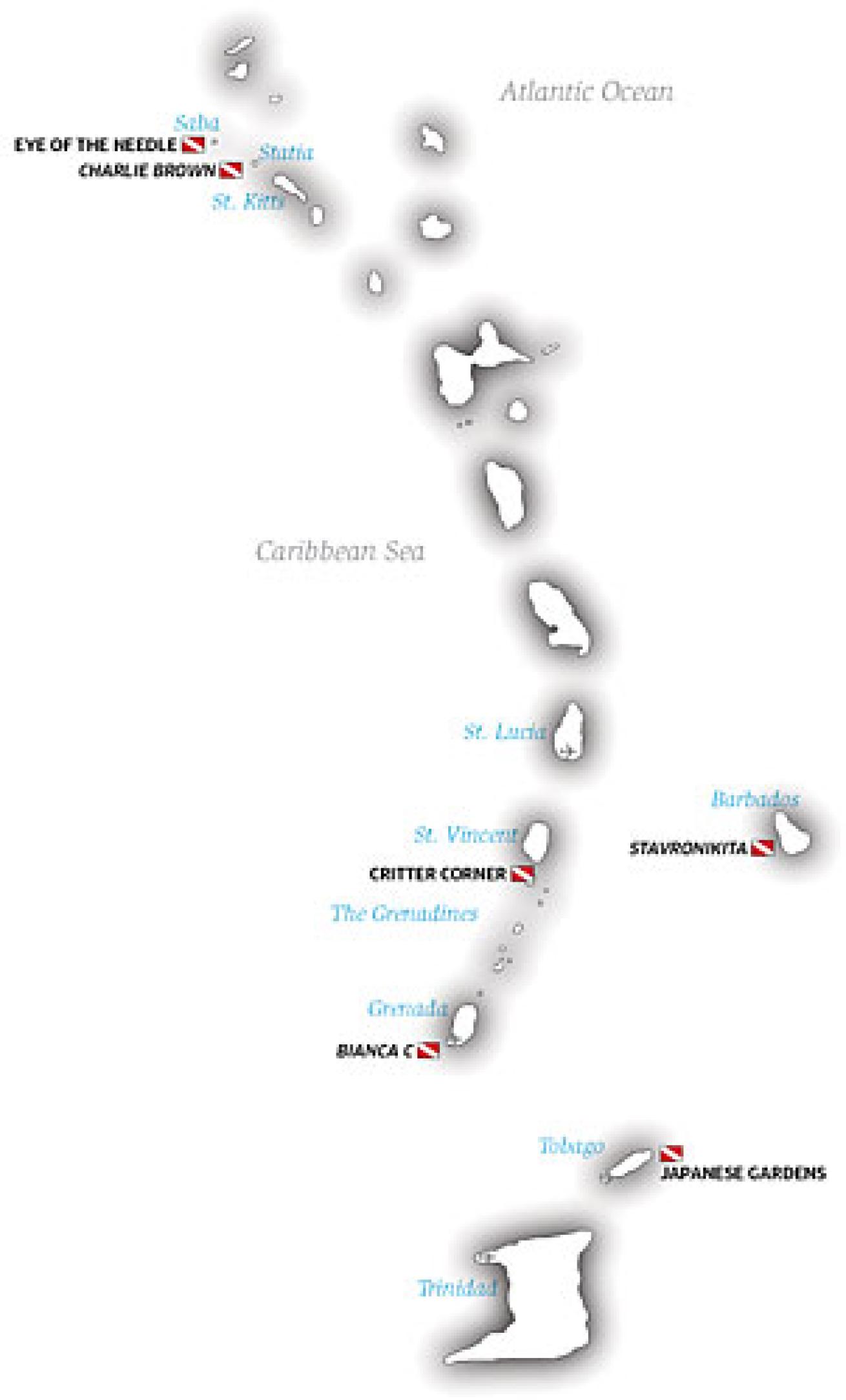
|
Weather: 70s in winter; 90s in summer. The rainy season is June to November.
Money Matters: Seven-night packages vary by island and resort, but count on spending about $1,000 p.p., dbl. occ. Seven-night live-aboard cruises to Tobago, Saba/St. Kitts and Grenada, including accommodation, meals and diving, start from $1,495 p.p., dbl. occ. Currency is the Eastern Caribbean dollar (EC$); the exchange rate is about EC$2.67 to US$1. Departure tax varies by island.
Get More: scubadiving.com/travel/caribbeanatlantic
Getting There: Delta flies nonstop to Crown Point, Tobago (TAB) from Atlanta, but from other U.S. gateways, you'll have to fly first to Port of Spain, Trinidad (POS). From Trinidad, several carriers offer connecting flights to Tobago. Nonstop flights to Grenada (GND) originate in New York. Nonstop flights to St. Lucia (UVF) originate in New York, Atlanta and Miami. All other islands are reached via connecting flights from various islands, including Montego Bay, Jamaica (MBJ) and San Juan (SJU).
Florida Keys
|| |---|
|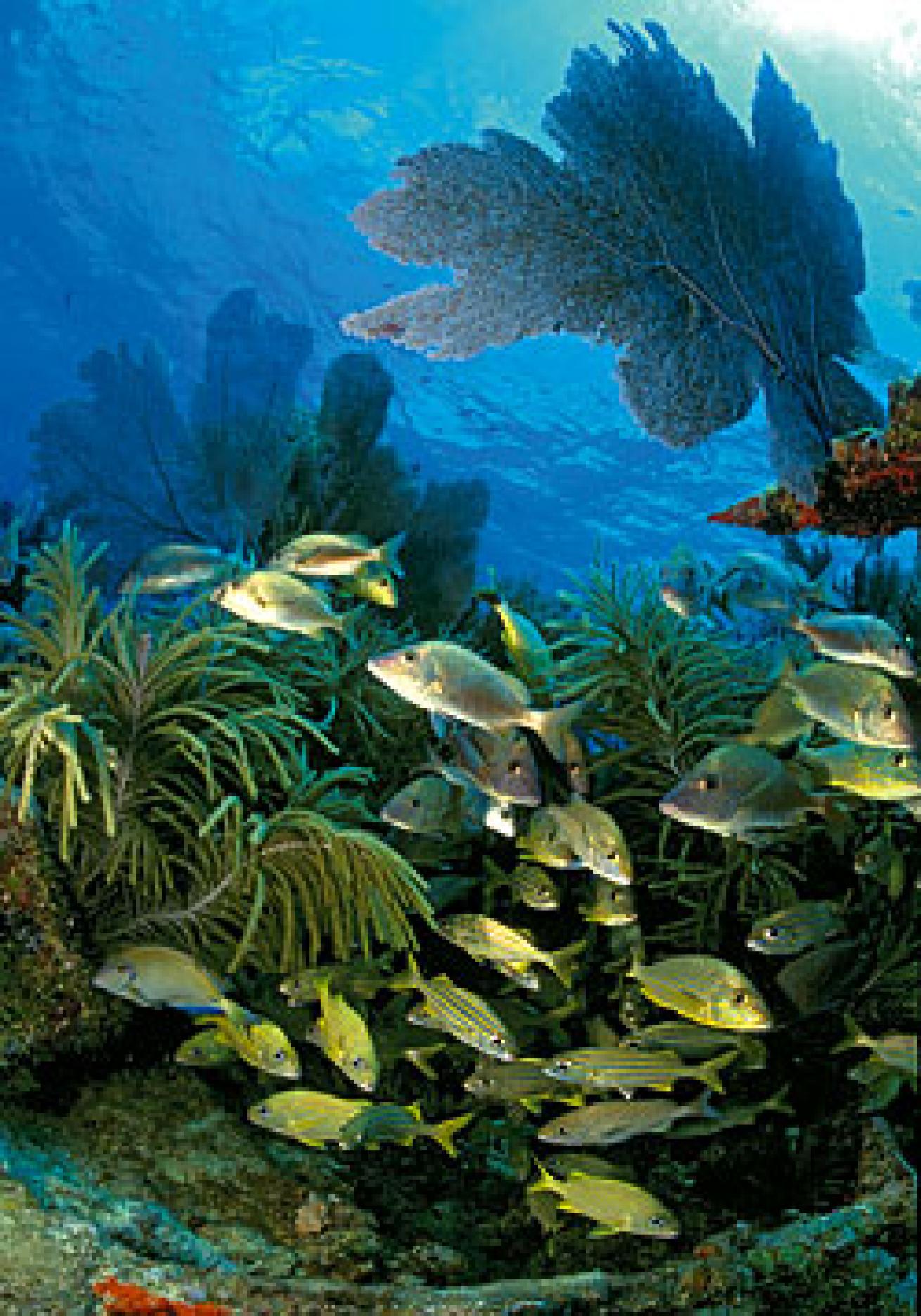
| | Photo by Stephen Frink|
From Key Largo and Islamorada to Marathon, the Lower Keys and Key West, these five distinct regions constitute what locals affectionately call "the Conch Republic" and all offer a great blend of wrecks and reefs. Every morning, experienced divers--and rookies cutting their teeth--challenge themselves by diving on sunken treasures like the immense, 510-foot U.S.S. Spiegel Grove, the U.S.C.G. Duane, the Eagle, the Benwood, the Thunderbolt and this month, the 523-foot U.S.S. Vandenberg (scheduled sink date May 15), the latest piece in what Florida Keys dive professionals call the "wreck trek" puzzle. In late mornings and afternoons, divers of all levels have the ideal, shallow chill-out dives at places like little dived Davey Crocker Reef and at Molasses Reef, a 10-square-mile gold mine of nearly three dozen sites, big on bottom times and swarming with schools of colorful tropical fish at every turn. You can also pop in on nurse sharks and moray eels under sand ledges and be shadowed by goliath groupers and barracudas.
To a person, dive professionals credit the establishment of sanctuary preservation areas, by the Florida Keys National Marine Sanctuary, for the abundance of marine life--both at the wrecks and on the reefs.
"The reefs have been protected for decades now," says Jason Schwenke, general manager of Florida Keys Dive Center, in Tavernier, Fla., just south of Key Largo. "It's hard to find more marine life anywhere else in the world. Sinking a number of different wrecks (has taken) pressure off the reefs and has attracted more marine life and divers."
On your off-gassing day, 24 hours in Key West is ideal. There are more sandy beaches here than in the rest of the Keys, and there's plenty of Conch culture. Watching the nightly sunset carnival of about two dozen street performers along the esplanade near Mallory Square is not to be missed. Don't get outta Dodge until you've visited the Ernest Hemingway Home & Museum, had an adult beverage or two at Capt. Tony's Saloon or sampled chocolate-covered Key Lime pie on a stick.
||| |---|---|
| Snapshot<
table>
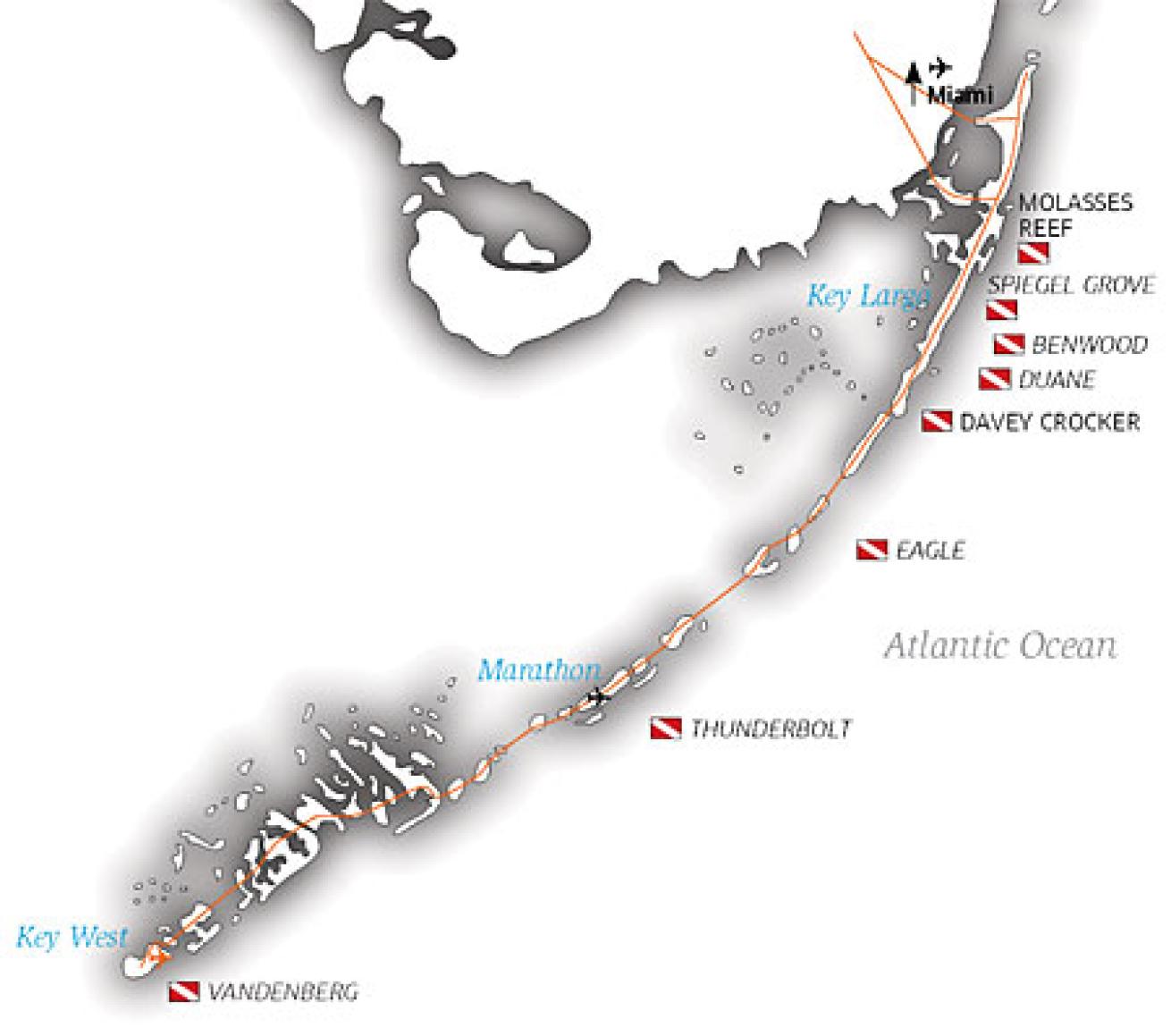
|
Dive Conditions: Water temps are in the low 70s in winter; high 70s to low 80s in summer. Vis averages between 40 and 75 feet, with 100 feet on calm days.
Weather: 50s to 60s in winter; 80s to 90s in summer.
Money Matters: Three-night weekend packages at a dive resort, including accommodation, continental breakfast and diving, start from $650 p.p., dbl. occ.
Get More: scubadiving.com/travel/northamerica/floridathefloridakeys
Getting There: Options abound for getting to the Florida Keys, including flying into small airports at Key West and Marathon and then driving. But by far the easiest way is flying into Miami (give yourself plenty of time at baggage claim before your gear is off-loaded), then renting a car and taking in the ocean views on the drive southwest. What's even better is that with one road--U.S. 1--it's nearly impossible to get lost. Pay close attention to the roadside mile marker signs to keep track of exactly where you are.
North Carolina
The U-352, the sunken, fish-laden World War II German submarine off Cape Lookout, has long been the headliner here in the Crystal Coast--waters once plied by the infamous pirate, Blackbeard. And with good reason: It's small enough to explore in one dive and its hatches are literally bursting with small fish life.
But the USCGC Spar is a fast-rising star among local and visiting divers here, where the quantity of wrecks inspired the bittersweet title "the Graveyard of the Atlantic." The Spar is a United States Coast Guard cutter in 110 feet of water, sunk purposely four years ago as part of the state's artificial reef program.
"Once you descend, you learn you'll likely never see so many fish on a wreck again," says Nema Triplett, of Olympus Dive Center in Morehead City, N.C. "Last year it was the site for spotting sand tiger sharks. There are also schools of spadefish hanging around the conning tower and stingrays playing in the sand."
The Spar, U-352, Papoose, USS Schurz and the Caribsea--and the numbers of sand tiger sharks--all make undersea explorers say nothing could be finer than to dive in Carolina. Besides the wrecks, other experiences like rock ledge--or "live bottom"--diving is also catching on with Crystal Coast divers. Robert Cox, of Diver Down Scuba Diving Services in Morehead City, says this kind of diving is one of the Crystal Coast's hidden treasures. The ledges--2- to 5-foot breaks in the sand--house lairs of lobsters, groupers, stingrays, angelfish and turtles. And topside, Southern hospitality reigns and the combination of beaches (especially on Shackleford Island), barbecue and beer is hard to beat. You can recount a great dive day with your buddies while savoring the home-style flavors of Floyd's 1921 or the pizzas at Beach Bumz, both in Morehead City. Blackbeard buffs can satisfy their curiosity by visiting nearby Beaufort, the town he once lived in--when he wasn't plundering and pillaging on the high seas. With the region's weather being what it is, prime time to plunge into Crystal Coast waters is from April until September.
||| |---|---|
| Snapshot<
table>
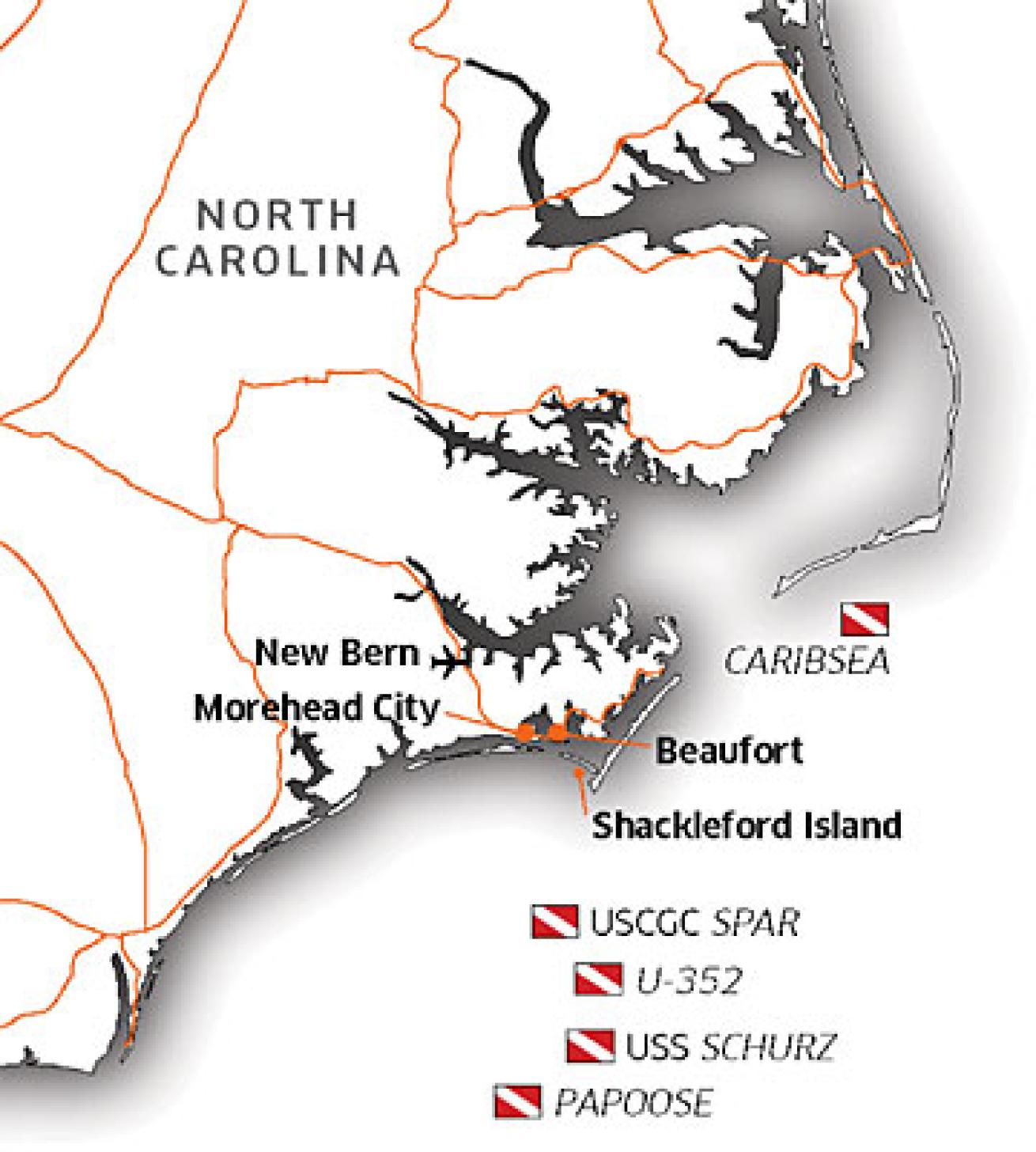
|
Weather: Spring and fall temps range from the 60s to 70s and reach the 90s during summer.
Money Matters: Half-day charters (usually one dive) are $60 p.p.; full-day charters (two dives at two locations) are $125 p.p.
Get More: scubadiving.com/travel/north_america/southeastern_southcentral_us
Getting There: The entrance to the salty cemetery is Morehead City, a three-hour eastward drive from the Raleigh/Durham International Airport. But if you prefer a shorter drive and don't mind squeezing yourself and your gear into a small plane, New Bern, N.C., is the nearest airport to Morehead City and is served by both US Airways and Delta.
Puerto Rico
|| |---|
|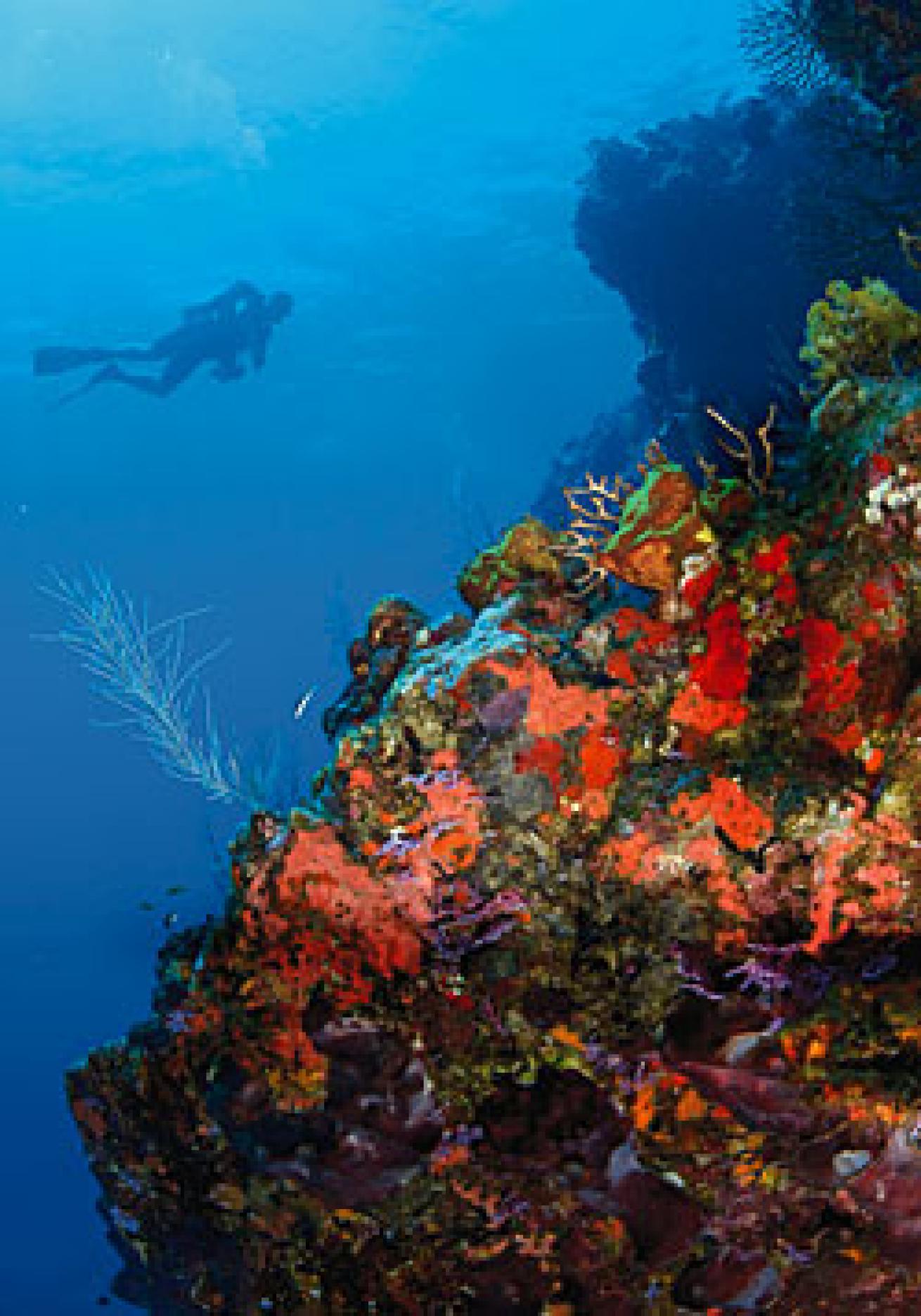
| | Photo by Steve Simonsen|
Rincon is where land-based dive operators run trips westward to Desecheo Island, where phenomenal visibility and a treasure chest of dive sites await. One of them is Las Cuevas (The Caves). Because it's shallow, with a max depth of only 30 feet, Las Cuevas is the ideal, chillout second dive, with plenty of canyons and arches to explore.
"It's a series of about seven to eight swim-throughs," Barbieri says. "It's a cool little playground where 20 divers can fit inside. Once you're there and looking out, it has these triangular-looking natural windows. It's like you're looking out from inside of Darth Vader's mask."
And if you ever played the board game Candyland in your childhood and remember all its odd-shaped mounds, then you'll quickly realize why there's a Desecheo Island dive site named in its honor. That's what the coral formations resemble, and you'll also see plenty of tropical fish. The aptly named Sea Fan City hosts a tremendous array of purple and white sea fans and barrel sponges at a 45-foot garden spot in white sands.
Southern and eastern Puerto Rico also feature great diving. La Parguera, on the island's southwest edge, features at least two-dozen spots. Both Black Wall and Efra's Wall have forests of black coral and Fallen Rock is a likely spot for encounters with pelagics. Eastward, Puerto Rico has two smaller satellite islands ripe for diving--Culebra and Vieques. The establishment of the Culebra Marine Reserve Park ensures that its dive sites are protected. Cayo Lobito is a 75-foot dive where nurse sharks and jacks are plentiful, while Cayo Raton is known for smaller residents.
Vieques has been in the news this decade--U.S. Naval bombing exercises drawing the ire of Puerto Rican nationalists--more than for what lies beneath the surface. Unlike other areas of Puerto Rico, there's ample opportunity for shore diving on Vieques. Boat trips shuttle divers out to Angel Reef, where, because it's seldom dived, corals are in excellent shape, and Patti's Reef, which features more--yeah, you guessed it!--swim-throughs.
||| |---|---|
| Snapshot<
table>
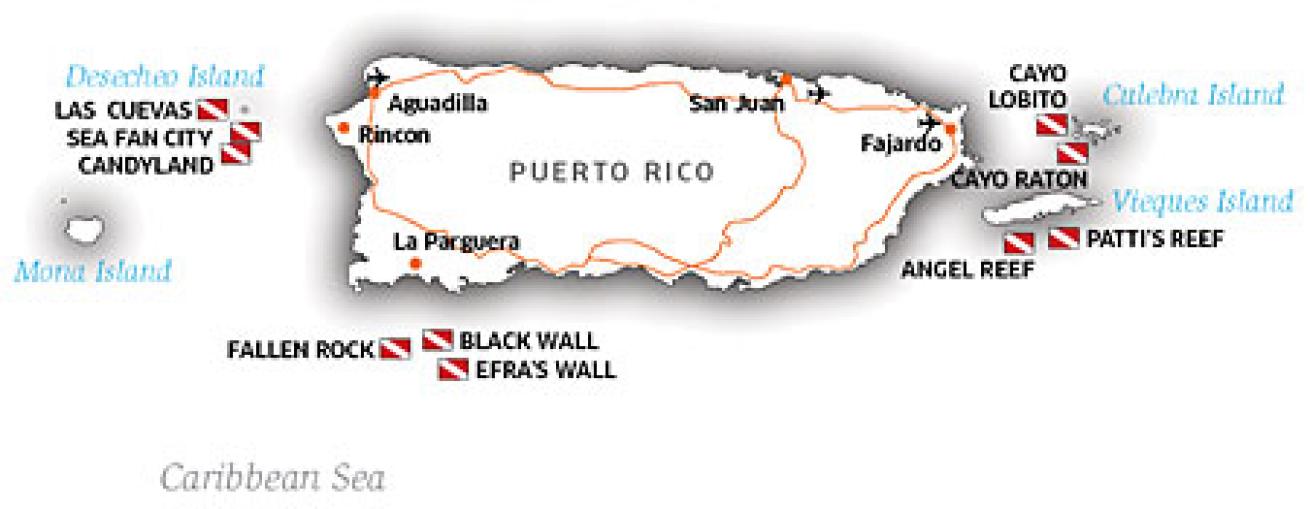
|
Weather: Mid-70s in winter; mid-80s in summer.
Money Matters: Seven-night packages, including accommodation and diving, start from about $800 p.p., dbl. occ. Currency is the U.S. dollar. There is no departure tax.
Get More: scubadiving.com/travel/caribbeanatlantic/puerto_rico
Getting There: Plenty of airlines serve San Juan (SJU) from the mainland, but if you're looking to jump-start your diving, just fly to Aguadilla (BQN)--Jet Blue has nonstop flights there from New York and Orlando--then hop in a rental car and head half an hour south to Rincon. To reach Culebra and Vieques from Puerto Rico, Air Flamenco, Air Sunshine and Vieques Air Link fly to both places from Fajardo and San Juan. Round-trips from San Juan to Vieques are about $130 on average, but are considerably cheaper from Fajar- do. Check with those airlines about their baggage allowances. If you prefer a more leisurely trip and don't want to squeeze your body and gear into a small plane, scheduled ferry services are available.
Riviera Maya
|| |---|
|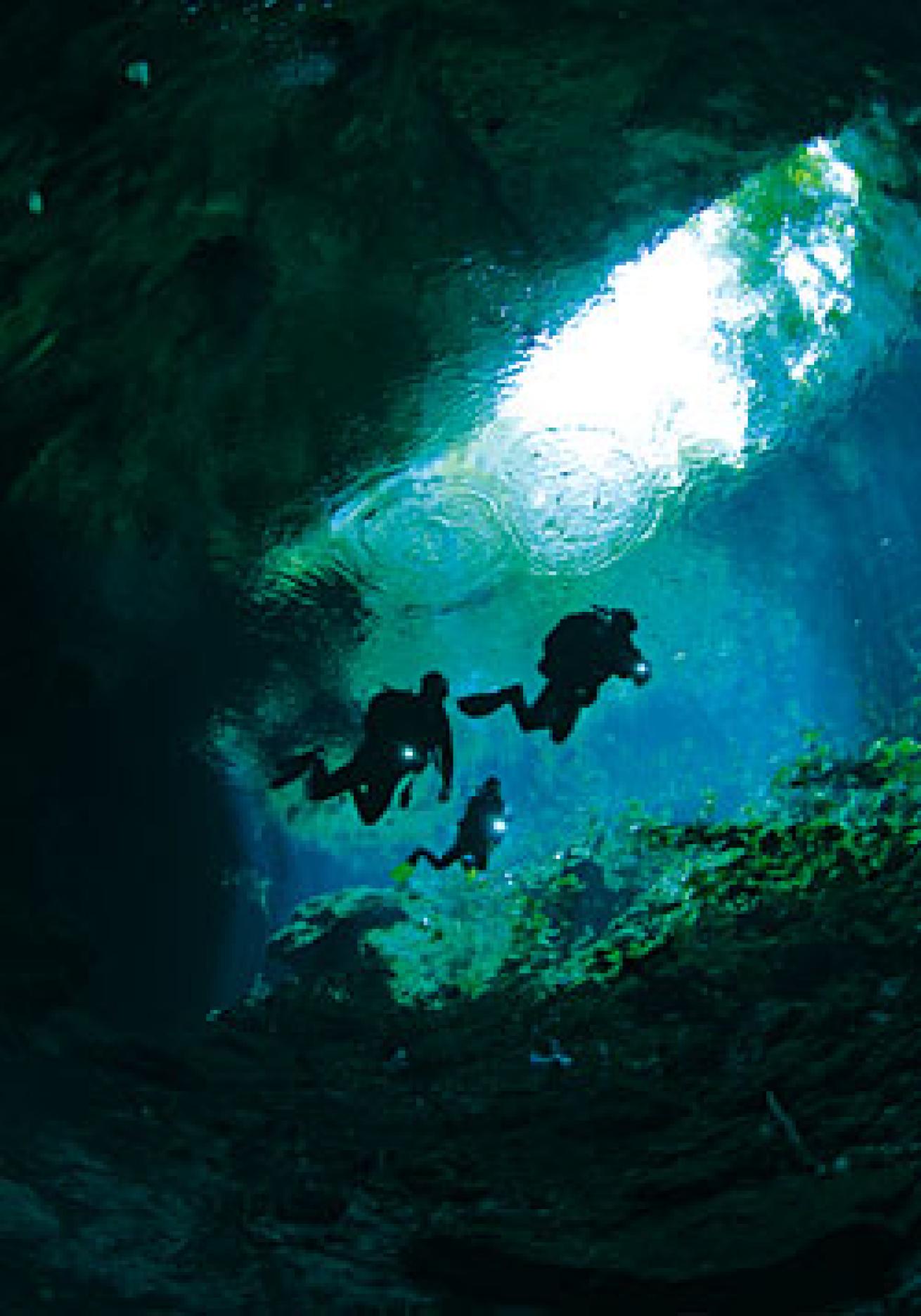
| | Photo by Steve Simonsen|
The most unique aspect of diving the Riviera Maya has to be the omnipresent cenotes--sinkholes formed by collapsing underground caves. The ancient Maya believed these cenotes were portals to the underworld, or Xibalba. They're your gateway to the coolest diving in the Yucatan, but you'll need a qualified cenote guide to show you around.
"Diving the cenotes is the closest experience to space travel, because of the amazing visibility of the fresh water," says David Tomlinson, owner of Abyss Dive Center and Training Facility in Playa del Carmen. "They are beautiful and show you formations that normally can not be seen on land. Also, snorkelers can join in on the fun as they watch the divers enter the underwater caverns."
But Cynthia Lazo Sepulveda of the Riviera Maya Tourism Board cautions divers from overlooking the region's reefs. "The cenotes are perhaps the most famous dive sites, but the Riviera Maya is also home to the largest coral reef in the western hemisphere, the Great Mesoamerican Reef."
Tomlinson offers up some of his must-dives: "I like Tortuga, a dive site with a ton of large green turtles; Jardines, a garden of coral with lots of sea life; and Moc Che, a deep and shallow site that has swim-throughs, sea life and great coral."
The Riviera Maya's strongest draw is perhaps most evident when the dive day's through. There are tons of things to do when you're not getting wet, from exploring the ruins of Mayan life at Chichen Itza (which you can do in a day), Coba and Tulum, to immersing yourself in the nightlife in Playa del Carmen. There are also miles of luxuriant beaches, tons of watersports activities, shopping and dining.
||| |---|---|
| Snapshot<
table>
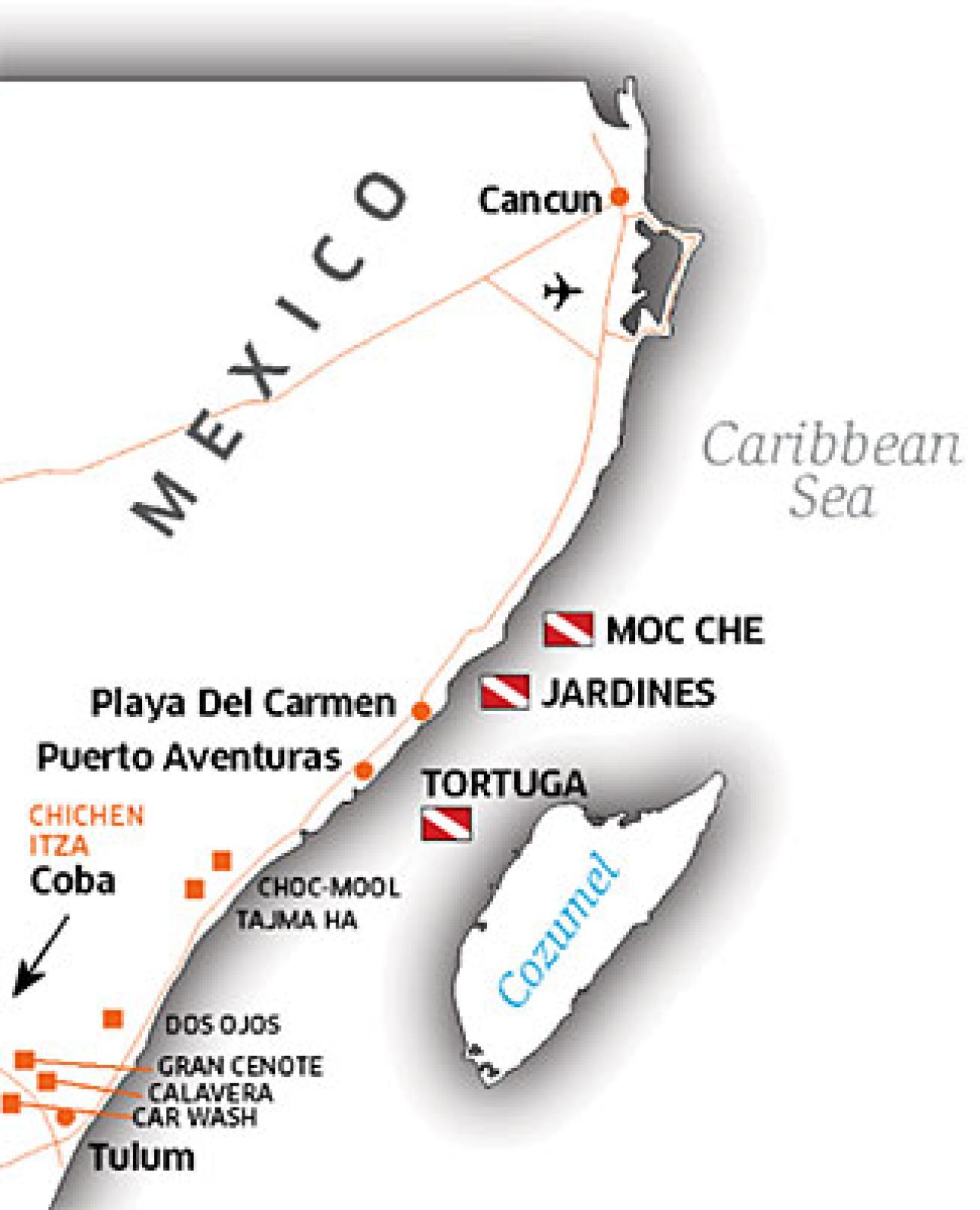
|
Weather: 70s in winter; 80s in summer. May through November is the rainy season.
Money Matters: Seven-night packages, including accommodation, breakfast and diving, start from $550 p.p., dbl. occ. Currency is the Mexican peso (MXP), although the U.S. dollar is widely accepted. Exchange rate is approximately 10 pesos to US$1, though it fluctuates. The departure tax is usually included in the price of your airline ticket.
Get More: scubadiving.com/travel/caribbeanatlantic/riviera_maya
Getting There: Plenty of airlines serve San Juan (SJU) from the mainland, but if you're looking to jump-start your diving, just fly to Aguadilla (BQN)--Jet Blue has nonstop flights there from New York and Orlando--then hop in a rental car and head half an hour south to Rincon. To reach Culebra and Vieques from Puerto Rico, Air Flamenco, Air Sunshine and Vieques Air Link fly to both places from Fajardo and San Juan. Round-trips from San Juan to Vieques are about $130 on average, but are considerably cheaper from Fajar- do. Check with those airlines about their baggage allowances. If you prefer a more leisurely trip and don't want to squeeze your body and gear into a small plane, scheduled ferry services are available.
Turks & Caicos
|| |---|
|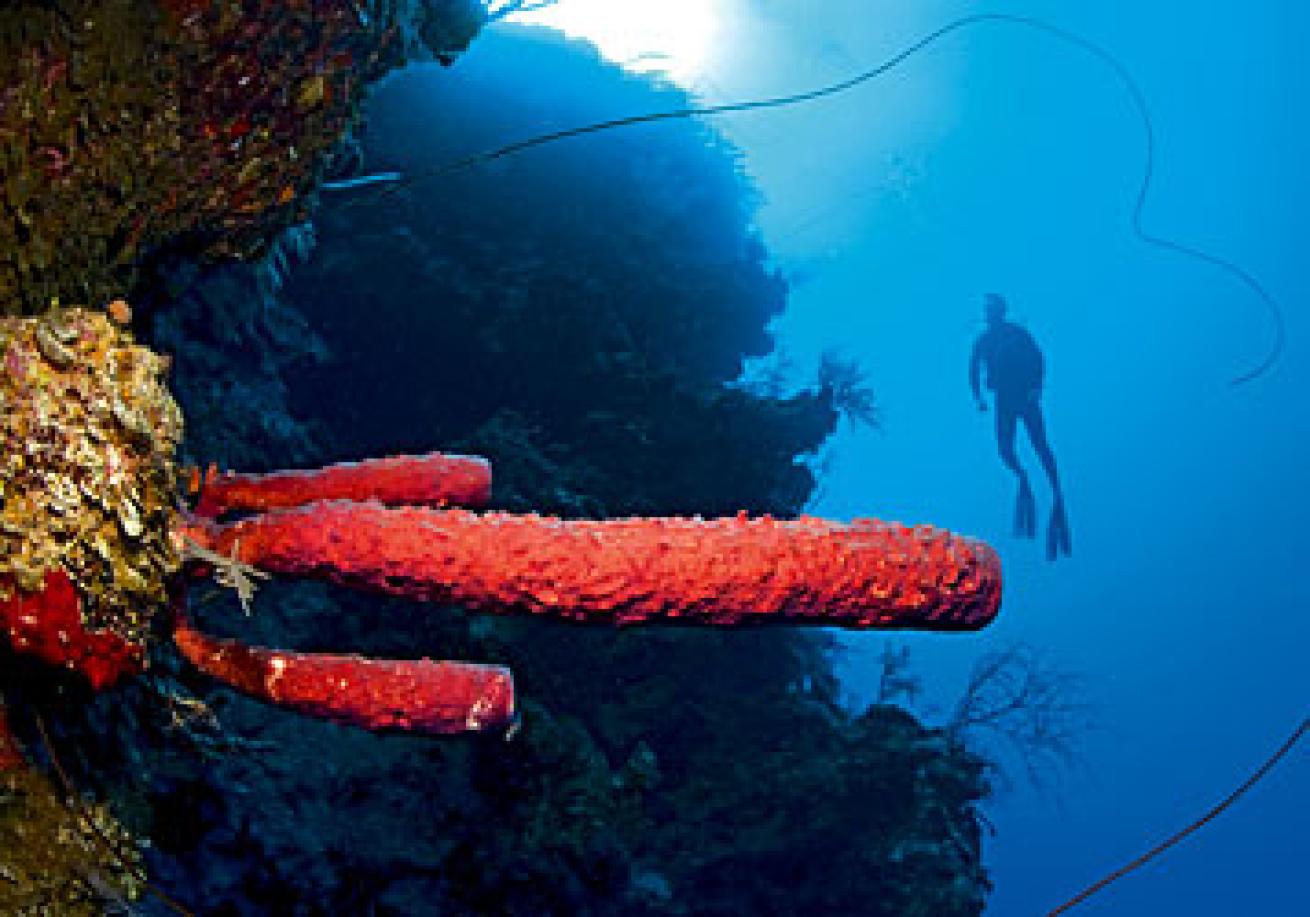
| | Photo by Stephen Frink|
Providenciales, commonly called Provo, is perfect for divers who like to play both above and under water; the island offers a wide array of resorts, restaurants and activities. On Provo's north shore, the 14-mile barrier reef bordering Grace Bay is one of three main diving areas on the island, as are Northwest Point, a national marine park off the west coast, and uninhabited out islands like West Caicos.
At least once a week, most of Provo's dive operators make the hour-long trip to West Caicos, 10 miles southwest of Provo. Here, divers find a dizzyingly steep drop-off. Choice sites include Elephant Ear Canyon, packed with tube sponges and black coral (though the giant elephant ear sponge for which it's named is long gone).
Provo's renowned Northwest Point offers more than a dozen sites including Amphitheater, which boasts a pageant of fish--parrotfish, clown wrasse, angelfish--plus chance encounters with Caribbean reef sharks.
On Grand Turk, one site, McDonald's, is named for the graceful coral arch on the wall's lip, a gateway to the site's showy drop-off. McDonald's is emblematic of the diving off Grand Turk--shallow reefs that give way to a striking wall. Along the way, you'll encounter hawksbill turtles, good-sized Nassau groupers, healthy corals and mammoth sponges.
Tiny Salt Cay, eight miles southwest of Grand Turk, is home to only about 70 people. You can stay on Salt Cay and dive nearby sites or make the trip from Grand Turk if your operator is willing. Dive sites here include the HMS Endymion, a historic wreck 16 miles south of the island, Kelly's Folly, whose undulating coral gardens slope down to a precipitous drop-off, and Northwest Point, where black corals cling to the wall and tiger groupers hang out in cracks. "We have something very special here," Debbie Manos, of Salt Cay Divers, says. "And we hope that it will never change."
Between February and April, hundreds of migrating North Atlantic humpback whales pass in close range of Grand Turk and operators offer snorkeling encounters with the animals.
||| |---|---|
| Snapshot<
table>
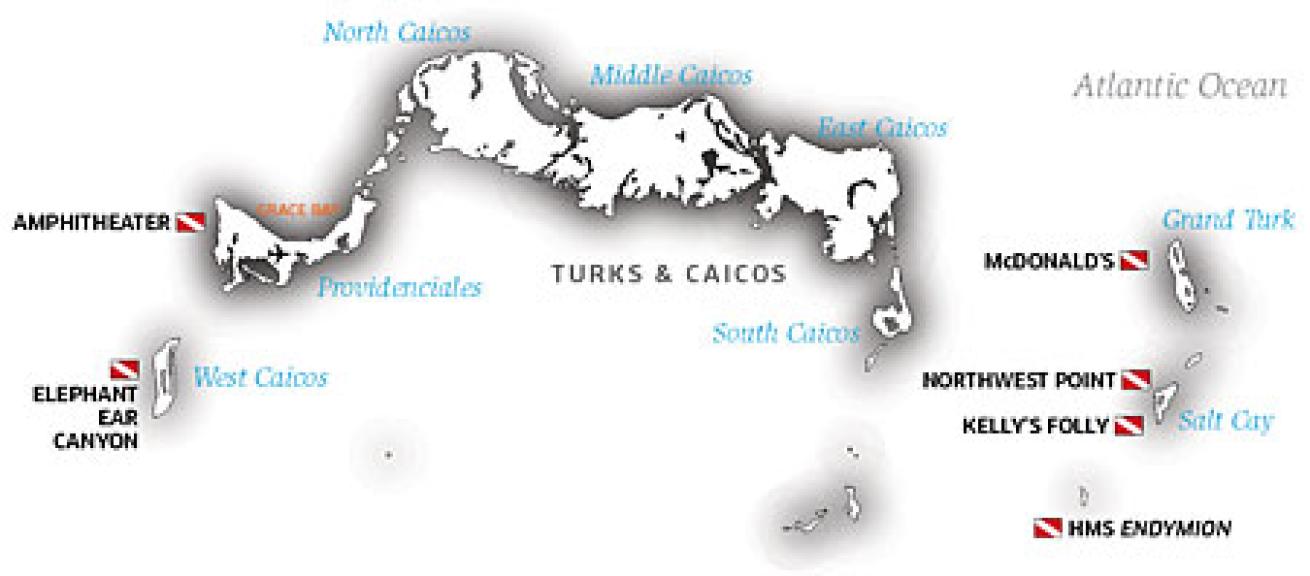
|
Weather: Mid-70s in winter; mid-80s in summer.
Money Matters: Seven-night packages, including accommodation, breakfast and diving, start from $900 p.p., dbl. occ. Currency is the U.S. dollar. Departure tax is $35, usually included in the price of airline tickets.
Get More: scubadiving.com/travel/caribbeanatlantic/turks_and_caicos
Getting There: You'll fly into Providenciales (PLS); if you're headed for another island, you'll take a commuter flight. Nonstop flights to Provo originate in Miami and New York.
U.S. Virgin Islands
|| |---|
|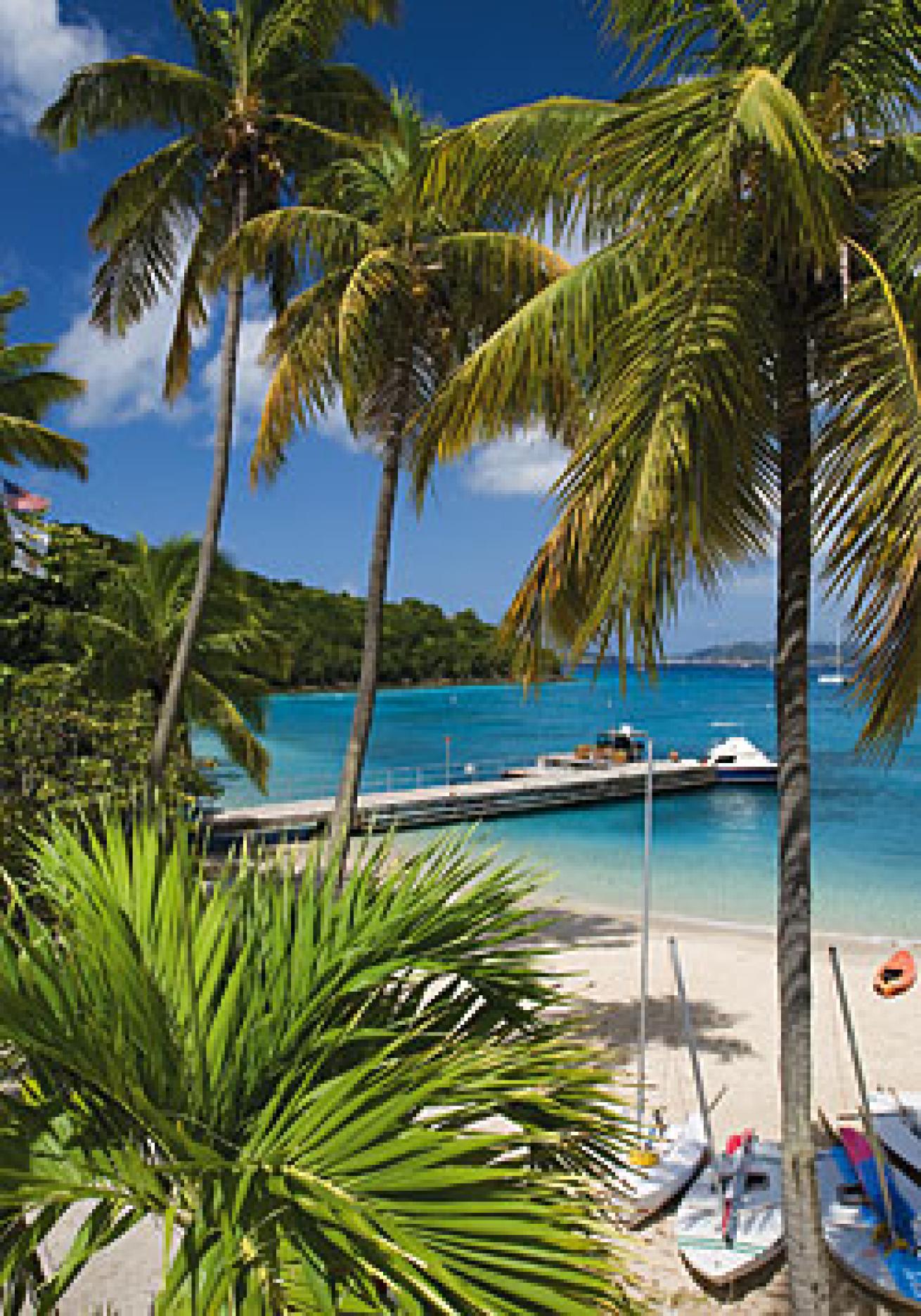
| | Photo by Steve Simonsen|
Off St. Thomas, don't miss Cow and Calf Rocks, a maze of tunnels, swim-through archways and caves painted in encrusting sponges. Advanced divers will love Sail Rock, a trio of current-swept pinnacles swarmed by schooling horse-eye jacks. The island is also home to the wreck of the Wit Shoal II, a colorful wreck with railing and rigging dripping with orange cup corals in 25 to 90 feet of water.
On St. John, where half the island is a national park including the waters surrounding it, divers of all skill levels love Congo Cay, where topside cliffs plunge into the water, then break up into a sloping boulder field covered with hard and soft corals. Keep your eyes open for hawksbill turtles and spotted eagle rays. At legendary Carval Rock, divers can circumnavigate the entire formation, swimming through canyons in the rock.
The diving off St. Croix includes shallow reefs and steep drop-offs that lead divers to the wall. Two of the best dives are located between Cane Bay and Christiansted at the mouth of Salt River Bay. Salt River East and Salt River West are separated by a deep chasm. Salt River East drops vertically, and you'll find colonies of yellow tube sponges and schools of blackbar soldierfish. Separated by several hundred yards and a deep submarine canyon, lies Salt River West. This dive begins in 20 feet of water and abruptly drops to 90, where it continues sloping away gradually to the abyss.
Don't miss Christiansted, St. Croix's capital city, with its Danish colonial architecture featuring arched covered walkways filled with shops and restaurants. St. Thomas is home to one of the Caribbean's most stunning cruise ship harbors--Charlotte Amalie. Shop for trinkets here in restored Danish warehouses.
||| |---|---|
| Snapshot<
table>
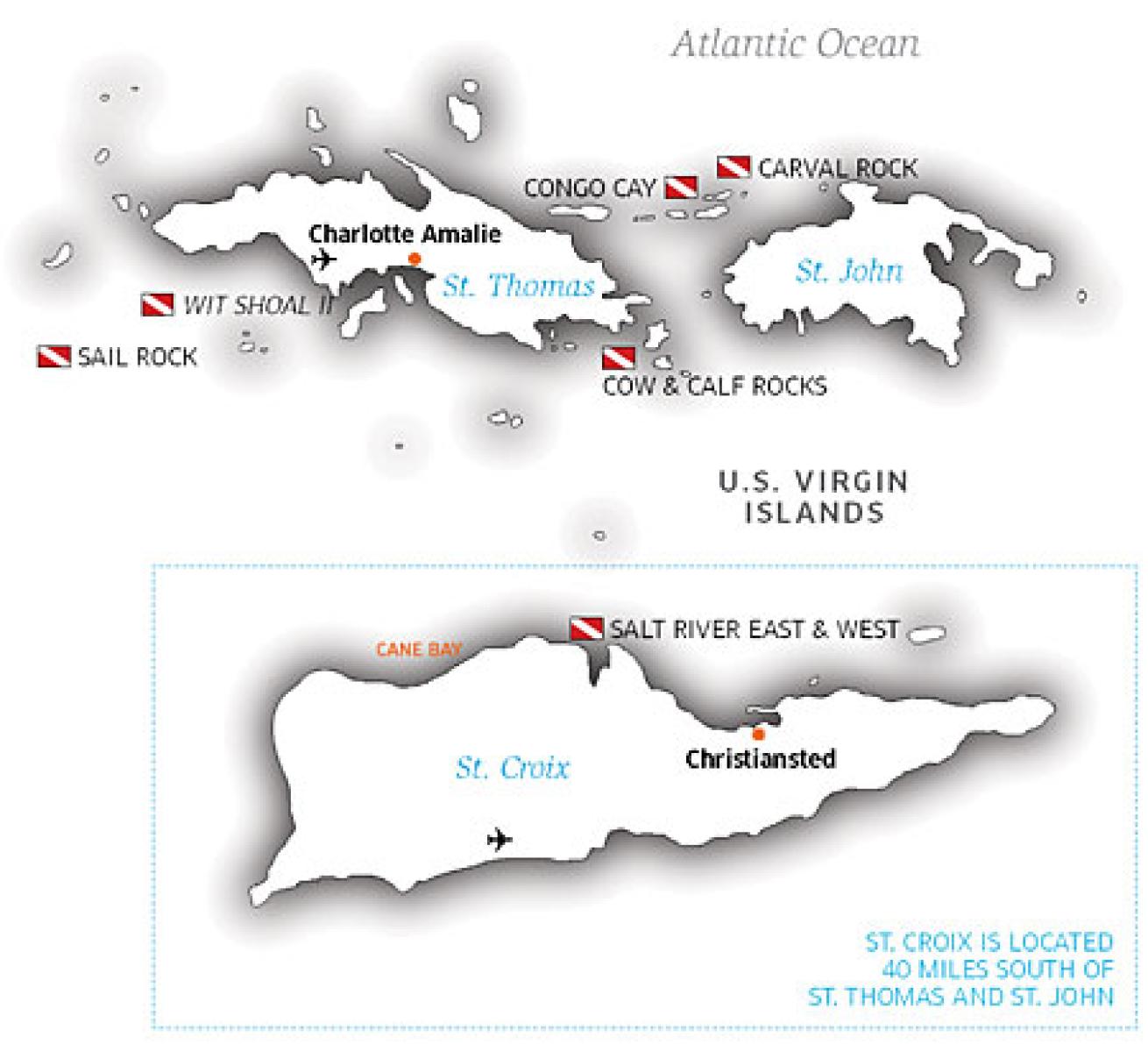
|
Weather: Low 60s to mid-70s in winter; mid-80s in summer summer.
Money Matters: Seven-night packages, including accommodation, breakfast and diving, run about $1,200 p.p., dbl. occ. Currency is the U.S. dollar. Departure tax is $3, usually included in airline ticket prices.
Get More: scubadiving.com/travel/caribbeanatlantic/us_virgin_islands
Getting There: Nonstop flights to St. Thomas (STT) and St. Croix (STX) originate from several U.S. gateways, including Atlanta, Miami, New York, Newark, Charlotte and Philadelphia. Several inter-island carriers offer connecting service between St. Thomas and St. Croix. St. John does not have an airport--you must fly to St. Thomas and then take a taxi to the ferry terminal/dock and catch an inter-island ferry to St. John.
|||| |---|---|---|
|<
table>
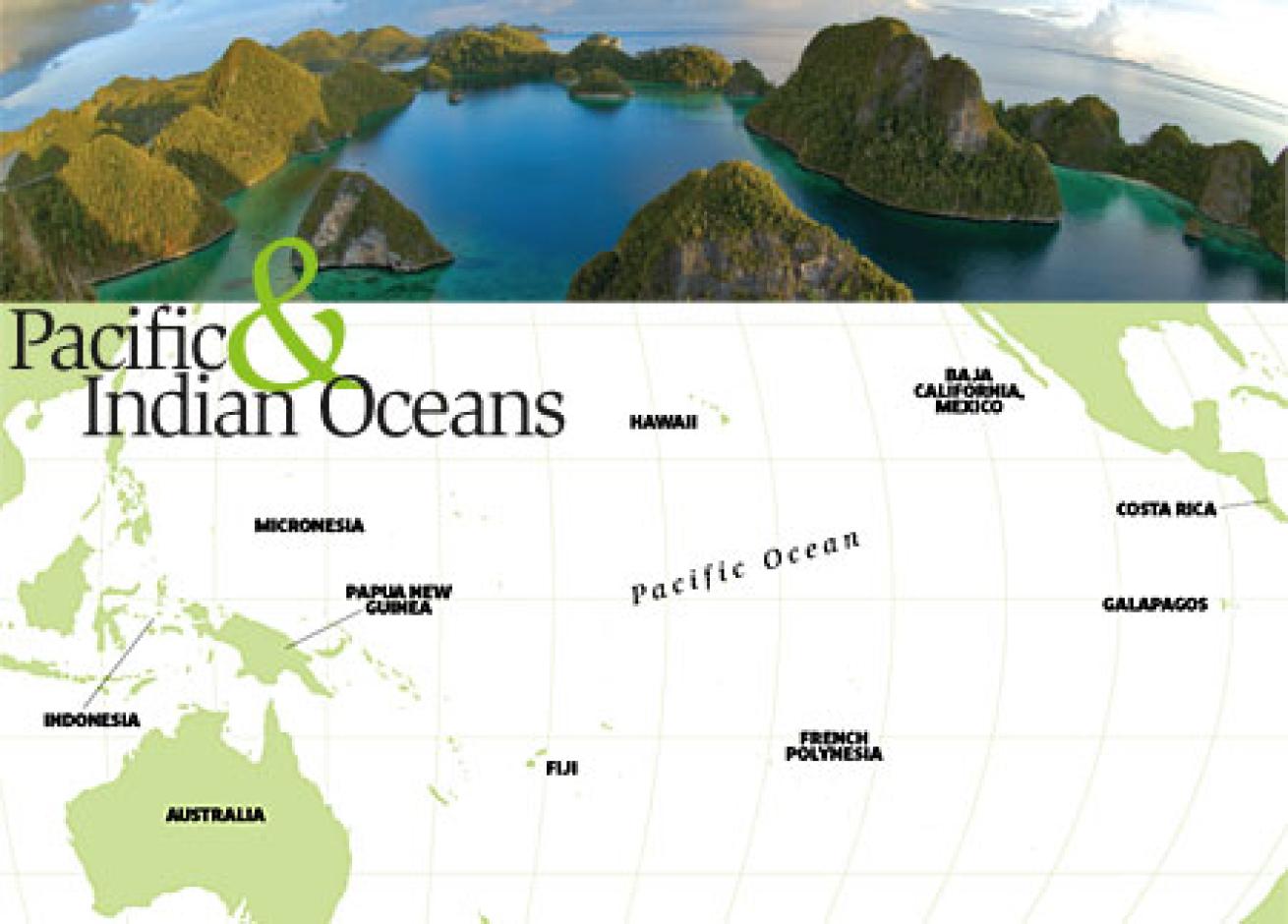
| | Photo by Berkley White|
Nature swims wild, from Indonesia's Coral Triangle--constantly confounding scientists cataloguing new species--and Papua New Guinea's virgin reefs, where topside, tribal traditions remain intact. Want more? How about Fiji's soft corals, Micronesia's World War II wrecks and French Polynesia's sharks? How about the biodiversity of Costa Rica's Cocos Island or high voltage diving with hammerheads in the Galapagos Islands? And Australia? Three words: Great Barrier Reef. Yes, many Pacific and Indian Ocean destinations take nearly 24 hours of flying to reach. But what's sacrificing one day when a lifetime of memories await?
Australia
|| |---|
|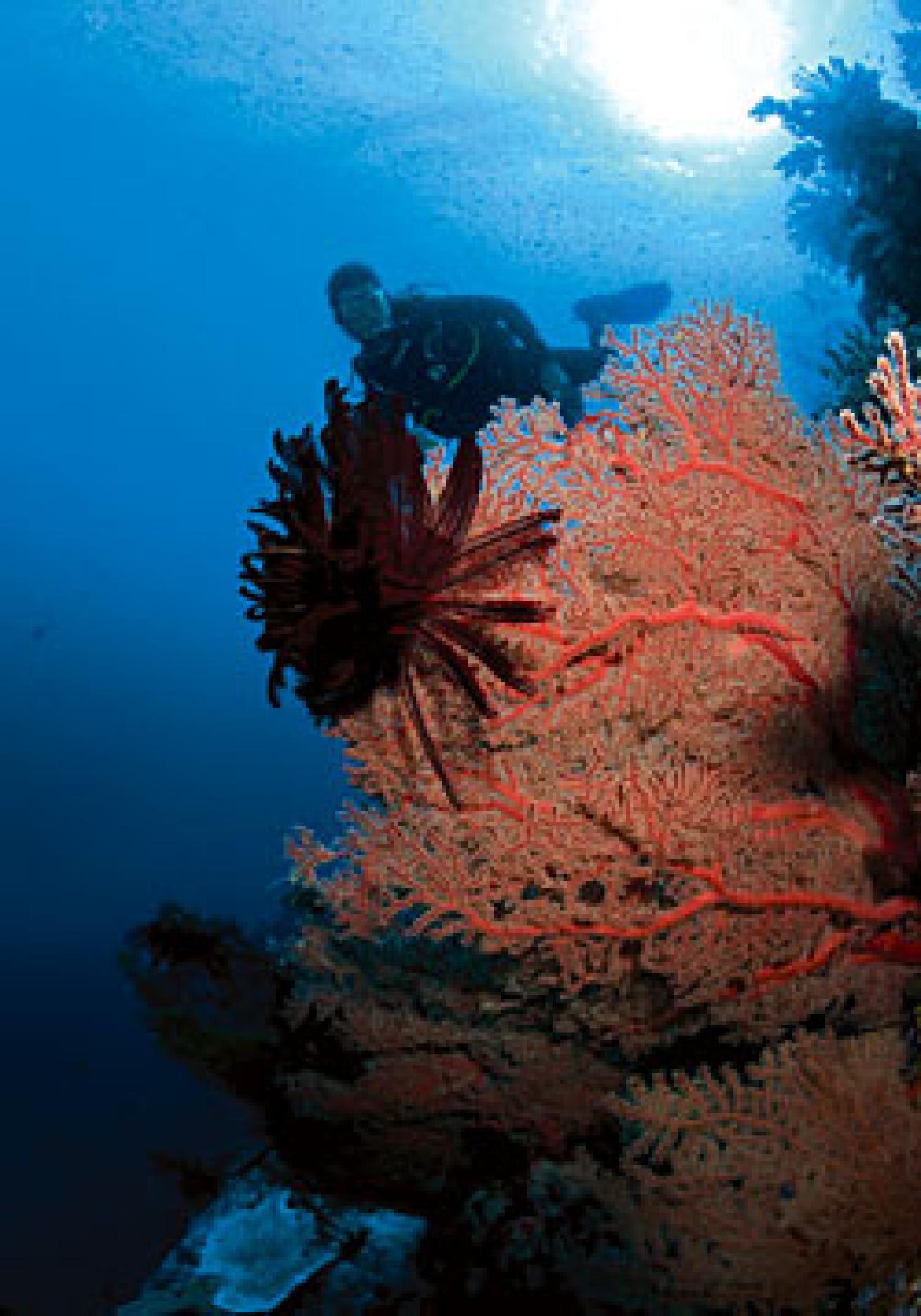
| | Photo by Stephen Frink|
Then, wrap your head around this construction project: The GBR is the grandest structure made by any living things--in this case, billions of microscopic coral polyps. It's a common misperception that this slice of blue heaven is over-dived. The Australian government, which oversees the Great Barrier Reef Marine Park, protects most of the treasured waters, so everyone can dive in.
"The management of the Great Barrier Reef Marine Park has led to improved dive conditions," says Mike Ball, owner of Mike Ball Dive Expeditions, a leading GBR live-aboard operator. "More and better dive sites have been opened due to the Cod Hole and Ribbon Reefs operators installing new dive moorings."
So how do you dive the GBR?
Not in a two-tanker, not from the shore and definitely not by schlepping your gear every day for a week onto day boats. Instead, take a week or two on a live-aboard out of Cairns and cruise the reefs, or pick an island resort or two, such as one on the Whitsunday Islands, far from shore.
While Cairns has about 20 reefs within a couple hours' boat ride, you can't get as far as Ribbon Reefs, which boasts must-dive spots like Cod Hole, with its giant potato cod encounters, or Steve's Bommie, near Lizard Island, where you can join the thick fish traffic in a swim-through cave, or watch for lionfish or nudibranchs, in a day. If you're craving the adventure of being even farther from shore, book a live-aboard trip to the Coral Sea, for its wall diving and shark feeding at Osprey Reef, or to the Far Northern region of the GBR, where green turtles are plentiful. And if you're all about the big animal encounters, you'll definitely want to head to Ribbon Reefs in June and July when curious dwarf minke whales migrate there from Antarctica and converge around dive boats and divers alike.
|| |---|
|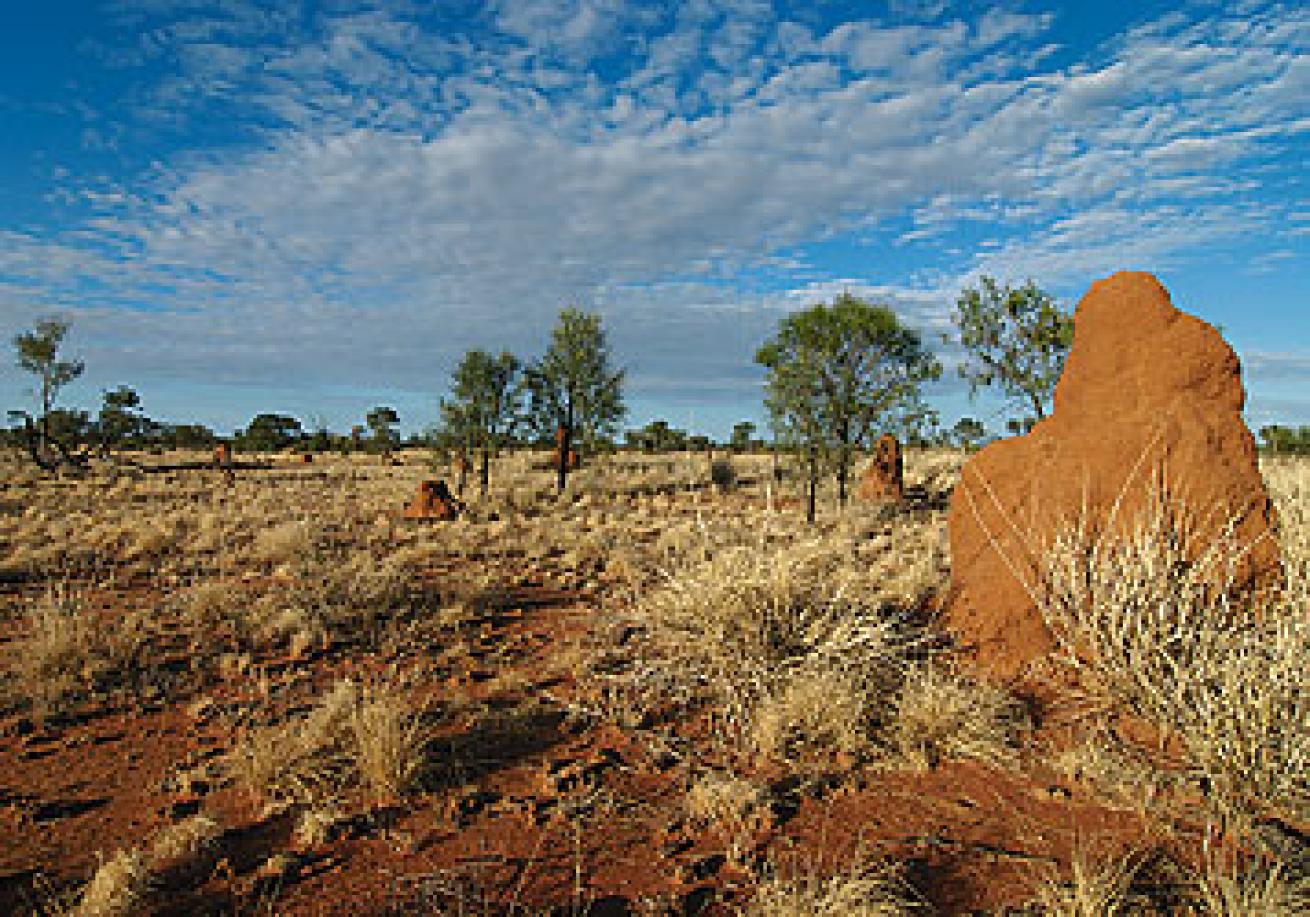
| | Photo by Nick Lucey|
Even if you're an old salt returning to the GBR and think you've dived it all, think again. Consider lesser known, rarely dived sites like fan-laden Vertical Gardens in Ribbon Reefs and Raine Island in the Far North, with its ongoing tiger shark research project, scores of green turtles and schools of hammerheads and barracuda. The Acropolis wreck wasn't even dived until late last year, Ball says, and it's pristine and teeming with fish life. Louise Bernstein, of GBR live-aboard operator Undersea Explorer, recommends diving the historic H.M.S. Pandora--a vessel now submerged in the seas of the Far North--which was dispatched in the 18th century to find mutineers from the H.M.S. Bounty.
Before or after your GBR dive adventure, give yourself a few days on land in Cairns or Port Douglas. If you want to be social, lively Cairns, with its restaurants, shops, pubs and live music clubs is where the party is, but if you're looking for the get-away-from-it-all vibe, laid-back Port Douglas is your place. Use either town as a base to rent a car or book tours to hit great natural nearby attractions like Daintree National Forest--one of the world's oldest--or try white-water rafting on the Tully River. Learn the fascinating history of indigenous Australians by visiting the award-winning Tjapukai Aboriginal Cultural Park in Smithfield, or taking a guided walk in the community of Mossman Gorge.
||| |---|---|
| Snapshot<
table>
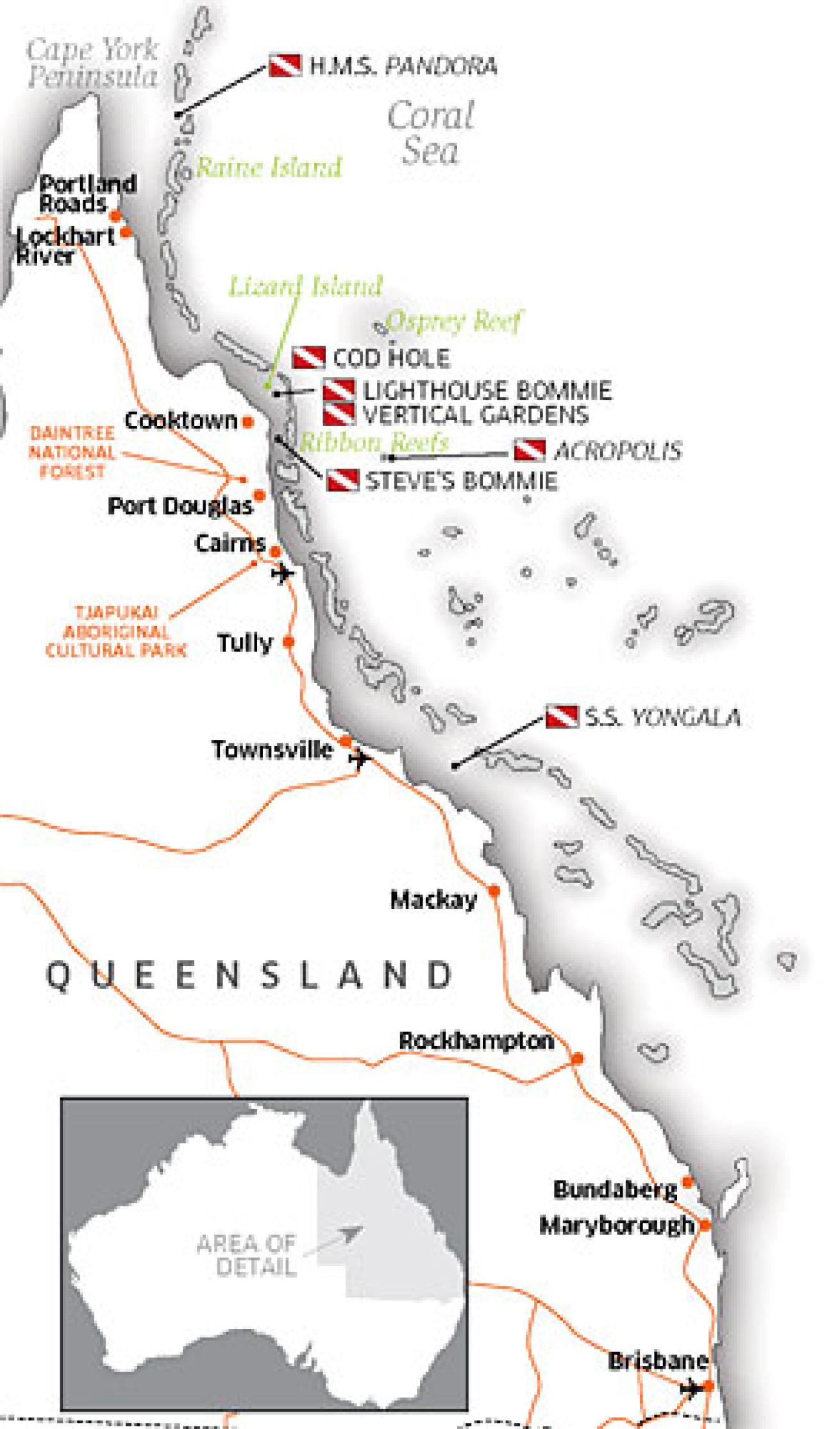
|
Weather: 80s in winter; 90s in summer. The rainy season is December through February.
Money Matters: Seven-night live-aboard packages, including accommodations, meals and diving, run $2,200-$3,400 p.p., dbl. occ. Currency is the Australian dollar (AU$); exchange rate fluctuates. Departure tax is about $30, usually included in airline ticket prices.
Get More: scubadiving.com/travel/pacificandindianoceans/australia
Getting There: Cairns (CNS) is the GBR's international gateway. Brisbane (BNE) is the closest major city to Cairns where an international nonstop flight from the U.S. lands--Qantas, Australia's national carrier, makes that flight from Los Angeles and then has connections to Cairns. If your plans begin or end in the Coral Sea region, you can fly into or out of Townsville (TSV) on Qantas or Virgin Blue from Sydney (SYD) or Brisbane. United and Qantas also fly nonstop from San Francisco and Los Angeles to Sydney, but you'd be cheating yourself if you limited Australia's world-class city to a mere airport stopover.
Baja California, Mexico
|| |---|
|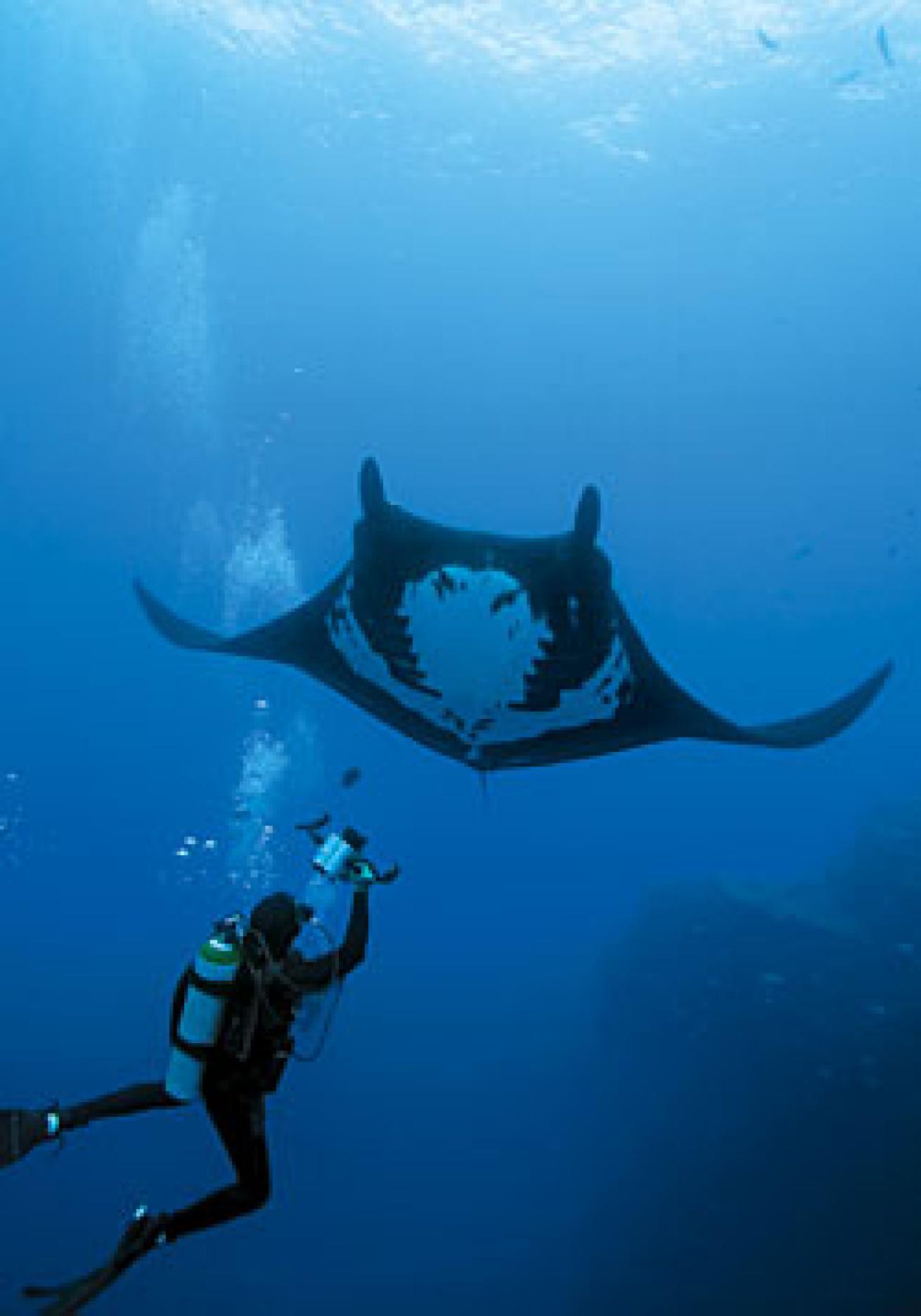
| | Photo by Stuart Westmorland|
Three of the main jumping-off points for diving into the action include Cabo San Lucas, Baja's version of Cancun, Cabo Pulmo, home to the only living coral reef in western North America, and La Paz, hub for diving some of the most popular sites in the southern Sea of Cortez.
"Baja is known for big animals," says Kevin Colter, of Amigos del Mar. "But, as you're waiting for a hammerhead to show up, you glance down and there is the most beautiful nudibranch you've ever seen. For a moment, the hammerheads are forgotten."
A handful of islands offshore provide even more thrilling big animal action. The Revillagigedos (including Socorro) afford consistent encounters with sharks, tuna, jacks and lots and lots of mantas, November through May. "The Boiler is the most popular site here, because it is a giant manta cleaning station and the divers can interact up close and personal," says Jose Luis Sanchez, who owns the live-aboard Solmar V. "Twenty-foot mantas stop six inches above your head so they can feel your bubbles on their bellies."
One of the most consistent places in North America to cage dive with great whites is Guadalupe, which lies nearly 200 miles off the coast of Ensenada.
||| |---|---|
| Snapshot<
table>
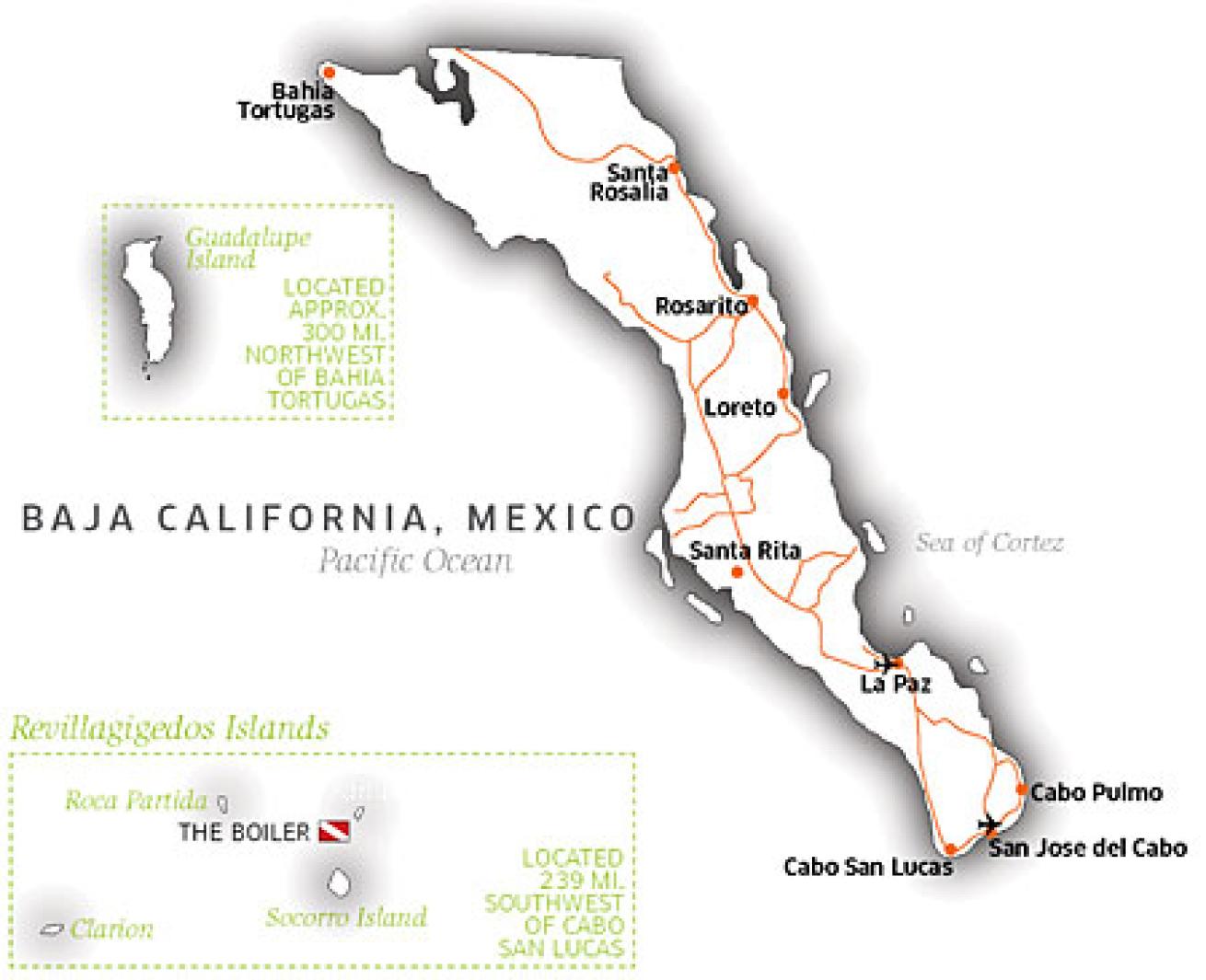
|
Weather: 80s in winter; 90s in summer.
Money Matters: Seven-night packages, including accommodation and diving (meals excluded), start from $800 p.p., dbl. occ. One-week live-aboard trips start at $2,095. Currency is the Mexican peso (MXP), although the U.S. dollar is widely accepted. Exchange rate is approximately 10 pesos to US$1, though it fluctuates. The departure tax is usually included in the price of your airline ticket.
Get More: scubadiving.com/travel/pacificandindianoceans/baja_california_western_mexico
Getting There: International airports at San Jose del Cabo (SJD) and La Paz (LPB) are served by a number of U.S. and international airlines. It is about a 45-minute taxi ride from the airport to Cabo San Lucas. You'll take Transpeninsular Hwy. 1 if you're driving. Live-aboard boats that make the trip to the Socorro Islands are based in Cabo San Lucas.
Costa Rica
|| |---|
|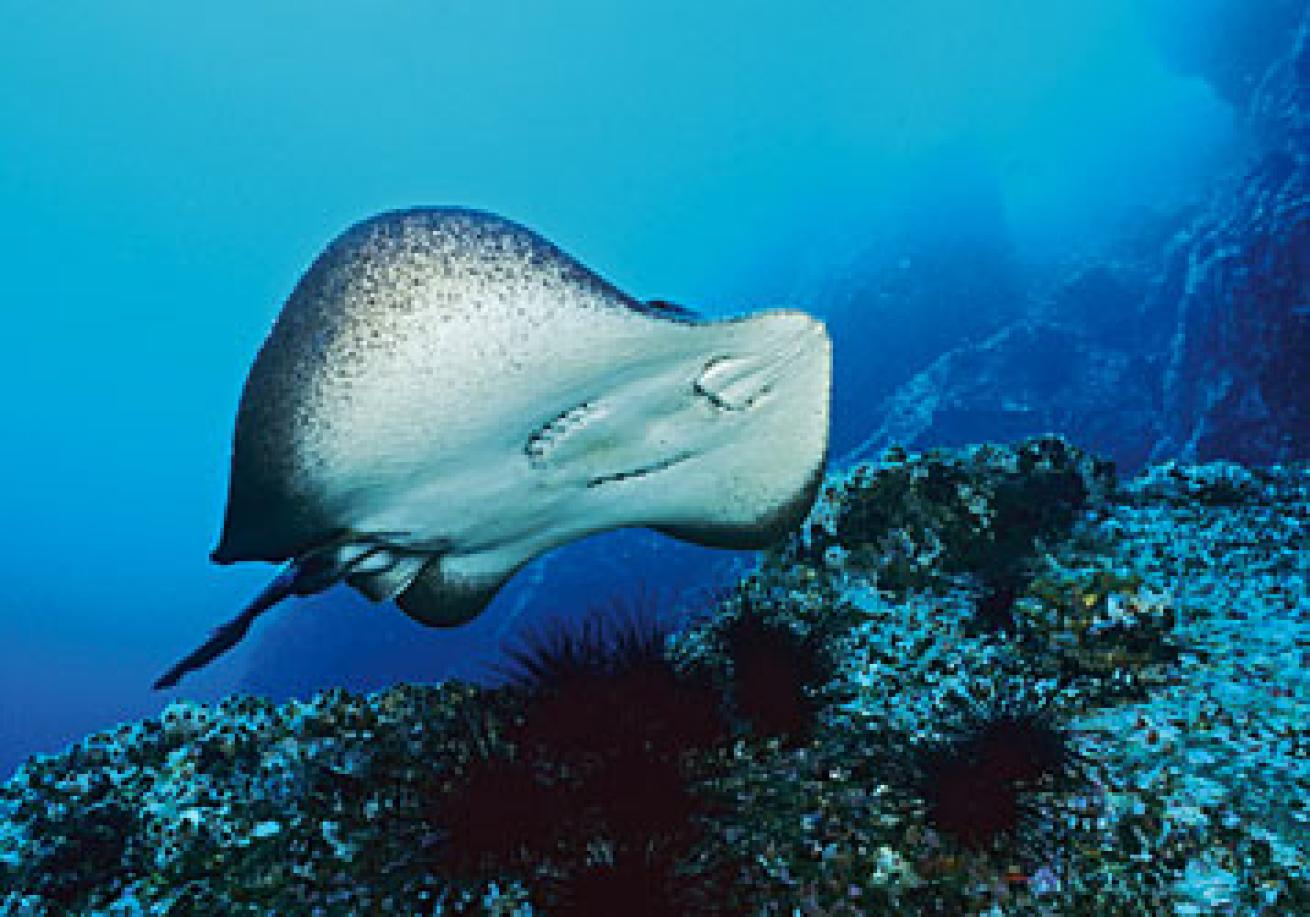
| | Photo by Phillip Colla|
One way is spending a night or two in San Jose, then getting whisked away to Puntarenas, where you'll get on a live-aboard vessel for a 300-mile ride south to Cocos Island. Cocos is lush, volcanic and has been designated a UNESCO World Heritage Site. Bajo Alcyone, with its hammerheads, mantas, whale sharks, sailfish and eagle rays, is perhaps the island's centerpiece dive site. Divers can also witness firsthand the "bait ball" phenomenon of hundreds of green jacks contorting themselves into a tight mass to protect themselves against pelagic predators. At Shark Fin Rock, you can observe marbled rays during mating season, and on Cocos, hike to waterfalls after alighting at Chatham Bay.
But if live-aboard diving isn't your thing, Costa Rica also offers land-based diving on the Golfo de Papagayo in the northwest and the Osa Peninsula in the southwest. Fly into Liberia and the beachfront towns of Playa Hermosa and Playa del Coco are just a short drive away. Boat rides to sites like Virador, Catalina Point and Catalina Wall are often less than 30 minutes from shore. But Bobbie Jo Gibbs, of Diving Safaris de Costa Rica in Playa Hermosa, advises divers not to expect visibility to be more than about 40 feet.
"But divers soon find out the upside to this," Gibbs says. "Our visibility is due to the nutrients in the water, which draws in the huge diversity of marine life."
Virador has big animals like manta rays, humpback whales, white-tips and whale sharks. At the Catalina Islands, school is in session for hundreds of mantas between December and May. At other sites, watch for small creatures such as seahorses and harlequin cleaner shrimp. Topside, don't miss the hot springs and volcanic mud baths of the still-active Mt. Arenal volcano.
Rustic jungle lodges are the accommodations of choice in the Osa Peninsula, the jumping-off point for the rocky reefs of Cano Island and surrounding pinnacles like El Bajo del Diablo. Expect to see it all, from big schools of snapper to napping nurse sharks to passing pods of dolphins. Topside, don't miss the waterfall hikes in the nearby rainforest preserve.
||| |---|---|
| Snapshot<
table>
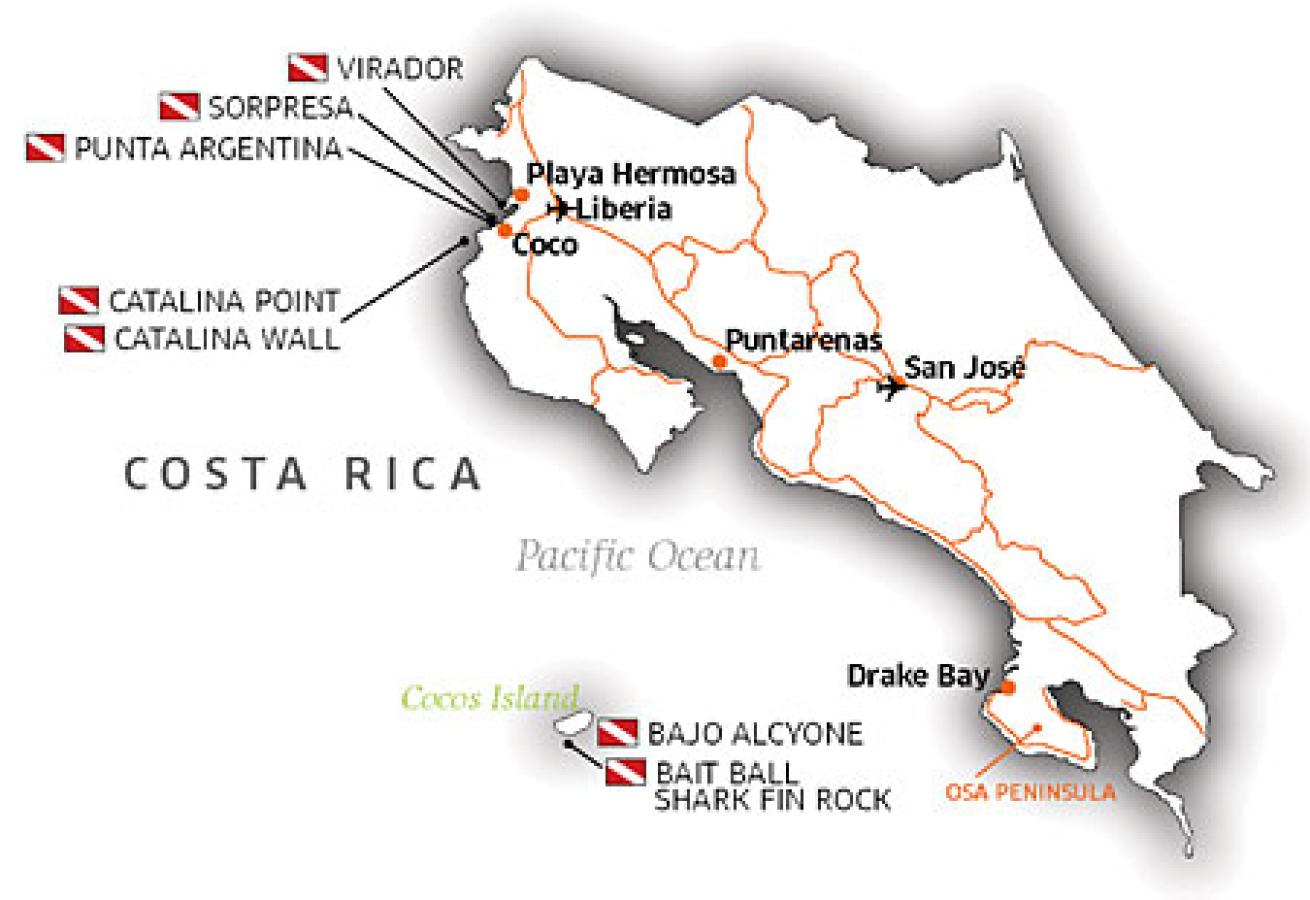
|
Weather: Mid-70s in winter; mid-80s to low 90s in summer.
Money Matters: 10-day live-aboard trips to Cocos Island start from about $2,400 p.p., dbl. occ. Seven-night land packages, including accommodation, breakfast and diving, start from $1,095 p.p., dbl. occ. Currency is the Costa Rica colon (CRC); exchange rate fluctuates. Departure tax is $26.
Get More: scubadiving.com/travel/pacificandindianoceans/costa_rica
Getting There: For Cocos Island, start by flying into San Jose (SJO), the Costa Rican capital. Plenty of nonstops from U.S. gateways are available: TACA International, American and United from Miami; United from New York; US Airways from Philadelphia and Charlotte; Delta from Atlanta; Continental from Houston and American from Dallas-Ft. Worth. If you're going to Playa Hermosa to dive, note that there are two Costa Rican towns with this name. You want the one near Liberia (LIR), where plenty of nonstops from U.S. cities are available--Delta from Atlanta and New York; Continental from Houston; United from Chicago and American from Dallas-Ft. Worth and Miami. For the Osa Peninsula, hop a commuter flight to Drake Bay (DRK) from San Jose or Liberia on Sansa or Nature Air.
Fiji
|| |---|
|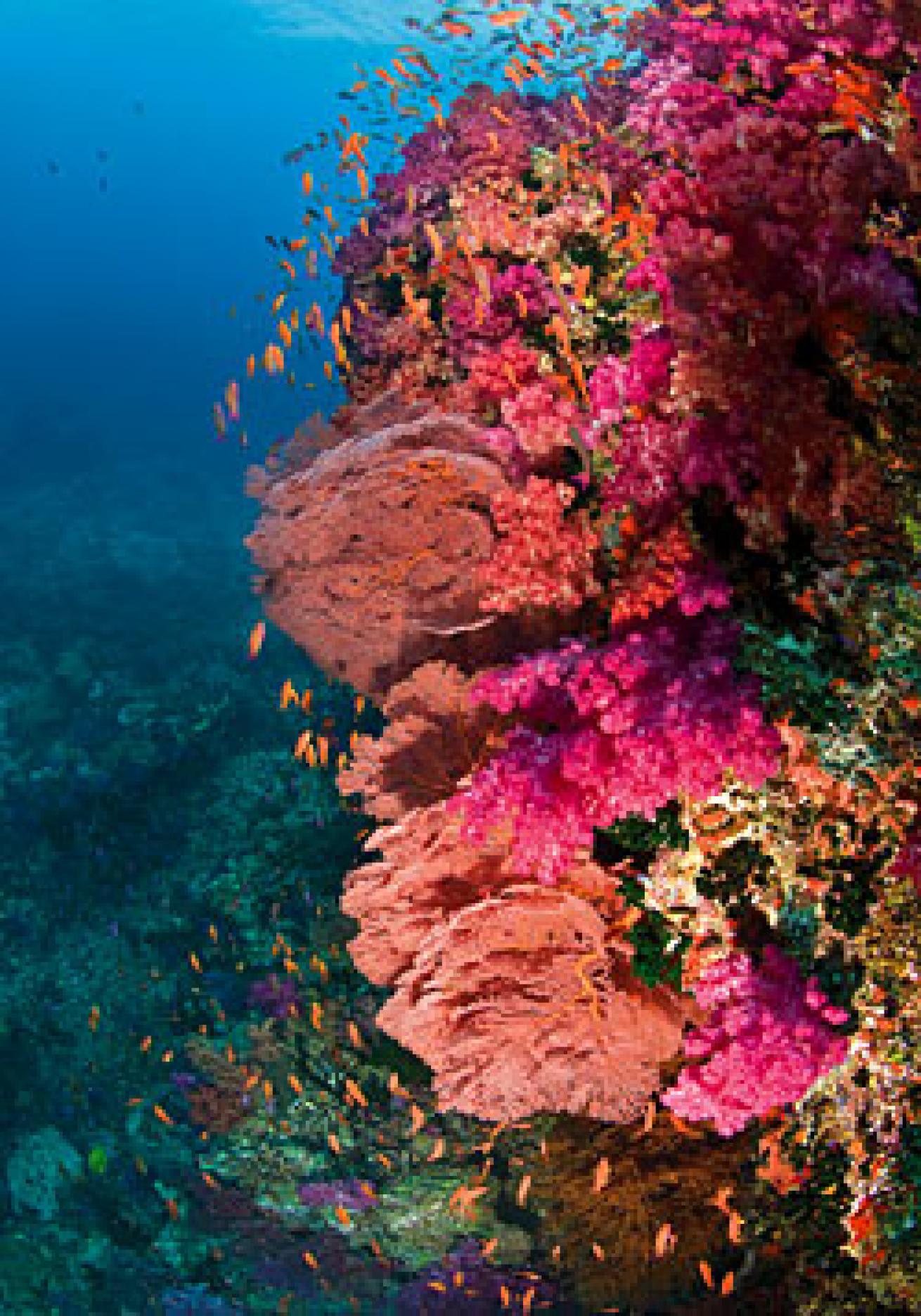
| | Photo by Michele Westmorland|
"It's a newfound reef jutting out from the edge of the Great Astrolabe Reef at 60 feet," Gow says. "It's attracting lots of pelagics that just circle around and around."
But with its soft corals and population of manta rays, humpback whales, turtles, titan triggerfish and even ghost pipefish, Fiji isn't only about sharks, diving one island or one barrier reef. Whether on a live-aboard plying Bligh Water between Viti Levu and its island neighbor to the north, Vanua Levu, or hopscotching by plane from those islands to others, like Taveuni, Gau, Ovalau and Kadavu, or plunging into the Great Astrolabe or the Namena Barrier Reef, there's no shortage of unforgettable diving.
"Fiji has 90 percent of the biodiversity found in Indonesia, but has much greater abundance of life," says Rob Barrel, of the live-aboard vessel Nai'a and a 15-year Fiji dive veteran. "Different times of year and moon phases and even different wind or tide direction will make familiar sites new again."
Fiji is also legendary for its friendly and welcoming indigenous culture and the cultural contributions from generations of South Asians who also call these islands home. On Viti Levu, it's not uncommon to visit a rustic village for a kava-drinking ceremony and see traditional dances by day, then by night eat Indian roti bread and curry and take in a "Bollywood" film. The pace of life on the outlying islands and villages is far more leisurely than the bustle of the capital city, Suva.
||| |---|---|
| Snapshot<
table>
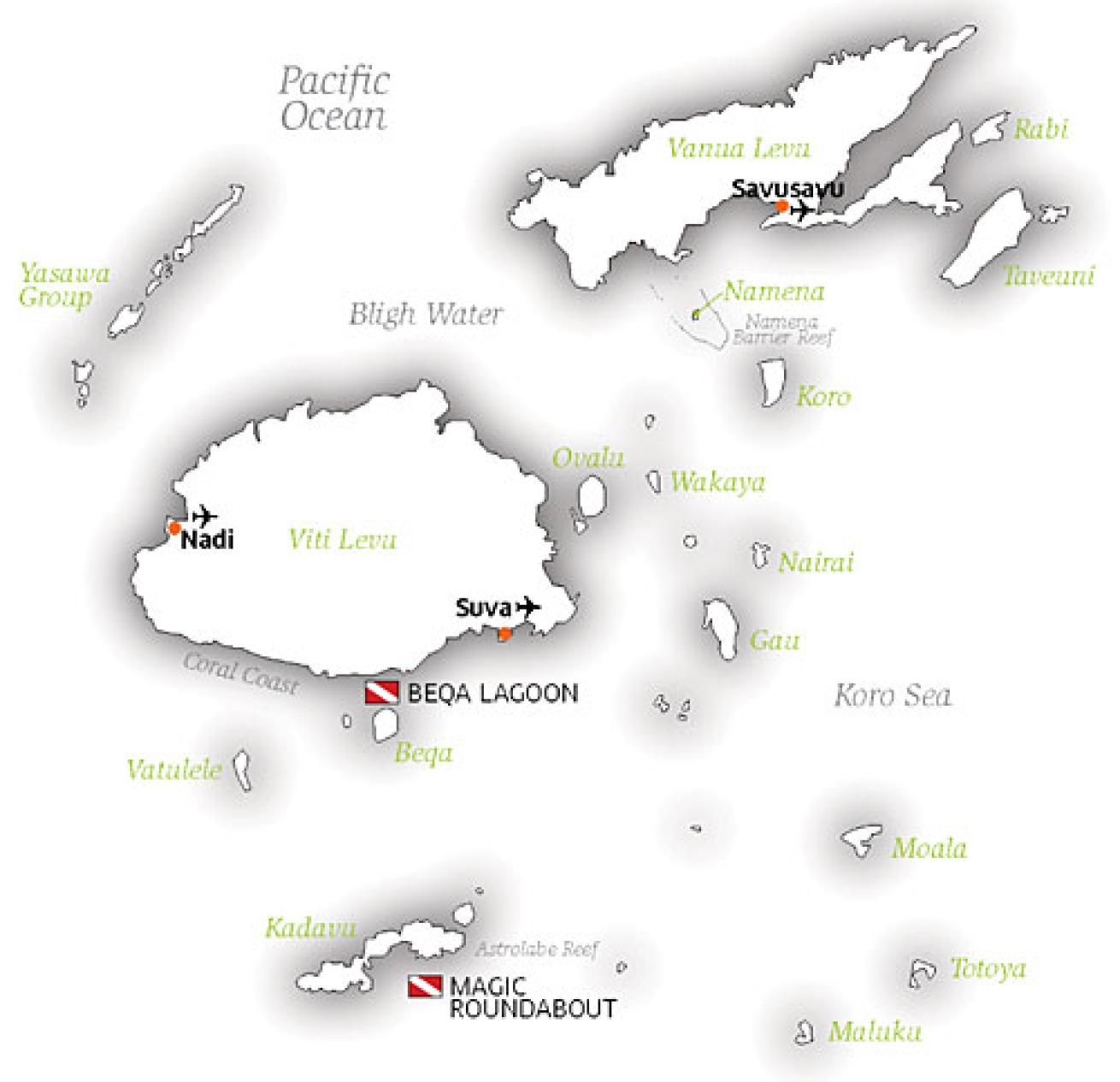
|
Weather: Mid-70s in winter; mid-80s in summer. The rainy season is December through February.
Money Matters: Depending on where you stay, rates at Fijian resorts range from budget to luxury, but, on average, seven-night stays in a traditional, thatched-roof oceanfront bure start from $2,000 p.p., dbl. occ., and go up from there, depending on the amenities. Currency is the Fijian dollar (F$). Departure tax is F$30.
Get More: scubadiving.com/travel/pacificandindianoceans/fiji
Getting There: Nadi is the gateway for Fiji dive vacations. Air Pacific, Fiji's national airline, has nonstop flights from Los Angeles and Honolulu, and one-stop flights from Vancouver to Nadi (NAN). While the Los Angeles to Nadi nonstop is about 11 hours, flights depart late at night and arrive early the following morning. While connections can be made on Pacific Sun, Air Pacific's regional subsidiary, to reach Suva and the surrounding islands, Fiji dive pros advise booking connecting flights with plenty of time in between, to minimize the chances of dive gear not making the flight you're on.
French Polynesia
With apologies to poet John Milton, paradise isn't lost--it's about 2,500 miles southeast of Hawaii. That's where groups of sinfully beautiful volcanic islands challenge poets, painters and photographers to do them justice. French Polynesia is a system of five sun-splashed archipelagos, including the Society, Tuamotu, Marquesas and Australs Islands, all ringed by reefs and laden with lagoons. Tahiti, one of the Society Islands, is the most well known.
From plentiful land-based dive resorts on most every island, boat rides to dive sites are always short and both the weather and water is tropical. Drift diving is the way to go here, and the volcanic nature of the islands means underwater topography spanning from walls and valleys to passes. Oh, and did we mention French Polynesia has excellent big life? If you're into sharks (black-tips, white-tips and lemons) and mantas, it's hard not to find plenty of both. Shark feedings are common on several islands, including Bora Bora, Moorea and Raiatea, but if you prefer to encounter the animals minus wranglers and bait, it's easy, as sharks are prevalent throughout French Polynesia.
From Bora Bora, perhaps the world's most lavishly praised island, for its stunning topside beauty, there are several worthwhile sites, including Anau, for manta rays and Muri Muri (The White Valley), where gray reef sharks make like fighter jet escorts and shadow divers throughout dives. Huahine's outer reef offers plenty of life, from jacks and eels to barracuda and sharks at Avapeihi (Fitii) Pass and Fa'a Miti, where colorful corals are a nice bonus.
But perhaps nowhere else in French Polynesia are sharks as common--and revered--as in the Tuamotus, a few hundred miles to Tahiti's northeast. That's where you'll find the island of Rangiroa, a regional drift diving haven and world-renowned shark diving destination, with visibility commonly exceeding 100 feet. The rapid rushing currents of Tiputa Pass (Shark Cave) and the sheer numbers of dozens of sharks make this site one of the most "high voltage" this side of the Galapagos.
Also in the Tuamotus, The Circus (Le Cirque), a site off the island of Manihi, is manta ray central, while pristine Garuae Pass, near the island of Fakarava offers divers the chance to literally get carried away into the current and see congregations of sharks and smaller fish. Those same kinds of wilderness vibes exist in the Marquesas, where cave and pelagic dives can be found near the island of Nuku Hiva and in the Australs, where humpback whale encounters are common near the island of Rurutu.
||| |---|---|
| Snapshot<
table>
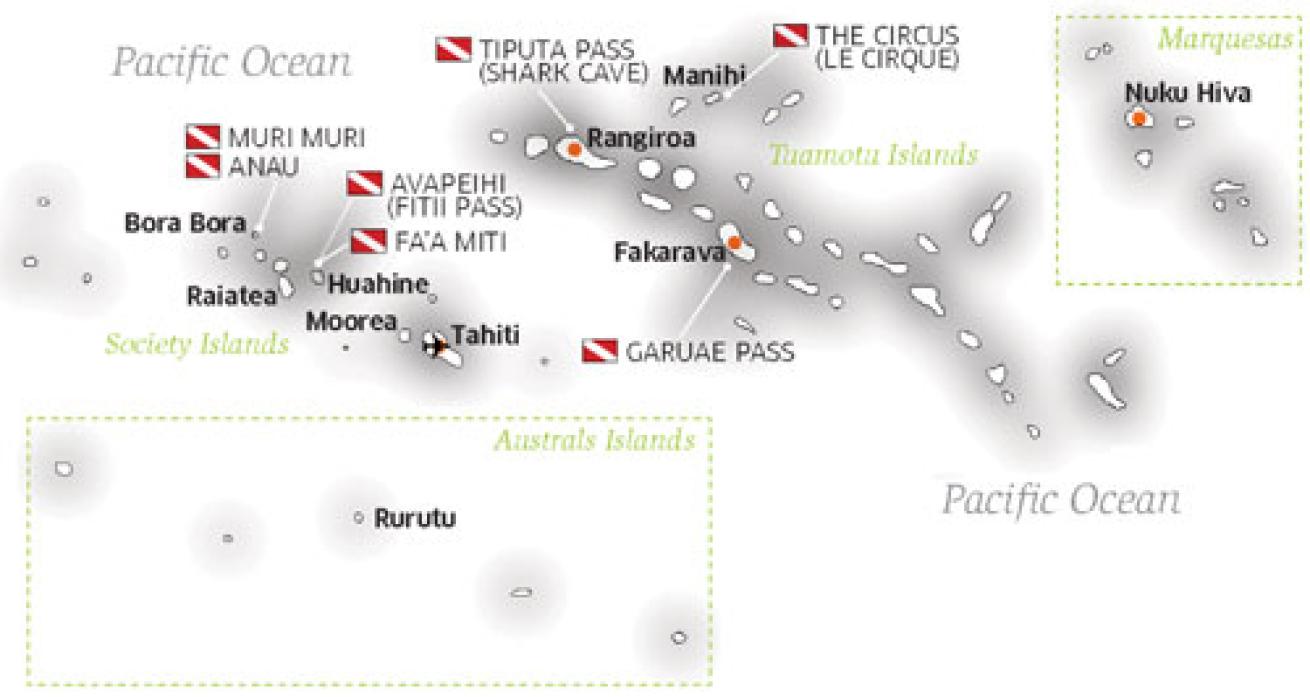
|
Weather: Low 80s in winter; mid-80s to low 90s in summer. The rainy season is from November to April.
Money Matters: Depending on the island and resort, seven-night packages, including accommodation, breakfast and diving, range from $2,000 p.p., dbl. occ., to $4,000 p.p., dbl. occ. Currency is the French Pacific franc (CFP). Departure tax is approximately $80 and is sometimes included in airline ticket prices.
Get More: scubadiving.com/travel/pacificandindianoceans/french_polynesia
Getting There: Despite the distance from North America, it's incredibly easy to get to the international gateway Papeete (PPT), as Air Tahiti Nui offers one-stop flights from New York via Los Angeles, which don't require changing planes. Hawaiian Airlines makes nonstop flights to Papeete from Honolulu. From Papeete, Air Tahiti, French Polynesia's efficient domestic carrier, covers every outlying island imaginable.
Galapagos Islands
How is diving here--where dive conditions were created by volcanic activity and the confluence of many currents-- like the posted warnings on utility poles? Two words: "high voltage."
That's how live-aboard dive professionals describe the rollicking action at legendary sites like Cape Marshall, Darwin's Arch, Landslide and Wolf Island. Depending on when you go, encounters with schooling hammerheads or whale sharks are routine. Bring your A-game. Galapagos is best for divers who've mastered neutral buoyancy and welcome the challenge of currents.
But, says Santiago Dunn, of Ecoventura--which operates the M/V Sky Dancer live-aboard vessel in parternship with Peter Hughes Diving--you don't have to be a master diver to savor the rush. "It's drift diving, with currents," Dunn says. "If you're comfortable with yourself underwater, you're ready."
Getting there is an adventure: a flight to Guayaquil or Quito, Ecuador, then a connection to San Cristobal Island. From there, you board your live-aboard for a 10-day excursion to Wolf and Darwin islands. Prepare to be dazzled.
"When diving with endemic species such as the striped salema, the schools are so big, you seem to disappear inside them," Dunn says. "Every dive in Galapagos is always different and (you'll think) every dive you've done is the best."
On a live-aboard you'll still get plenty of time to check out the topside landscape and wildlife on Puerto Egas and Bartolome and San Cristobal islands. The biggest question is when to go. June through November is the time to see whale sharks, Dunn says. That's when waters are coldest and roughest. If schooling hammerheads, sea lions, mantas, turtles and penguins--and warmer, calmer conditions--are more your style, go in February, March or April.
Dive pros advise spending at least two days in Quito or Guayaquil beforehand, just in case your dive gear somehow didn't make the trip with you. And there's lots to see in Quito, including the city itself, the Mindo and Bellavista Cloud Forest Reserves or La Mitad Del Mundo, where you can simultaneously stand on both sides of the equator. Before you go, two travel tips: One, penalties for exceeding baggage limitations in the Galapagos Islands can be very costly. And two, consider elevation when choosing your gateway on mainland Ecuador. Quito's altitude is over 9,200 feet, while Guayaquil is at sea level.
||| |---|---|
| Snapshot<
table>
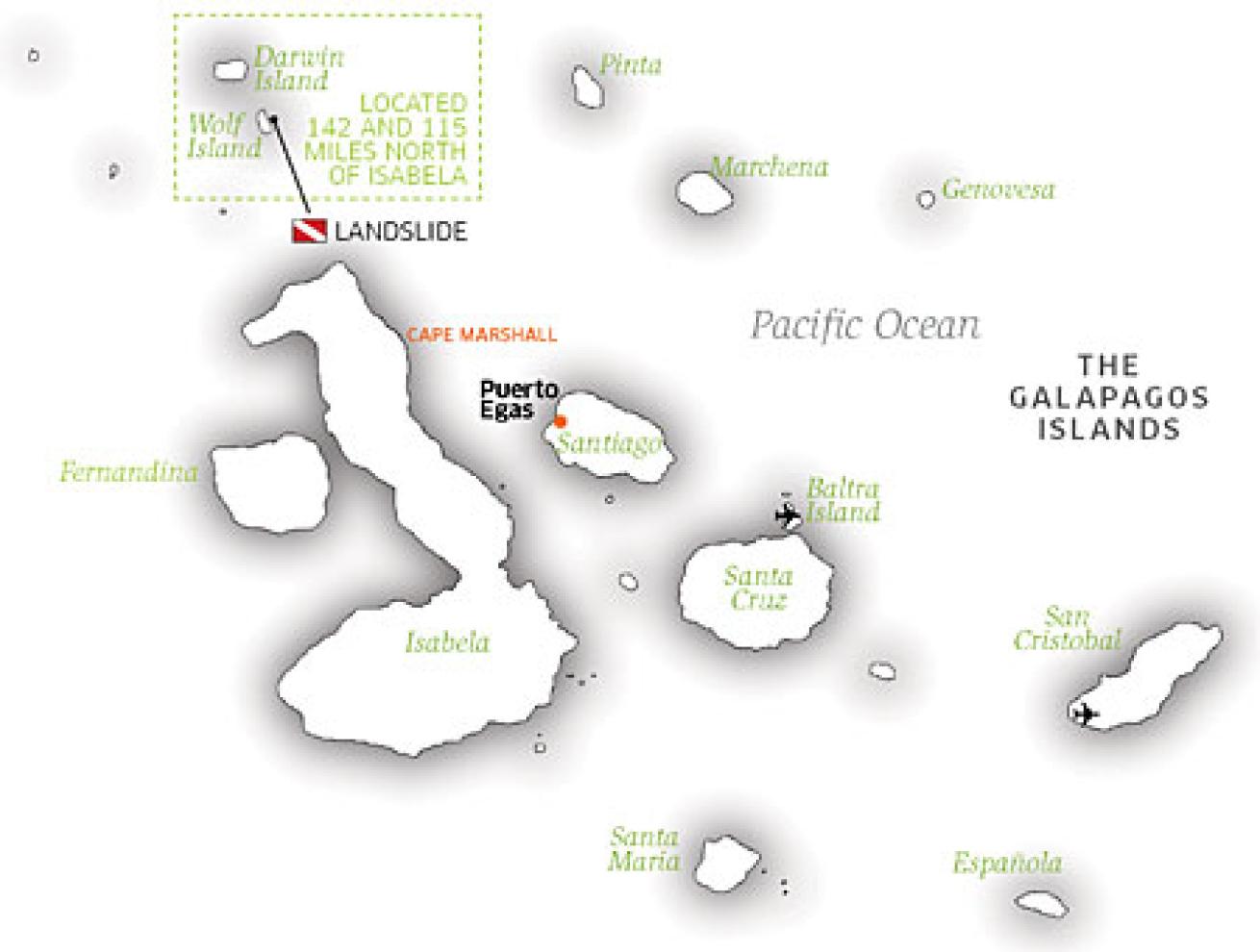
|
Weather: Temps average in the low 70s year-round.
Money Matters: Seven-night live-aboard packages, including accommodation, meals and diving, run about $3,495 p.p., dbl. occ. Currency is the U.S. dollar. There is a $100 Galapagos National Park fee. Departure tax is $26 from Guayaquil and $40.80 from Quito.
Get More: scubadiving.com/travel/pacificand indianoceans/galapagos
Getting There: American Airlines and LAN Ecuador have nonstop flights to Quito (UIO) from Miami, while Delta and Continental have nonstops to UIO from Atlanta and Houston, respectively. LAN Ecuador flies nonstop between New York (JFK) and Guayaquil (GYE). From the mainland, Ecuadorian carriers Aerogal and Tame serve San Cristobal and Baltra, on the Galapagos Islands. Live-aboard operators can help book flights from Ecuador's mainland to the Galapagos Islands and some may include that round-trip airfare in the cost of booking a trip with them.
Hawaii
|| |---|
|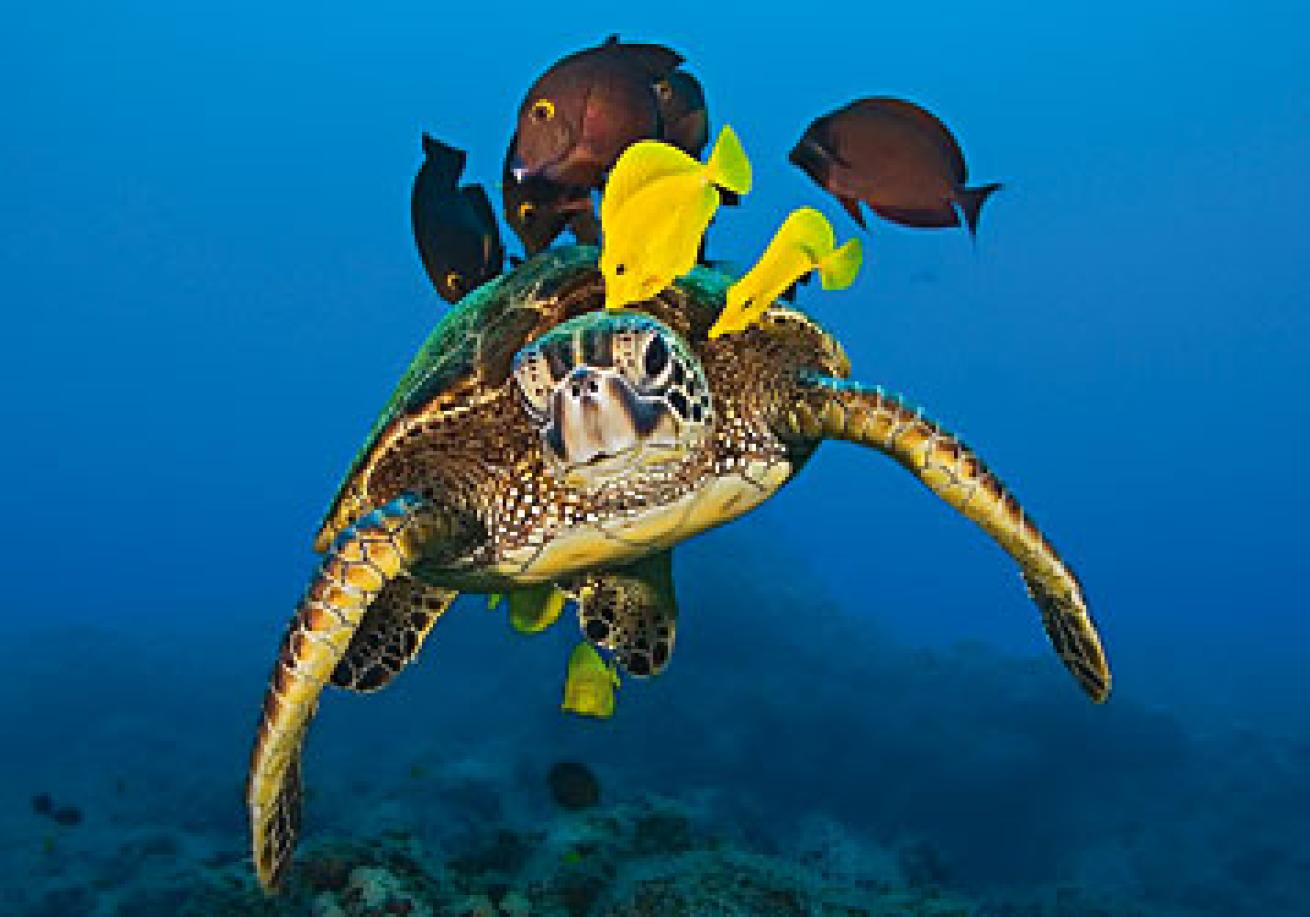
| | Photo by Masa Ushioda|
"The most common misperception is that Hawaii is not truly a 'dive destination," says Chris Quarre, of North Shore Explorers, a Maui dive operator, "and that there are only a few 'signature' sites."
That's truly a myth. And the islands' isolation from the rest of the world means encounters with endemic species.
"Relatively common fish that we see everyday like the milletseed butterfly are only found in Hawaiian waters," says Tim Means, of Lahaina Divers in Maui. "They're very rare when looked at on a global scale."
With tempting lava tube swim-through caves and diverse marine life, there's really no such thing as a typical Hawaiian dive. What divers experience in the Cathedrals, two massive caverns near Lanai, is completely different from diving the Back Wall of Molokini Crater near Maui, where from December to May, the calls of humpback whales chill their spines.
"I had two humpbacks swim with me recently," says Charles Neal, of Scuba Shack in Maui. "And then there are whale sharks and the fact we have hundreds of the protected Hawaiian green sea turtles that aren't the least bit shy."
A remote site called Golden Arches is one Neal says is gaining popularity for its huge swim-throughs and thousands of fish.
Hawaiian dive pros say swimming with big animals at uncommon sites like South Point and Upolu Point, off the Big Island, is as much of a thrill as exploring the virginal reefs of the "Forbidden Island" of Niihau, the newest Hawaiian destination more divers are starting to discover for its wall diving, monk seal and spinner dolphin sightings and unmatched visibility.
"Many sites there have a 'Wild West' sense," says Marvin Otsuji, of Kauai-based Seasport Divers.
Maui's North Shore is another area Quarre says has been little dived in the past, but now deserves more play--Puka Maui for its underwater archways and pinnacles and Little Puka (Whisker Bay) for its rare and abundant animals. While monk seals, mantas and turtles are famous underwater Hawaiian residents, from December through May, humpbacks and the occasional whale shark come calling.
Several dive operators run trips to Lanai's dive sites from Maui and operators on Kauai conduct Niihau diving. But book with dive operators well in advance. And Hawaiian waters aren't always calm. Some dive shops will arrange alternate topside activities if seas are too rough.
On the Big Island, Hawaii, Kailua-Kona is dive central. At Huggo's on the Rocks, share your best underwater tales with fellow divers while downing local brews or macadamia nut martinis and sampling ahi poke (raw tuna with spices and herbs). Everyone's looking for the next great dive experience and John Haut of Kona Honu Divers offers a couple. "The eagle ray cleaning station at Nai'a is the best-kept dive secret," he says, "and the blackwater dive is unique. You never know who you'll meet out in the open water at night."
Topside attractions are endless, whether biking through Maui's mighty Haleakala Crater, hiking the breathtaking Na Pali Coast on Kauai, taking in the enlightening Polynesian Cultural Center on Oahu, eating ahi tuna sashimi at a luau, or sipping on a mai tai at a resort bar.
If you're planning a visit to Mt. Haleakala on Maui or Hawaii Volcanoes National Park on the Big Island, check the altitudes of both places beforehand and allow enough time after diving.
||| |---|---|
| Snapshot<
table>
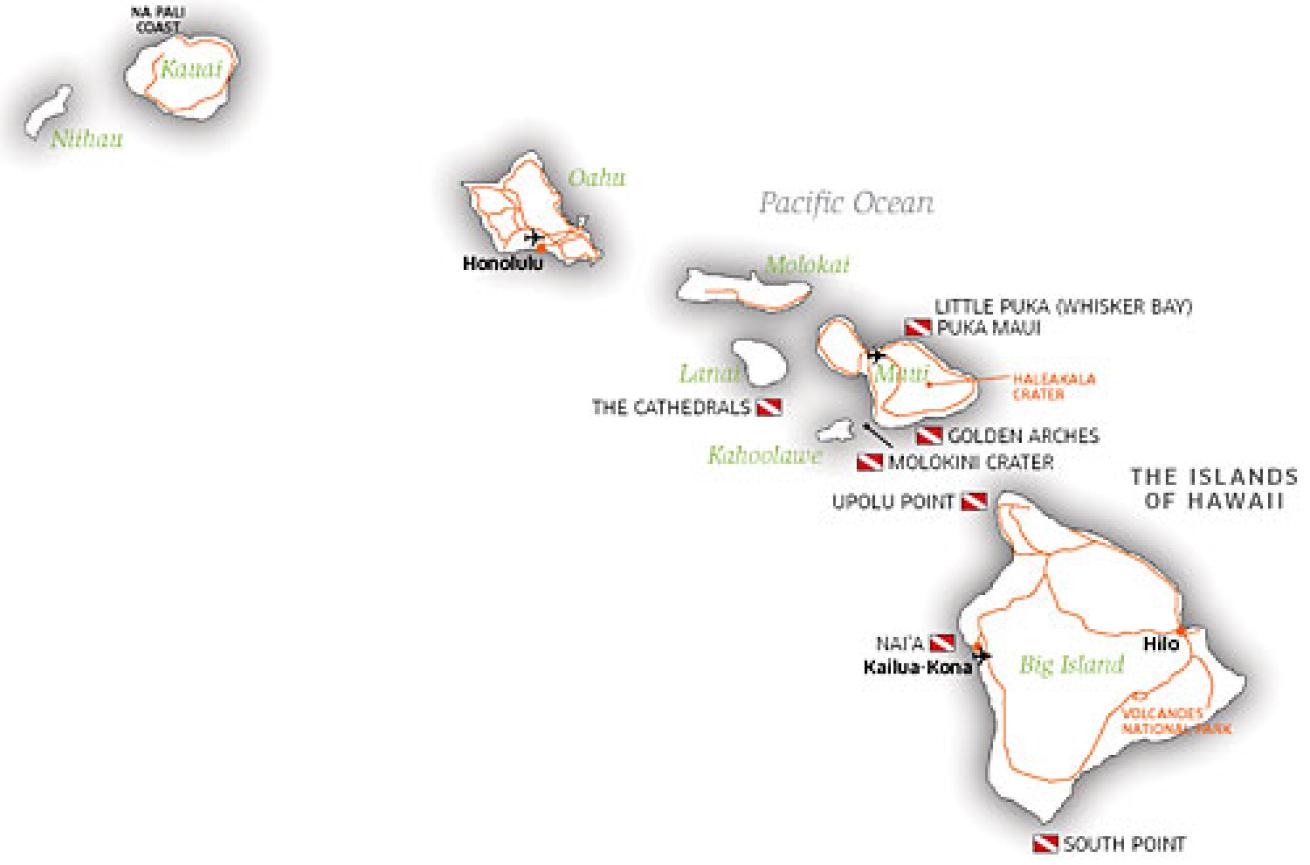
|
Weather: 60s in winter; 80s in summer. The rainy season is November to March.
Money Matters: No matter which island you stay on, you'll typically have to arrange your accommodations and diving separately, though some dive operations will help you put together both. For two people, count on spending at least $1,000 for a seven-night stay in a condo; diving and meals extra. A one-week Kona live-aboard cruise runs about $2,295 p.p., dbl. occ. There is no departure tax.
Get More: scubadiving.com/travel/north_ america/hawaii
Getting There: Plenty of major airlines serve Hawaii, with a few flying nonstop to Maui (OGG) and Kailua-Kona (KOA) from the U.S. mainland. For outlying Kauai, you'll need to catch a connecting flight in Honolulu (HNL).
Indonesia
|| |---|
|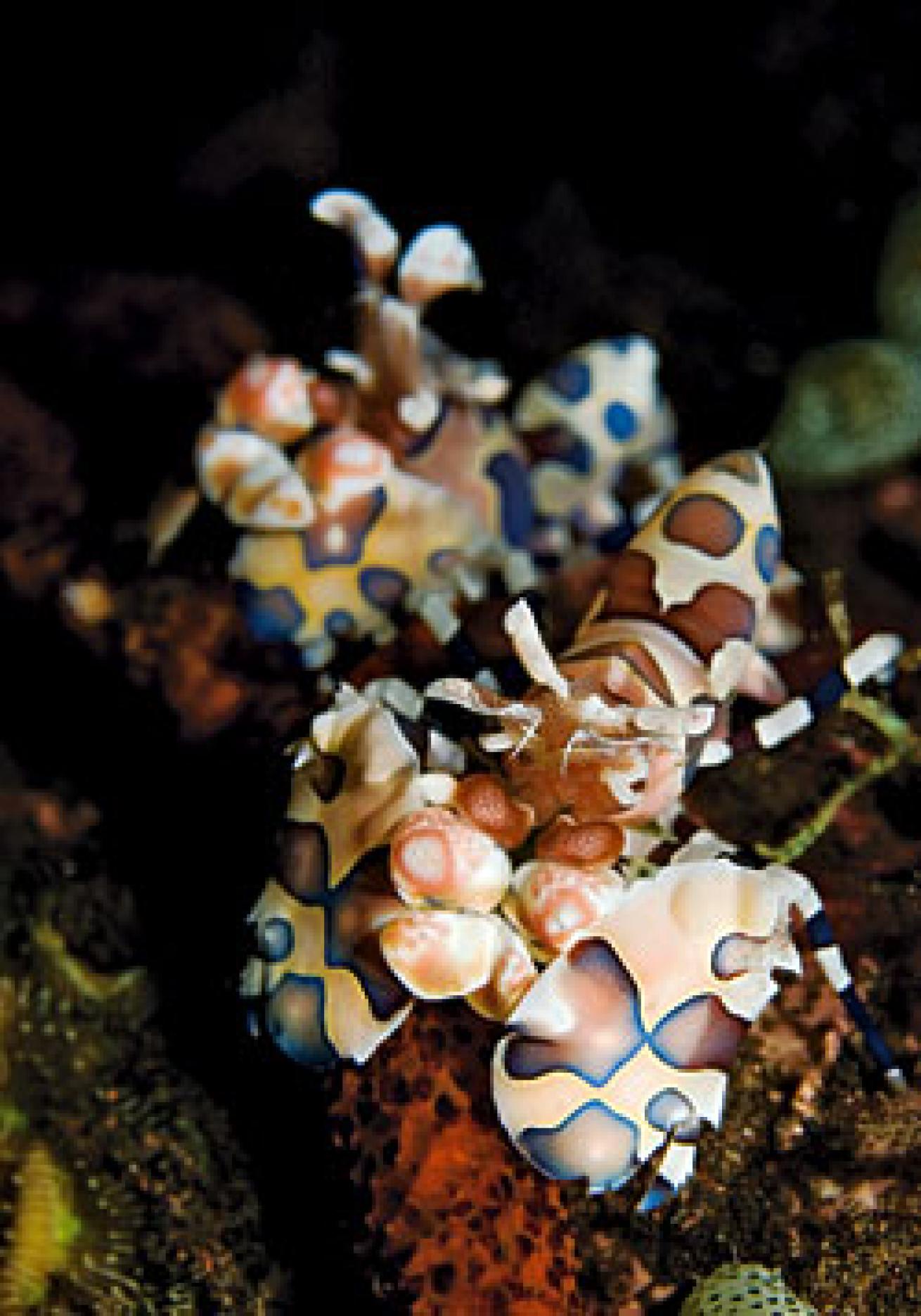
| | Photo by Mike Veitch|
That's because, in addition to the thousands of varieties of fish and coral, divers are finding unidentifiable marine life in the blue, in the muck and on the reefs, that naturalists are hard-pressed to catalog. So what created this condition?
"Millions of years of natural selection," says Henrik Rosen, of Wakatobi Dive Resort. "The Caribbean has had 60,000 years to develop since the last ice age. Our area has had 60 million years."
If you think that number is staggering, crunch these: Within its 17,000 islands, Indonesia has almost 15 percent of the planet's coral and about 25 percent of its fish species. Is it any wonder why Indonesia--occupying roughly the same geographic dimensions as the entire Caribbean--is arguably the world's hottest dive destination? And if you're the avid diver you think you are, wouldn't you think it petty to complain about the 24 hours it normally takes to fly to Bali, the storied, idyllic gateway to this undersea Eden?
It's impossible to savor all of Indonesian diving on one trip, so you've got a pre-made excuse to return another day. And what tempting options: muck diving for macro life in the Lembeh Straits or Sangeang Island; testing your fish ID to the limit in Raja Ampat, Kri or Misool, in the heart of the Coral Triangle; cruising on a live-aboard from Bali to Komodo, or between Flores and Alor, or northern Sulawesi and the Sangihe Islands; or diving 24/7 from an over-water bungalow in Wakatobi.
In Bali, white-water rafting, tramping around rice terraces, taking in time-honored cultural dances and feasting on babi guling (traditional roasted suckling pig) are all possibilities. Other Indonesian islands have more isolated villages where, Rosen says, if you practice good etiquette--covering arms and legs, for example--you'll be enthusiastically and warmly welcomed.
||| |---|---|
| Snapshot<
table>
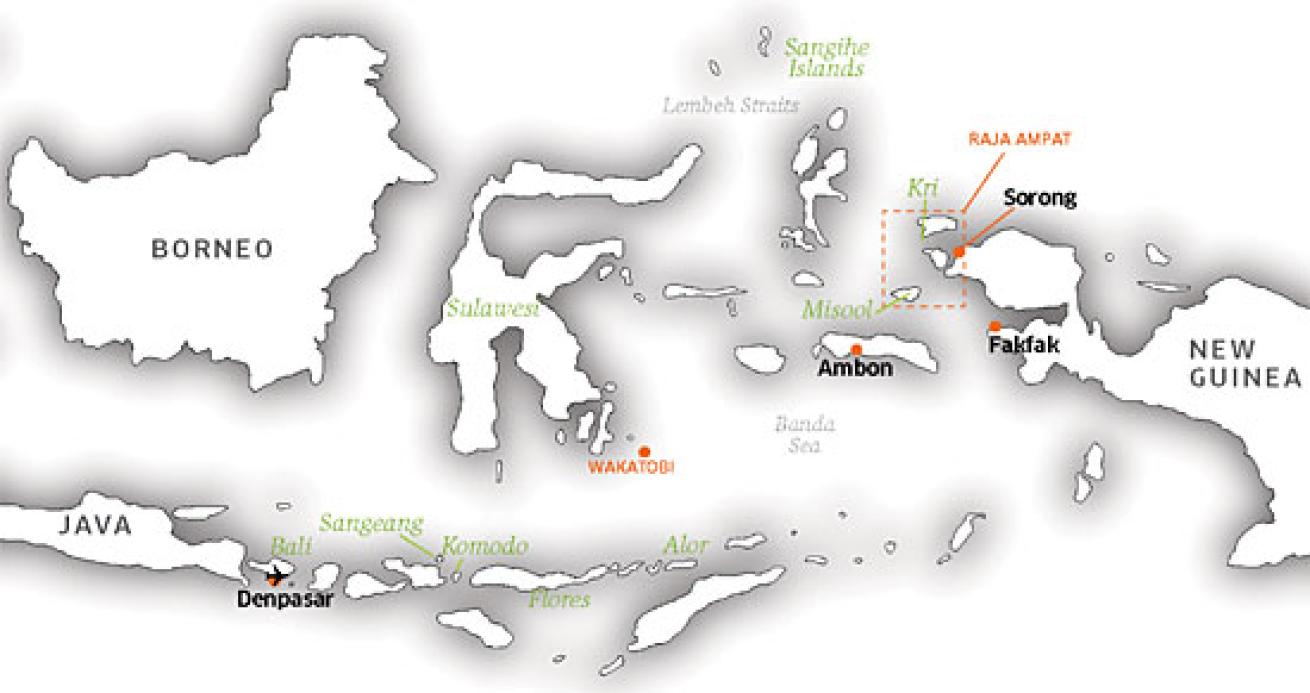
|
Weather: Mid-70s during the dry season; low 80s during the rainy season.
Money Matters: Depending on the itinerary, seven-night live-aboard cruises, including accommodation, meals and diving, start from $2,295 p.p., dbl. occ. Currency is the rupiah (IDR). Departure tax is IDR100,000.
Get More: scubadiving.com/travel/pacificand indianoceans/indonesia
Getting There: There are no nonstop flights from the U.S. The closest nonstop is on Singapore Airlines, from Newark or Los Angeles to Singapore (SIN). After that flight--about 19 hours--catch a connection to Denpasar, Bali (DPS). Otherwise, depending on which coast you're closest to, the odyssey from North America will likely involve one or more stopovers in the following cities: London, Zurich, Tokyo, Seoul, Hong Kong, Bangkok, Manila, Kuala Lumpur or Sydney. Shorter hops from Bali will take you to locations throughout the Indonesian archipelago.
Micronesia
|| |---|
|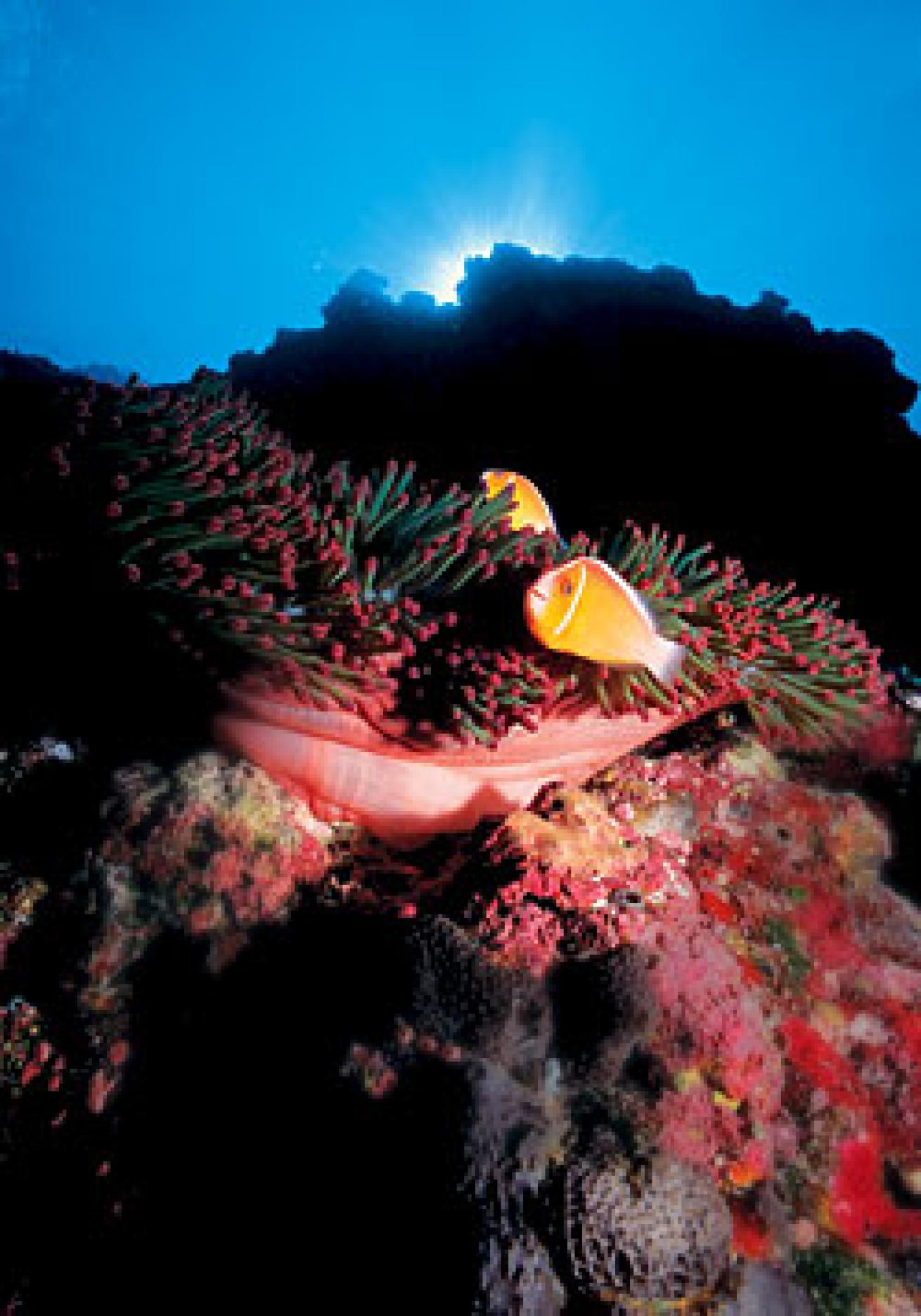
| | Photo by Mike Veitch|
And though the islands are physically small, they represent a variety of diving opportunities unparalleled on the planet. From reefs to wrecks, drift diving to shore diving, encounters with big pelagics to snorkels with stingless jellyfish, Micronesia offers something for every diver.
If you're looking for a little bit of everything, Palau's got it all. "We're known for our reefs, walls, blue holes, caves, caverns, World War II wrecks, and muck diving from shore," says Sam Scott, owner of Sam's Tours. "Blue Corner is our most popular site, due to its tremendous upwelling currents, large population of sharks, pelagics and reef fish, hard and soft corals, severe drop-off, macro and wide-angle photography and using your reef hook when the current permits to hook in and watch the action. But a hot new site is Peleliu White Beach Point, where you'll find lots of turtles, giant clams, awesome current flow, pelagics and great coral formations."
For years, divers only knew Guam as the island they flew through on their way to Palau, Yap and Chuuk. But today, many are stopping to smell the corals and experience Guam's unique dive sites. And its most unique is probably the wreck combo of the Tokai Maru and SMS Cormoran. "This dive site in Apra Harbor represents the only place in the world where sunken ships from two different wars sit touching each other," says Pilar Laguana, of the Guam Visitors Bureau. "The Blue Hole is one of the island's finest novelty dives, a long shaft that starts at the top of a sloping reef and extends down 300 feet. At 130, a large window opens to the outer wall, allowing divers to exit and ascend after a free fall through the shaft."
For wreck divers, the lagoon at Chuuk (Truk Lagoon) has no equal. The U.S. military created the largest permanent parking lot of diveable shipwrecks when Operation Hailstone dispatched dozens of Japanese warcraft to the seafloor.
||| |---|---|
| Snapshot<
table>
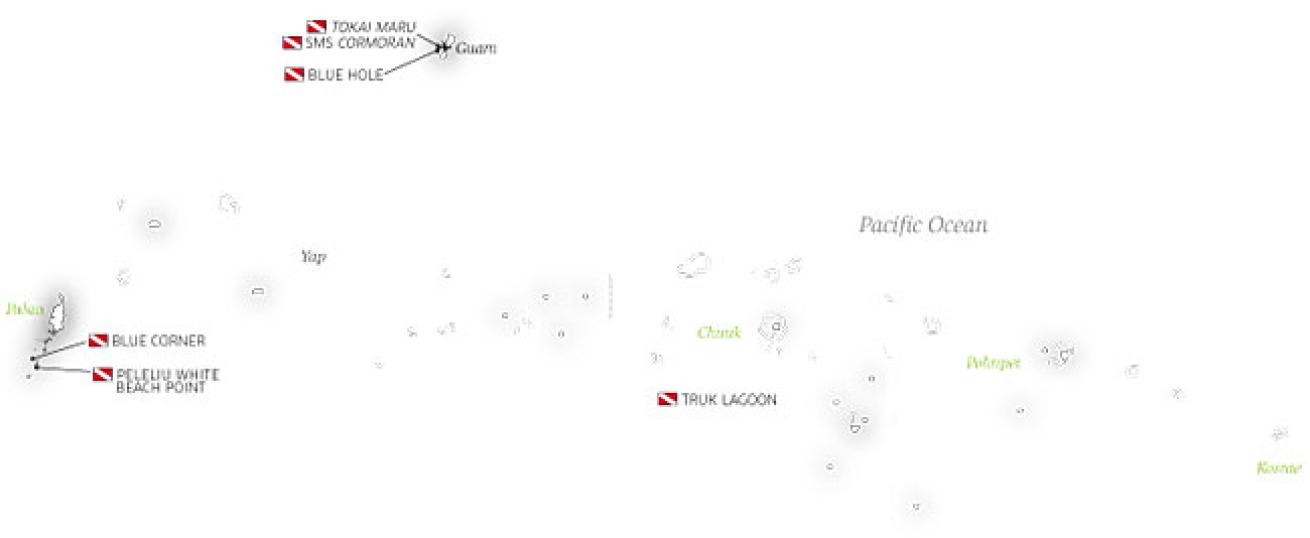
|
Weather: Mid- to high 80s year-round.
Money Matters: Seven-night packages, including accommodation, breakfast and diving, run from $900 p.p., dbl. occ., to $1,800 p.p., dbl. occ., depending on where you're staying. A one-week Palau live-aboard cruise runs about $2,795 p.p., dbl. occ., and a one-week Truk live-aboard trip starts at $1,795. Currency is the U.S. dollar. Departure taxes are $20 for Palau; $15 for Truk; $10 for Pohnpei and Kosrae; no departure tax for Guam, Yap and the Northern Marianas.
Get More: scubadiving.com/travel/pacificandindianoceans/micronesia
Getting There: Guam (GUM) is the springboard to all of Micronesia. Continental flies to Guam nonstop from Honolulu. Continental's subsidiary, Continental Micronesia, connects to Palau (ROR), Chuuk (TKK), the Marianas (SPN), Pohnpei (PNI), Kosrae (KSA), the Marshall Islands (MAJ) and Yap (YAP). Each island airport has its own customs and immigration officers; if you plan on visiting several islands on one trip, you'll pass through customs and immigration lines at each stop.
Papua New Guinea
Looking for diversity? PNG has a little bit of everything.
Alotau, on PNG's extreme southeastern end, is close to land-based diving and is also home port to live-aboards cruising east into Milne Bay and south to the Coral Sea. Vessels also sail from outlying islands such as New Ireland, from the town of Kavieng, in search of World War II wrecks and pelagic marine life. From the island of New Britain, live-aboards cruise along both its north and south coasts, from Rabaul, Kimbe, Hoskins and Walindi. Live-aboard operators generally sail from the south coast from January through March and from the north coast from April to December.
Dive pros say south coast dive sites, like Sharon's Island and Mia Passage, are the new "must-dive" spots for macro photographers. They also rave about Lama Shoals, a seamount and cleaning station in the Witu Islands. "The huge schools of jacks and barracuda are dizzying," says Alan Raabe, boat manager of the Peter Hughes diving live-aboard vessels the, M/V Star Dancer and the M/V FeBrina. "The forest of beautifully colored black coral trees provide a dramatic backdrop for the frenetic buzz of marine life which inhabits this reef."
Land-based resorts in Madang, in northern PNG, offer boat trips to the Henry Leith wreck and Planet Rock, featuring multicolored corals, sharks, barracuda and lionfish.
Near Port Moresby, John Miller, of the Dive Centre, recommends the immense Pacific Gas wreck and Suzie's Bommie, which he describes as "a reef pinnacle with clouds of fish." There's also muck diving in nearby Lion Island.
Topside, if you venture out to the National Museum or Botanical Gardens in Port Moresby ask a dive shop staffer to hire a local guide. No matter where you are in PNG, visiting a rural village market and buying a souvenir bilum--a catchall, woven string bag--is a must.
||| |---|---|
| Snapshot<
table>
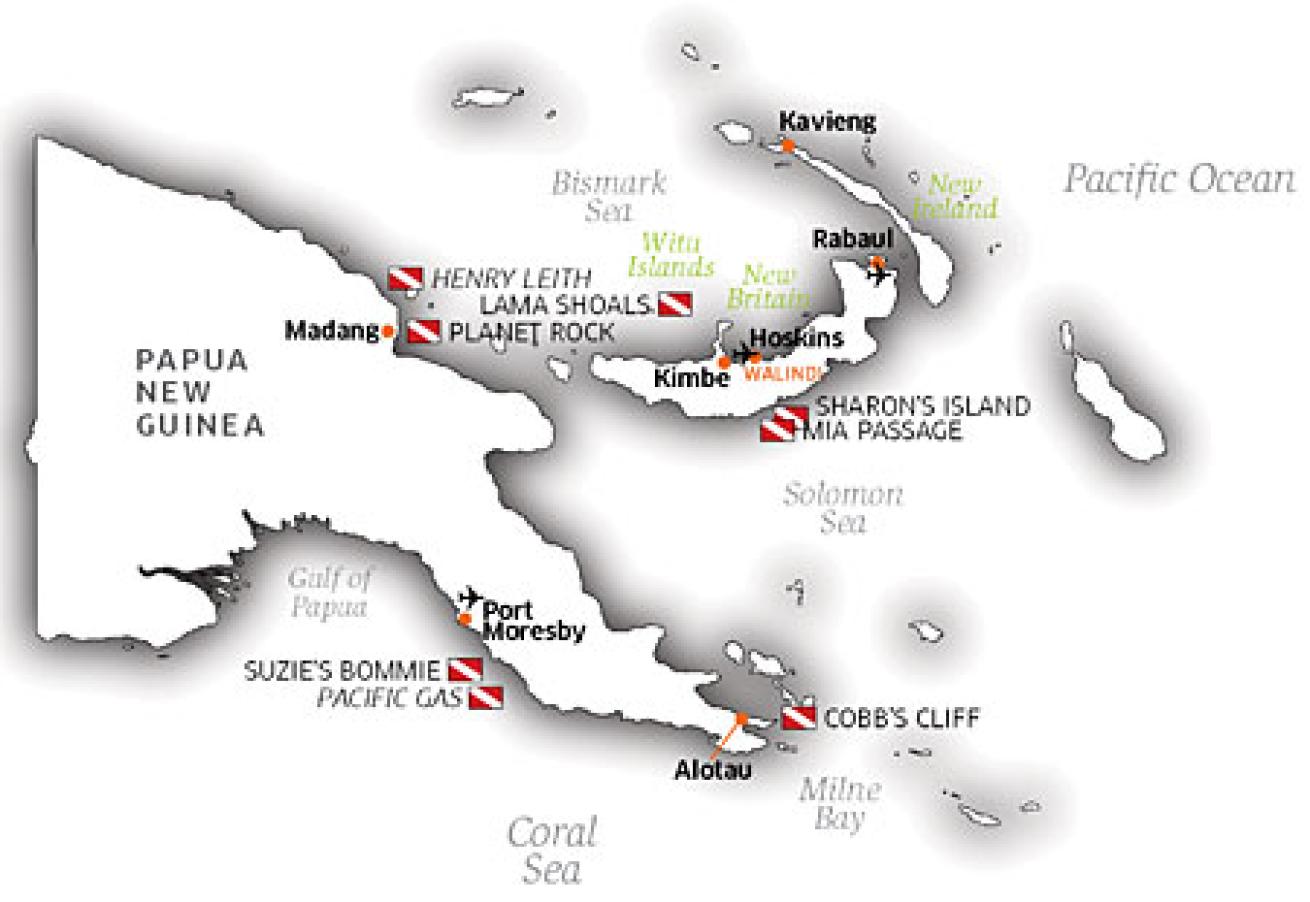
|
Weather: Tropical year-round with temps in the mid- to high 80s.
Money Matters: Seven-night packages, including accommodation, meals and diving, run about $1,900 p.p., dbl. occ. Seven-night live-aboard cruises run about $2,300 p.p., dbl. occ. Currency is the kina (PGK); exchange rate fluctuates. Departure tax is usually included in airline ticket prices.
Get More: scubadiving.com/travel/pacificandindianoceans/papua_new_guinea
Getting There: Port Moresby (POM) is the international gateway--and a long haul from North America. Australian national carrier Qantas flies nonstop between Los Angeles and Brisbane (BNE) and from there offers nonstops to Port Moresby, as do Air Niugini and Airlines PNG. But flying first to Tokyo (NRT) on Japan, American or Northwest Airlines and then flying Air Niugini nonstop to Port Moresby may prove to be a wiser shortcut. From Port Moresby, Air Niugini serves Hoskins (HKN), Rabaul (RAB), Madang (MAG) and Kavieng (KVG). Gurney (GUR) is the closest airport to Alotau. Local dive pros warn against booking connections too soon after an international flight, to avoid losing luggage.






